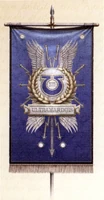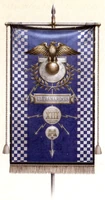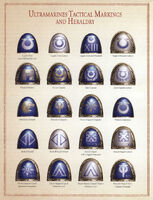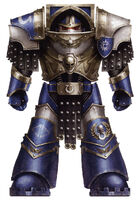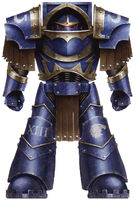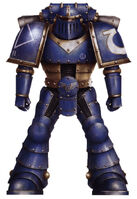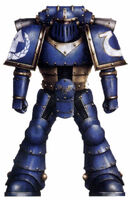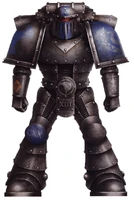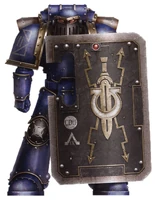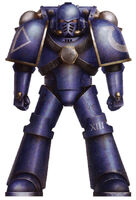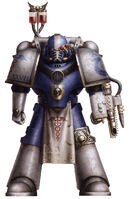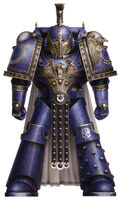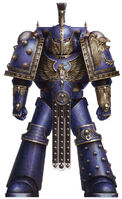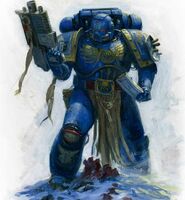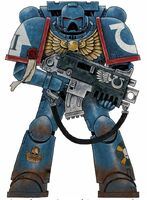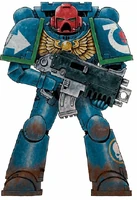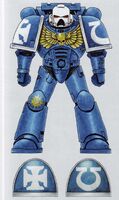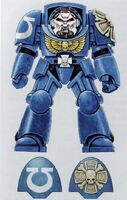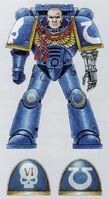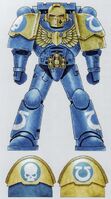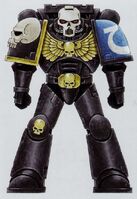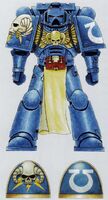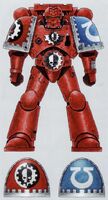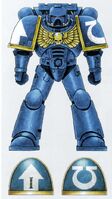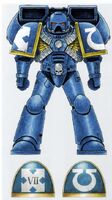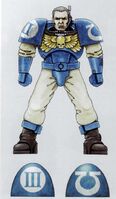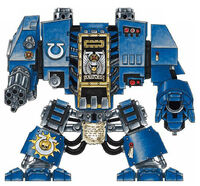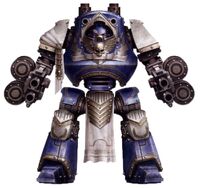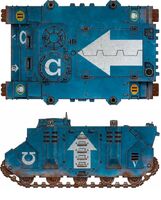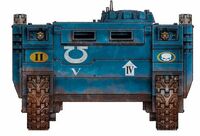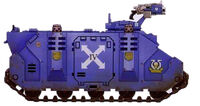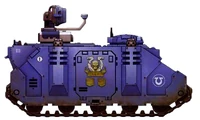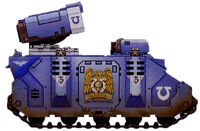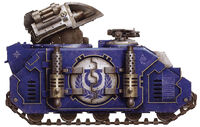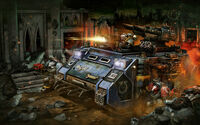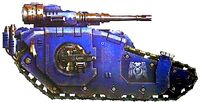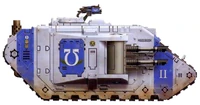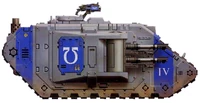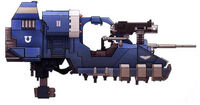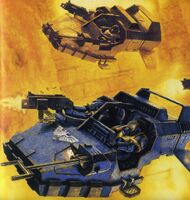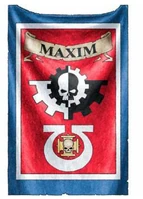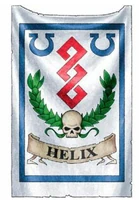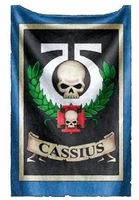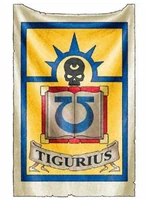"We are the Ultramarines, the sons of Guilliman. Whilst we draw breath, we stand. Whilst we stand, we fight. Whilst we fight, we prevail. Nothing shall stay our wrath."
- — Marneus Calgar, Chapter Master of the Ultramarines
The Ultramarines are considered one of the strongest and most honoured of all the Space Marine Chapters in the Imperium of Man, and were responsible for almost single-handedly holding the Imperium together after the Horus Heresy. Highly disciplined and courageous warriors, the Ultramarines have remained true to the teachings of their Primarch Roboute Guilliman for 10,000 standard years. The Ultramarines were originally the XIIIth Space Marine Legion before the reforms that initiated the Second Founding and reshaped the Imperium after the Heresy on the orders of Guilliman himself.
The name "Ultramarines" is a nod to both the Chapter's standing amongst the other Space Marine Chapters and their role as the source for the gene-seed of more Chapters of Astartes than any of the other former First Founding Legions combined. The culture of the Ultramarines is loosely themed upon the culture of Old Earth's ancient Roman Empire, as exemplified in their Astartes' pseudo-Latin names and their strict adherence to the Codex Astartes, as well as the society of their homeworld of Macragge and the Chapter's method of recruitment. The Ultramarines directly rule the sector of space in the Eastern Fringe known as Ultramar as a fief of the Imperium and their Chapter Master is also considered the Lord of Macragge and the Master of Ultramar.
Chapter History
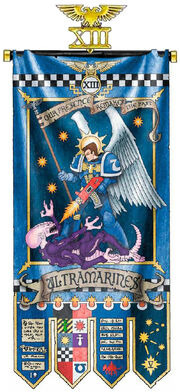
Ultramarines Chapter Banner

Ultramarines Legion Banner

Ultramarines Chapter Colour Scheme

Pre-Heresy Ultramarines Legion Colour Scheme

Pre-Heresy Ultramarines Legion Terminator

A Post-Heresy Ultramarines Chapter Terminator
At the outset of the cataclysmic civil war created by the treachery of Horus and the machinations of the dark powers of the Warp, the XIIIth Legion, the Ultramarines, stood as one of the single, most powerful military forces in the Imperium. With an active fighting strength somewhere in the region of a quarter of a million Legiones Astartes, a sector-spanning domain under their overlordship and an arguably unparalleled structure for the supply and training of initiates -- allowing it to withstand losses that would potentially cripple other Legions -- it was this very strength that would make it a prime target for the Traitors' conspiracy. It would be at Calth that this blow would fall. But while the legend of the lapis-blue hosts of Ultramar and the strategic genius of its Primarch Roboute Guilliman were already widely promulgated by the Iterators and Remembrancers of the Great Crusade, the path by which it arrived at this apotheosis of power was not so well known and in some cases, the facts actively kept secret. The complexities of the Legion's past and the sometimes divisive and even antagonistic relationship the Ultramarines had with several of their fellow Legions was also concealed. It would be this hidden history that was to bear bitter fruit on Calth and cast its shadow on the wars that were to follow.
Origins: The War-Born of Old Night
The XIIIth Legion's origin lay, as with their fellows, on Terra and the closing years of the Unification Wars. Extant records from this time show the XIIIth Legion's "Alpha" intake -- the test bed raising of several thousand warriors by which its gene-seed's stability and adaptability was judged -- was passed firmly within acceptable parameters and with no singular or notable physical mutation beyond the expected pattern, with fully functionality of implanted organs to projected specifications. Psycho-organically, initiates were noted to display increased aggression, as was expected, but also a marked tendency towards cohesion and the adoption of hierarchy, alongside an almost pathological dedication to the achievement of an assigned goal, particularly when compared against the psychological profiles of certain other alpha samples such as those of the XIIth and Vth (later known as the World Eaters and White Scars respectively) groups, who demonstrated more markedly heightened individualistic and fractious tendencies post-implantation. Although much of what would then transpire for the XIIIth Legion's very early expansion past its test stage has been occluded by layers of the unbreachable secrecy inherent in much of the Emperor's gene-work, and records lost in the destruction caused on Terra during the great siege during the Battle of Terra, certain facts can still be pieced together and a hypothesis formed.
In terms of recruitment, evidence is apparent for a net being cast across Terra for initiates for the XIIIth, with intake from areas as diverse as the sub-equatorial maglev clans of Panpocro, the war families of the Saragon Enclave, the proud Midafrik Hive Oligarchy and, most latterly, the anthropophagic tribes of the Caucasus Wastes. As varied in culture and origin as these groups were, they all had one factor in common; their violent and often bitter resistance to the later stages of Unification, a resistance broken ultimately in each case not by negotiated surrender but near annihilation, with, in some situations, little remaining save interned refugees and orphaned populations left by the savage conflicts which had brought these peoples to heel. It was this which led to the first informal cognomen by which the XIIIth Legion was known by the forces alongside which they served -- "the War-born". It may then be theorised that the particular psychological effects of the XIIIth Legion's gene-seed may have been used deliberately as a final weapon of the Unification to bleed away potential rebellion on Terra, and also further absorb the strength of the savage tribes of Old Night into the fledging Imperium. Further evidence for this can be perhaps inferred by the fact that no evidence remains of the XIIIth Legion seeing active deployment on Terra itself during the Unification Wars' bitter dregs -- as both the VIIth and VIIIth (later known as the Imperial Fists and Night Lords Legions) early incarnations were, for example -- with their first full battle honours recorded as being for the First Pacification of Luna, and the brutal Sedna Campaign at the edge of the Sol System.
As the earliest phase of the Great Crusade, the liberation of the Segmentum Solar, progressed, it was discovered that this ancient and most heavily settled region of the first stellar domains of humanity held many survivors from the Dark Age of Technology. Of these there were some who openly welcomed the Imperium as patron and protector, but there were also many worlds who resisted Compliance, either through ignorance or prideful assurance in their own strength, just as there were others who were enslaved under the yoke of xenos oppression. The tide of conquest however, with the Emperor at the head of the war effort, quickly gained rapid momentum, and the fledging Space Marine Legions undergoing their first great expansion were a key part of this. During this period the XIIIth, then around 8,000 strong, began to make its mark by taking part alongside other Legions under the Emepror's direct generalship, gaining renown in notable campaigns such as the Liberation of Diurnus and the destruction of the Scorvidian xeno-empire, as well as amassing a string of successful Compliance actions in solo operations on planets such as Lorin Sigma, Sekel's Landing and Ne'deble. From each of these conquered human worlds, the most militant factions provided additional intakes of recruits tithed for the XIIIth, much as the war-born sons of Terra had infused their first intake.
It was during this early period of the Great Crusade that the genius of the Emperor's grand design for His Space Marine Legions became increasingly apparent. While each of his superhuman cadres proved itself able to fight on any battlefield and achieve victory, the Emperor had clearly patterned in the alchemical mix of His sons a diversity of tempers and abilities that had given each Legion a strength or suitability to a theatre of war of its own beyond that of its peers. In some cases these talents were atavistic and visible, be they the near preternatural fury already being displayed by the IXth Legion (Blood Angels) or the uncanny resilience of the XIVth (Death Guard). In others they were subtle and bred in the bone, such as the oppressive darkness which consumed the souls of the VIIIth, and they could manifest in word and deed to the ruin of their foes, or they unyielding, cold passion and technological aptitude of what was already becoming known as the "Iron Tenth" (Iron Hands). It was into this latter category which the XIIIth fell.
In them was found a mixture of aggression and restraint, discipline and determination which rendered them supremely suited for joint taskforce operations and cross-theatre warfare. The Legion also gained significant success in independence operations where it took direct command of secondary support forces of the Imperialis Auxilia, whether the professional and elite regiments of the Solar Auxilia and the regiments of the "Old One Hundred", or the often resentful and fractious hosts of Imperialis Militia auxiliary recently forced into Compliance. In the latter case, the XIIIth Legion often detached cadres of its own warriors to act as provosts and disciplinarians if needed, handing out final justice to the recalcitrant and inspiring bravery from the front lines; duties at which many other Legions baulked at as beneath their honour or as a poor use of Legiones Astartes in battle.
In their adaptability and range of operations, they were said to be reminiscent of the vaunted Ist Legion (Dark Angels) and the prominent Luna Wolves on whose glory and accomplishments, since that Legion's early restoration of its Primarch, much has already been made. The key to their fighting style was imitation and adaptation. Their own arts of war had evolved quickly from the tenets laid out during their indoctrination and training, becoming combined with influences drawn from the host of martial cultures from which they were founded and the other Legions alongside which they served, from the knife-craft of the Opaki gangs of Hive Kôr to the armoured warfare tactics of the Xth Legion.
The Brotherhood of the Thirteenth
By the third decade of the Great Crusade, the XIIIth Legion had begun to develop a distinct character of their own. They were recorded as having a practical and and forthright mien, with little time given to the esoteric arts of warfare or conjectural strategising, preferring a direct approach of swift engagement. In warfare, they relied upon the rapid attainment of quickly defined tactical objectives and strategies born of tried and tested battlefield experience and determined by the situation at hand. They also had their pride, and while they were accorded as being unwaveringly loyal to the Imperium's cause, they developed a tendency to guard their honour well and engaged in an open rivalry of achievement with the other Legions alongside which they served, particularly those few whose Primarchs had already been recovered. The warrior brotherhood of the XIIIth had also, in recent years, begun to display its achievement visually. But rather than take on a particular livery and iconography as whole as the IIIrd (Emperor's Children) or the XIVth Legion (at that time still the Dusk Raiders) had, indiviual companies who had come to prominence in a particularly important Compliance operation or campaign took on additions to their core Legion livery -- which maintained the post-Unification storm grey and gunmetal they had worn since Sedna -- to commemorate their greatest achievements. Those companies who had fought alongside the VIIIth in the purgation of the abhuman corsairs of the Cancerai Nebula afterwards bore black gauntlets, midnight blue helms and the ancient weighing scales and death's head icon of judgement in heraldic opposition of their Legion numeral, and took the name of "Nemesis" as their own. Conversely, the principally armoured formations of the XIIIth who had halted the Ork advance on the ash plains of Cypra Mundi, and in doing so had saved a city of millions from a savage death, afterwards commemorated the battle by mirroring on their right pauldron the emerald light of the blazing armour borealis that had riven the skies under which they had fought. Such honours were claimed as the Legion's strength made visible, but for them no formal name for the Legion as a whole was desired save for its number, as their first Lord Commander Gren Vosotho is recorded to have said, "...I am told that once the numeral thirteenth was taken as an ill omen by the weak minded and those enslaved by the lies of superstition, but in the Emperor's service we shall make it a byword for redemption and glory." The sorest test of the XIIIth's resolve and their arts of war was yet to come however.
The Osiris Rebellion
By the year 833.M30, the XIIIth Legion had increased in number to an active force of around 33,000 Space Marines, whose primary battlegroup now consisted of the autonomous 12th Expeditionary Fleet. This expansion of their number in a relatively short space of time had been due to two principal factors. The first was that their particular practical style of warfare had a tendency to avoid casualties where possible compared to the tactics employed by certain other Legions. The XIIIth avoided battles of attrition and prided themselves on achieving strategic goals with the minimum expenditure of life -- and where salvageable human worlds were involved, this desire was also extended to the minimisation of collateral damage. The second was a latterly revealed aspect of their gene-seed. While the rates of gene-seed implantation success for the XIIIth Legion's zygote type were very close to the median level, it had proved to be in the highest resistance band during extensive replication -- a meridian matched only by the Ist Legion's own core sample - suffering relatively little mutation or deviation in subsequent generation of harvested organs. This allowed the Legion to steadily expand its numbers, even without the stabilisation brought by a Primarch's own mature gene-code.
Such was the size, self-sufficiency and stability of the XIIIth Legion that while the Emperor, in command of the might of the Principia Imperialis war fleet, Ferrus Manus and his Iron Tenth, and Horus and his Luna Wolves respectively led the three main thrusts of the Great Crusade at this time, pushing on into the outer void far beyond the Segmentum Solar, the 12th Expeditionary Fleet was entrusted with the task of exploring the extent of the inner galactic disc and its densely packed star systems coreward of Terra. This was why when a secession crisis unexpectedly flared up close to the capitoline systems of the Segmentum Solar itself, the XIIIth Legion was the closest available Legion and the swiftest to respond.
The Osiris Cluster, a grouping of eleven star systems making up the inner portion of the Segmeentum Solar's second quadrant, had suddenly and without warning declared secession from the Imperium. Chartist merchant vessels had been seized, Imperialis Armada naval patrol squadrons fired upon and driven off by system defence ships, and agents of Imperial authority rendered silent and assumed dead. The inhabited worlds of the Osiris Cluster, many technologically advanced at contact, had originally come into Compliance during the Great Crusade's eighth year in relatively bloodless order. It had been viewed as a highly successful campaign in which the XIIIth itself had a hand. That the Osiris Cluster had now fallen into open rebellion was deemed an affront to the Legion's honour by its Lord Commander, Gren Vosotho, and the master of the XIIIth had vowed to bring the matter to a resolution as swiftly and emphatically as possible. Vosotho, acting on initial intelligence reports, ordered the warships of 12th Expeditionary Flee to proceed directly to the halo world of Septus XII, leaving behind the fleet's support elements, lumbering transports and forge ships guarded by its slower combat vessels. The target of this rapid strike force was to be the atmospherically-sealed city of Cabasset, located on the night-side of Septus XII, and the economic and political capital of the Osiris Cluster. A strike there before the rebels had time to consolidate their forces, Vosotho reasoned, might end the rebellion in a single, bloody stroke. Breaking into realspace in the outer system, the power of the 12th Expeditionary Fleet's two score of capital warships, led by the Legion's flagship, the Goliath-class macro-battleship Sethaln's Thunder, easily swept aside the system defence monitors and fireships sent out to intercept them. Immediately after the short firefight, in which the Space Marine ships sustained no losses, they engaged in a brief and equally successful long-range precision bombardment to defang Septus XIII's orbital defences, before moving to attack the planet itself. Vosotho had formulated a plan of attack based around a decapitation assault against the governmental and environmental control complexes on which all life in the hive city was dependant for survival. The strategy was a variation of a tried and proven tactic in part developed from close observation of the Luna Wolves' mastery of such attack forms, and which promised a quick resolution with the minimum of damage to the hive world's infrastructure and an object lesson in the futility of rebellion. The plan itself was predicated on detailed prior knowledge of the world as an Imperial holding and a military assessment of the potential numbers and capabilities of the rebellious militia forces the Legion was projected to encounter. Unfortunately, every assumption Vosotho and his command staff had made about what awaited the Legion was wrong.
The Attack on Septus XII
The attack began well enough, with the close support fire of the Sethaln's Thunder opening up great rents in Hive Cabasset's protective outer shell into which Vosotho personally led his Legion's Stormbirds to the attack. Resistance was immediately far heavier than expected as the landing force became swiftly bogged down in human waves made up of at first hundreds and soon thousands of dead-eyed civilians crudely stitched into makeshift pressure suits and armed with improvised weapons of every sort, not least among them explosive mining charges converted to suicide devices. The XIIIth quickly modified their tactics to inflict maximum attrition but, heedless of casualties, the tide of bodies pressed on in cold silence and it was quickly apparent that this was no mere rebellion and no ordinary enemy. Unwilling to allow his attack to be stalled and his invasion force surrounded, Vosotho called down reinforcements and ordered his attacking squads to press on, relying on speed and co-ordination, as well as the superiority of his Space Marines in close quarters, to carry the battle. Slowly and with steadily growing losses, the Legiones Astartes forced their way deeper into the hive city and one by one began to claim their tactical objectives, crushing better armed but equally vacant-minded opposition formed of what had once clearly been the bodyguard cadres of the hive's nobility. It was, when the XIIIth Legion was heavily committed and kilometres deep into the hive, that the trap was sprung. A xenos fleet of unknown type and origin, comprising five vast hourglass-shaped vessels whose structures turned and rotated ceaselessly like clockworks, appeared with great speed from within the fiery corona of Septus' giant star. Realising the disaster that was about to unfold, Vosotho called a general retreat from the surface, but as his forces battled to return to their gunships and transports, the assault on the Space Marines intensified as the nature of the attacks began to change.
While the waiting Stormbirds fell under concerted all-out attack in an attempt to cripple or destroy them, fresh mobs of grasping civilians poured from side-junctures and corridors, their intention not to kill but to overwhelm and pinion individual Legiones Astartes, drowning them in their mass of bodies, heedless of the cost of life. Above them in the void, the two fleets clashed. The great hourglass craft, each easily out-massing the gargantuan Sethaln's Thunder, lashed out with blazing whips of elemental particles, scorching and burning the Imperial warships and engulfing any fighter squadrons or torpedo salvos that came close in collapsing gravitational singularities, annihilating them utterly. The 12th Expeditionary Fleet was overmatched but fought on valiantly, causing one of the titanic xenos craft to fall back, strangely-coloured vapours bleeding luminously from its rent hull, but at the cost of a dozen of its own number, while the Sethaln's Thunder, at that point a burning wreck, tumbled out of control through the line of battle.
It was then that fearful figures, aglow from within with sickly light, began to materialise among the attackers both on the surface and directly onto the warring Imperial vessels. Armoured in some form of baroque bio-mechanical containment suits, the creatures within were barely corporal; ghoulish shapes of glowing mists whose gauntlets spat ethereal fire and whose alien wills reached out to crush the minds of those who resisted them. Vosotho's final command was for the fleet to withdraw with as many of the XIIIth Legion that could be recovered, but withdraw it must. A new enemy of the Imperium had been met, and word of it must reach Terra at any cost. Vosotho committed his life to the command of the rearguard on the surface, taking penance for his error, and his last act was to transfer Legion command to the most senior surviving commander present in orbit, Marius Gage. It was a testament to Gage's swift thinking and tactical acumen that he was able to hold off the enemy vessels until every surviving Stormbird from the ground assault had departed the planet, fighting a swirling three-dimensional battle of thrust, counter-thrust and retreat which held the enemy titan-ships at bay until the 12th Expeditionary Fleet had fought its way clear.
Ultimately, what could have been a disaster had been fought into a mere defeat, and when all was afterwards measured, the XIIIth Legion had suffered a little over 6,500 Space Marines lost, the largest tally of any single battle in the XIIIth's history. Although this was approximately a fifth of its fighting strength in terms of Astartes, the lost counted among them much of the elite of the Legion, many of them Terran veterans from its founding and its Lord Commander Gren Vosotho with them. Its fleet had also suffered heavily, with a quarter of its warships lost or irrevocably damaged, not least of all its flagship. Just as bitter a blow was to the Legion's pride and honour at the defeat to which their overconfidence had led them. They hungered for vengeance but even this was denied them.
When the XIIIth Legion returned to the now quarantined and blockaded Osirin Cluster a little under a standard year later with a force heavily augmented from the Solar Armada, elements of the XVIIIth Legion (Salamanders) and specialist anti-psyker cadres from Terra, of the xenoforms the Officio Biologis had designated with the cognomen of "Osiran Psybrid", they instead found worlds either left as wastelands of the unburied dead or locked in turmoil and civil strife. But of the architects of these atrocities they found no sign. Piecing together fragmentary records from planetary dataspheres and human minds alike all but purged clean, it was impossible to know from where the xenos had come or where they had gone, only that they had operated covertly at first, insidiously claiming worlds outright; burning out the wills of their populations, stealing away some bodily into the void, and leaving the others to simply mindlessly perish by starvation or inaction in their abscence. Other worlds they had sent first into rebellion and then strife through covert psychic domination of their rulers and manipulation of their population's fears. The revelation was of a foe perhaps not numerous, but both insidious and frighteningly powerful, a clear threat now marked for extermination by the Emperor's own writ.
In the wake of the short campaign, empty of glory, which brought the remains of the Osiris Cluster back into the Imperium's control for repopulation, the XIIIth swore a blood oath of vengeance against the xenos wherever and whenever they might appear again. The Legion, now under Marius Gage's stewardship, reorganised and sought to quickly replenish its numbers and supplies, and afterwards redoubled its effort in the Great Crusade's service, as if trying with each fresh victory to prove that the defeat at Septus had been an aberration never to be repeated, and the name of its lost master and indeed the battle in which he fell became a thing no longer spoken of but which dwelled as a shadow at their shoulders.
There existed within the Legion now a brooding sense of loss and a canker of doubt in its won abilities, and in the hearts of its Legionaries grew the desire, always present but now lent keen impetus, to reunite with their Primarch as a balm to all their ills, to become -- as they saw it -- whole. The dark irony was that more than two years previously, unknown and withheld from the Legion's knowledge and before the events at Septus, their Primarch had been located by the Emperor, but owing to the vagaries of the Warp, contact would not prove possible for several more years. During this period, brief as it was and yet seeming an eternity to the sons of the XIIIth, the Legion fought on with a relentless but joyless hunger for battle, taking world after world for the Great Crusade in rapid succession, but shunning now both the laurels of victory it once courted and the respect of its peers it once craved, until the hour of its salvation came at last.
The Son of Macragge
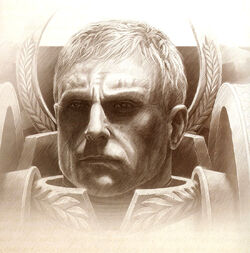
Ancient Remembrancer sketch from Carpinius' Speculum Historiale, depicting Roboute Guilliman, Primarch of the Ultramarines Legion, during the Great Crusade
Thanks to the widely distributed efforts of numerous Imperial Iterators, the story of the Primarch Roboute Guilliman, his early life and his finding is widely known and well accounted for, in stark contrast to certain others of the Primarchs. Much of these accounts have of course served the role of edification for the masses and the demands of propaganda, but between the accounts, variously embellished, a number of consistent facts and themes emerge. According to Imperial legend, the Emperor of Mankind created the Primarchs from artificially-engineered genes using his own genome as a template, carefully imbuing each of them with unique superhuman powers. Imperial doctrine goes on to tell how the Ruinous Powers of Chaos spirited away the Primarchs within their gestation capsules, scattering them widely across the galaxy through the Warp. More than one of the capsules was breached whilst it drifted through Warpspace - the forces of the Immaterium leaked in, wreaking havoc on the gestating being inside the capsule. Undoubtedly damage was done and Chaotic corruption affected several of the Primarchs, although the nature of that corruption would not become apparent until the Horus Heresy.
After drifting for decades, or in some cases even hundreds of years, the twenty gestation capsules came to rest on human-settled worlds throughout the Milky Way Galaxy - distant planets inhabited by a variety of human cultures, and whether by fickle fate or cruel design, each world would provide a crucible which would temper the child into the Primarch they would become, be that hero or monster, tyrant or liberator. The capsule containing the developing form of one Primarch fell upon the world of Macragge in the Eastern Fringe of the galaxy. Macragge was a bleak but no inhospitable world, part of a decayed star empire of ages past that Mankind had inhabited for many centuries since the time of the Dark Age of Technology. Its industries had survived intact, and its people had retained an authoritarian but cohesive society. It had remarkably preserved a number of antiquated short range Warp-capable craft which could be utilised for near-stellar transit -- conditions permitting -- and its people continued to build sub-light spacecraft even during the time of the most intense Warp Storms. This had allowed the people of Macragge to maintain contact with several neighbouring human-settled star systems, despite the storms' fury, and so retain a tenuous link to the rest of human space and the knowledge that it was not alone in the darkness.
So it was that when the Primarch's fallen capsule was discovered by a group of magnates who were on a hunt in a local forest, they knew it immediately for a device of advanced technology rather than a thing of superstition and magic. The magnates broke the capsule's seal and discovered a strikingly beautiful and perfectly formed child within it who was surrounded by a glowing nimbus of power. The child was brought before Konor Guilliman, one of a pair of nobles who bore the title "consul", whose authority governed the most civilised and powerful region of Macragge, and Konor adopted the infant as his own son in a manner not uncommon to his culture, naming him Roboute.
The young Primarch grew unnaturally quickly and as he did so, his unique physical and mental powers became obvious to all. It is recorded that by the time of his tenth birthday, Guilliman had mastered everything the wisest tutors of Macragge could teach him. His insight into matters of history, philosophy and science astonished his teachers, while his recall was absolute and his ability to extrapolate accurate conclusions from fragmentary information was said to border on the inexplicable. His greatest talent, however, lay in the art of war, which was itself treated as a high and lauded science in Macragge's culture. As soon as he had attended his legal majority, Roboute's foster-father Konor immediately granted him command over an expeditionary force sent to pacify the far northern lands of Macragge. Name Illyrium, it was a barbarous land of outcasts and petty, warring micro-states that had long harboured brigands and mercenaries who raided more civilised lands as often as they hired themselves as foot soldiers to fight their neighbours' wars. Roboute fought a brilliant campaign and won both the submission and the respect of the fierce Illyrium warrior bands, but when he returned to his home from the northern frontier, Roboute found the capital of Macragge Civitas in turmoil.
The Death of Konor
During Robout's absence, Konor Guilliman's co-consul, a man named Gallan, had unleashed a coup d'etat against Konor -- a development far from unknown historically, if in this instance a surprise. Gallan, it transpired, had long harboured designs on undiluted rulership and had conspired with those amongst the wealthy nobility of Macragge who were jealous of Konor's political power and popularity, and also increasingly afraid of his preternaturally precocious foster child's future. These malcontents represented Macragge's ancient regime, an aristocracy whose wealth was manifested by vast estates which were supported by the toiling of a multitude of impoverished vassals. Konor, backed by Macragge's industrial magnates -- rivals to the old regime -- had moved to challenge this balance of power, forcing the aristocracy of Macragge to provide their vassals with increased living standards and rights before the law, weakening the aristocracy's stranglehold on the polity. Konor had also passed legislation that obliged the nobility of Macragge to begin an ambitious programme of improving the long neglected infrastructure of their nation and enlarging the capital city at their own expense. These reforms made Konor Guilliman all but unassailable in the common people's eyes, but were highly unpopular among all but a few of the more far-sighted aristocrats.
As Roboute Guilliman and his triumphant army approached the city of Macragge Civitas, they saw the smoke from a multitude of fires and encountered citizens fleeing from the city in anarchy, and Roboute learned that Gallan's private army had attacked the senate house while Konor and his loyal bodyguard troops had been inside. The refugees each told the same story; that rebel soldiers had attacked the senate, whilst a drunken mob, instigated by Gallan but now out of anybody's control, roamed the city burning, looting and murdering. Roboute hurried to his foster father's rescue. Leaving his own troops to deal with the drunken rioters without quarter, Roboute personally fought his way towards the centre of the city, passing the bloody work of rebel firing squads everywhere in the government district, but at the senate house, found himself too late. All was a bullet-ridden and blasted ruin, and even the rebels it seemed had fled the scene to join the looking. There, in the half-collapsed shelters beneath the building, he found his father dying. For three days the wounded Counsul had directed the defence of the besieged senate house, even as surgeons fought for his life following a botched assassination attempt on the senate floor which had touched off the conspiracy's chaotic attack. It is apocryphally said that as he gasped out his last breath, Konor detailed the extent of Gallan's betrayal to his beloved foster son and named those whose hands were stained with his blood.
Roboute Guilliman's cold rage at his foster father's death was unstoppable. With the full backing of his army and the beleaguered citizens of Macragge Civitas, Roboute crushed the aristocratic rebels, scattering their hireling armies and lined the streets with the hanging bodies of the rioters, thereby quickly restoring order to the capital city and the surrounding lands. Thousands of citizens flocked to the senate house and amidst a wave of popular acclaim, Roboute assumed the mantle of the sole and now all-powerful Consul of Macragge. The new ruler broke the old, aristocratic order and stripped from them their lands and titles. Gallan and his fellow conspirators were seized, the ring leaders publicly executed and the rest sentenced to hard labour rebuilding the city they had ruined, stone by stone, by hand. It was not a sentence they would long survive. In the new order, loyal soldiers and hardworking settlers were granted rights where the oppressive aristocracy had once held sway. With super-human energy and the singularity of vision only a Primarch was capable of executing, the new Consul reorganised the social order of Macragge, creating a ruthlessly enforced meritocracy where the hardworking prospered and the honourable received positions of high office, and those who shirked the law or worked against the good of the whole faced draconian, but faultlessly even-handed punishment. The stagnated and uneven economy was re-ordered, technology disseminated rather than horded by the elite, and the armed forces were transformed into a powerful and well-equipped force. Macragge flourished as never before -- one people and one order, united under the people and one order, united under the unchallengeable rule of Roboute Guilliman.
Ultramar
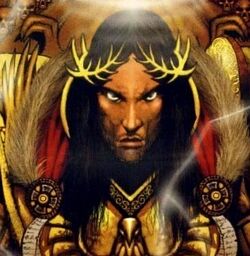
Around the time that the young Roboute Guilliman waged war in Illyria, the Emperor's fleet had reached the planet of Espandor at the outer edge of the network of worlds with which Macragge had maintained tenebrous contact. From the Espandorians the Emperor learned of the existence of Macragge and the extraordinary son of the Consul Konor Guilliman, and from what He learned He knew that this child could be none other than a missing Primarch. There have been some who have suggested that the Emperor's arrival at Espandor and the isolated region so far from the frontline of the Great Crusade's main spur of progress was no accident, and that by some arts He had perceived or had foreknowledge of what He would find. Regardless, what followed was certainly not foreseen. As the Emperor's fleet quickly moved on to Macragge, it was almost immediately deflected by violent warp squalls which had risen up to separate Macragge and a handful of nearby systems from approach. Thwarted by a power even the Emperor could not readily ignore, it would be something in the region of five standard years before contact could be successfully attempted.
In the years that intervened, Macragge had undergone a striking transformation. It was now a world of uniformity and order, prosperous and productive. Its cities had been rebuilt in glittering marble and shining steel, and the serried ranks of its armies were well armed and well equipped, and outfitting themselves now for operations beyond their own world. For even before the Emperor's arrival, Roboute Guilliman, it is said, had dwelt much on the ancient histories contained from his world's deposed aristocracy, and the fragments he found there telling of the ancient domains of Mankind, and he had begun to dream of new horizons and new worlds to conquer, of a domain "beyond the seas of night" or to use the ancient scholarly form found in the text -- "Ultramar". By his will, he made it so and within their warp-sealed enclave, vessels from Macragge now plied regular and well-patrolled trade routes with local star systems, bringing raw materials and people to the flourishing world, while against some of its neighbours, short, victorious conflicts had already been waged to pacify the strife they had found there. It is said that when the Emperor saw what His lost son had wrought, He was indeed pleased, and that He met with Roboute Guilliman without the dissembling that had been needed with those Primarchs He had found of more savage timbre. It is further more recorded that once Guilliman learned the truth of his origins, he immediately swore his fealty to the Emperor, who he knew was his true father, for he had already theorised correctly the purpose for which he had not been born so much as deliberately created. It was immediately apparent to Imperial observers that Roboute Guilliman possessed a powerful analytical intelligence, even when compared to the superhuman cognitive abilities of his peers, as well as talent for statecraft and macro-organisation of staggering potential. Yet few could then guess what such talents harnessed to the Great Crusade would go on to achieve.
The Unification of Body and Soul
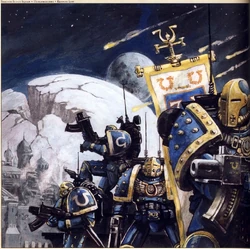
Ultramarines Scout Marines Squad scouting for the enemy during the Great Crusade
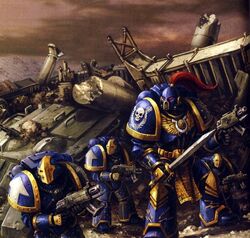
A Tactical Squad roves the battlefield for more foes
The XIIIth Legion of Space Marines was assigned to Guilliman in short order, for the Primarch needed little urging or aid in the assimilation of knowledge of the wider galaxy, the Great Crusade and the many technological wonders of the new-born Imperium of Man. It was a development greeted by the XIIIth with great rejoicing and pride in the honour that Roboute Guilliman paid them in accepting their fealty. The oratory and vision with which their new-found Primarch expounded to them his designs for the future and the righteousness of the Great Crusade filled the Legiones Astartes with a renewed vigiour and dispelled any shadows of doubt in their minds, and made Guilliman's takeover, according to official records, all but seamless.
Roboute Guilliman did far more than merely take command of the XIIIth Legion, he set about transforming it. His vision was for a Legion that was more than simply one army among many, however exceptional, but a self-sustaining power for conquest, order and expansion; the strength of the body and blood of the Imperium made manifest by the will of the Emperor through His servant Roboute Guilliman. To him, a military force was more than the warriors who wielded arms -- it was their chain of supply, the ships which carried them between, the manufactora which supplied their munitions and the worlds which bred their recruits; they were indivisible and equally vital. To Guilliman's mind, all of these things made a Space Marine Legion, and he meant to control them all so that his own would prosper and the Emperor's will be done.
In accordance with his grand design, he planned to not merely take the world of his fosterage as his headquarters and recruiting ground as his peers had done and would continue to do, but from the start set it up as merely the fulcrum of a far larger network of provender and support. The basis of this network would be the worlds Macragge had long maintained links with, but they would merely be its first components, not its fullest extent. This would be the start of Roboute Guilliman's "Ultramar" and it would be a project of decades, and continue to expand right up to the first treacherous blow of the Horus Heresy.
The Eagle of the East
As swiftly as he put his plans for Ultramar into action, he embarked on the root and branch reorganisation of his Legion. Adopting an extraordinarily detailed plan which drew from both the military doctrines and political philosophies of his surrogate home world, a detailed study of the history of the XIIIth and each and every other Legion and armed force under the Emperor's banner in their then current form, he remade the organisational structure and tactical doctrines of his Legion accordingly.
The result was an elegantly structured but elaborate and highly meritocratic force. It unsurprisingly built on much that had already been evident in the character of the XIIIth Legion, as their Primarch's gene-seed had already partly shaped them, however unconsciously, and through the application of analysis and reason sought to purge any weaknesses or deficiences to achieve the optimal military outcome. This, as with so much of the Legion's affairs, was considered by the Primarch an ongoing project, and it evolved quickly into a dual doctrine which embraced in parallel on one hand what were the ancient and deterministic values of the warrior: courage, discipline, skill and adaptability, defined as that which was "practical", and on the other: planning, precedent, analysis and assessment, defined as that which was "theoretical". Both were of equal weight and value, one complementing and informing the other, blending together as the metals which made a fine blade. This became the Legion's doctrine and creed. As with the society Roboute Guilliman had built on Macragge, the XIIIth Legion under his mastery would be as ruthlessly even-handed as it was efficient, with the needs of the individual sublimated to the greater whole, but the life of the individual never spent wantonly or without purpose; for the doctrine stated that each Legionary lost weakened those who remained. Within the Legion, the valour and the achievement of the individual were rewarded with honour and responsibility, but the obedience to hierarchy and order it demanded of its members was to be unquestioning and unchallenged. The outward signs of this transformation were striking, the livery of the XIIIth was altered to a deep blue, chased with gold, while the symbol of the ancient "Ultima" glyph found in the pre-isolation stellar charts of the region was adopted as its icon and seal to tie them to the newfound realm which they embodied, and with it the cognomen "Ultramarines", perhaps as one monography attributed to Remembrancer L. Amphidal suggested, "Roboute Guilliman and his Legion would vow to take the Great Crusade beyond the stars themselves if needed to see its completion."
The Pattern of Empire

Ultramarines Primarch Roboute Guilliman during the Great Crusade
With its forward base relocated to Macragge, Guilliman was granted independent Crusade command for the region, and quickly set about a series of fresh conquests. His 12th Expeditionary Fleet reformed under his command and supplied with warships of the latest designs from Mars as a boon of the Emperor. Fresh conquests were immediate, as the newly named Ultramarines rapidly expanded their range out from Macragge, identifying suitable targets for Compliance and singling out xenos holds for eradication. Interrupted only when called upon to join larger campaigns by the will of the Emperor, for nearly a century the 12th Expeditionary Fleet ranged as far to the galactic north as the dead expanse where the Dominion of Storms ended and as far to the galactic east and south as the point of Ultima Thule, where the stars paled and emptied out into the limitless darkness of the exo-galactic void.
During this period, the Ultramarines, by some records, succeeded in liberating more worlds than any other single Primarch's forces, and the planets Roboute Guilliman brought within the Imperium always benefitted from his intense passion for efficient and ordered government. Whenever Guilliman and the Ultramarines made a world compliant, his forces spent as much effort in establishing it afresh, setting up self-supporting defences, and ensuring that in his wake, the agents of the Imperial Truth and industry would firmly seal the world's place in the fabric of the Imperium. This spread of cohesive civilisation in the Legion's path served both to solidify and expand supply lines for its advance, facilitating in no small part the great speed and range of the Ultramarines' conquests.
As inexorably as its tally of victories multiplied, the Ultramarines Legion's numbers began also to grow. Even before its reunification with its Primarch, the XIIIth Legion had been mindful of its losses and demonstrated its ability to expand steadily thanks to the resilience of its gene-seed during multi-generational replication. But with its Primarch's vision to guide it, his organisational skill and his own genetic material available to further strengthen the Legion's gene-stocks, the resultant expansion was meteoric, perhaps beyond anyone's -- even the Emperor's -- expectations. Within months of the Legion's establishment on Macragge, the first influx of new recruits had arrived at the Fortress of Hera, the Legion's fortress-monastery and new headquarters, and the process of renewal and increase in the XIIIth Legion's fighting strength had begun and never since had ceased. Wave after wave of recruits were taken in and processed, not simply from Macragge and the surrounding worlds of the slowly expanding Ultramar, as numerous as they were, but from scores of worlds and colony outposts where the conquering fleets of Roboute Guilliman had gone. The process was meritocratic and exacting; only the strongest and most able candidates were selected, chosen for both desired physical and mental attributes, but the net was flung so wide that the intake dwarfed that of any other single Legion. This, coupled with the Ultramrines' resistance to what they saw as the "waste" of attrition warfare, created a kind of amplification effect in practice where the larger the Legion used in a single Compliance action, the more force was brought to bear and the fewer the casualties taken. Where this was not the case -- and there remained many hard battles fought by the Ultramarines against hideously powerful foes such as savage Ork empires, the Tanaril and other nightmarish xenoforms -- and heavy losses were inevitably suffered, the Legion's sheer size and its huge capacity to renew itself with more recruits offered it formidable resilience, and such losses were almost invariably replaced within a few years.
By the time Horus was appointed Warmaster, the Ultramarines were by any official assessment the largest single Space Marine Legion by number of Legionaries with a considerable margin. Owing to this expansion, the now massive 12th Expeditionary Fleet was sub-divided into a score of smaller Expeditionary and Persecution fleets, allowing the Legion to range further, each still numbering scores of vessels and thousands and sometimes tens of thousands of Legionaries. The numeric strength of the Ultramarines Legion, in excess of 250,000 Astartes, would be an achievement that would not be surpassed, though in secrecy the late expansion of the Word Bearers, who originally numbered approximately 100,000 Astartes, would come to rival them by some assessments, while the wilder claims as to the strength of the Alpha Legion also have them run closer than official records would indicate.
This scale of military force and the near autonomous "empire within an empire" that maintained it, Ultramar having reached a dominion popularly ascribed as the Five Hundred Worlds before the outbreak of war, would have dire and unforeseen consequences for the Ultramarines and their Primarch. Separate and inviolate in the east, and a great power within their own right, the Legion's very existence made them a threat to the Traitor's conspiracy that could not be ignored, and on Calth would the Warmaster's plan and the Word Bearer's desire for revenge see that threat destroyed.
The Debt of Vengeance
Since his takeover of the Legion in the fourth decade of the Great Crusade, Roboute Guilliman had succeeded in transforming the XIIIth into an intricate and highly functioning weapon of war, and in doing so had built upon a track records of success in battle which held very few stains of defeat. Fore more than half a century the Legion had gone from strength to strength, waging Compliance actions and liberating worlds for the Imperium across the eastern reaches of the galaxy, and forging the realm of Ultramar in the process. Though not yet having reached the decisive numerical superiority of the other Legions, it would manifest by the time of the Horus Heresy, yet the Ultramarines of 899.M30 were perhaps on the cusp of becoming so, as their ranks, then at around approximately 166,000 Legionaries, stood them in the forefront of their peers. The Dark Angels, who in the previous decade to this had been undoubtedly the most powerful single Legion, had fallen in number and evened this figure, having suffered massive casualties holding the line during the famed Third Rangdan Xenocide, the blood 50,000 Space Marines spent in preventing the destruction of perhaps the entire northern Imperium by the menace from the outer darkness. The Ultramarines in contrast had spent decades in building up their forces and expanding the frontiers in the east, having had the advantage of their excellent network of supply and recruitment, and their Primarch's formidable generalship was at a zenith of its strength thus far.
Yet for all this, Roboute Guilliman knew that a shadow of doubt afflicted his Legion's soul. That doubt had its origins in its darkly storied defeat in the Osiris Cluster Rebllion a few short years before the Primarch's reunion with his Legion. Marius Gage's tenure in command had commenced with this disaster, and it became a baleful influence in the psyche of the Legion, a thing which while left unspoken nevertheless had power, and that even seemed to cast a pall over the Legion's recruits unborn when the battle was lost. The Primarch knew that the only way to purge his Legion of this shadow of the mind was to find once more the xenos known as the Osirian Psybrids, and with the Ultramarines at his back, destroy them utterly. To this end, ever since he had first reviewed reports of the action when he took over his Legion, Roboute Guilliman had begun planning the Psybrids' destruction, analysing and re-analysing every facet of the Legion's battle-logs, gun-picter footage and even the deep auspex data gathered from the aetheric cogitators of the warships that had survived for microscopic fluctuations. In the decades as his Legion had gone from Compliance to Compliance, war zone to war zone, the Primarch had never stopped running continued theoretical battle scenarios against the macabre and powerful xenos, knowing that one day they would make their reappearance and that he and his Legion would be waiting. But decades passed and they did not return.
There had been rumours of course, unsubstantiated accounts passed on from frontier Rogue Traders, intermittent reports of inexplicable massacres and mass disappearances, but the galaxy, even within the fold of the growing Imperium, was a strange and dangerous place, and the evidence was seldom conclusive as to the culprit, or pointed to the more commonplace is no less deadly privations of several known xenos species. Only at Maxilla Veritas near the Maelstrom, twenty-six standard years after the Osiris Rebellion, was the evidence for the Psybrids involvement considered viable. But by the time fast cruisers from the Ultramarines fleet arrived, the trail was already long cold and the planet's death bore silent witness to the Psybrids' passing. It was in the closing segments of 899.M30 that conclusive word finally reached the Ultramarines Primarch that the Psybrids had not only been encountered, but met in battle. Relayed from the central Astrotelepathic chamber of Terra, the strange report had come from a sub-fleet of the XIIth Legion, then in its last days as the War Hounds before its own Primarch, Angron, was found.
The fleet, under the command of Praetor Erad Krüg, was fighting on the south-western extreme of the Great Crusade's frontier near Eurydice Terminal. Here the War Hounds had been engaged in repelling an attack on the frontier outpost world by Ork void raiders from the self-styled Glortian Empire from the untracked abysses beyond. The War Hounds, though severely outnumbered, had held off the repeated Ork attacks through a series of savage boarding actions in close orbit and high intensity assaults on their landing zones, preventing the xenos from gaining a foothold on the ground. It had been during the latest of these assaults, the largest yet attempted by the Orks, that a mysterious third party had attacked both sides.
When the Ultramarines retribution fleet arrived, not even the intellect of the Ultramarines Primarch could have predicted what his Legion would find there. The entire system had been sundered into a battleground littered with burning debris and the radioactive echo of heavy weapons fire. The Ultramarines found the last surviving few hundred Legionaries of the XIIth, the remnants of a force that had once been ten times its number, led by the terribly wounded but still commanding Erad Krüg. He detailed to Guilliman the story of a strange and terrible battle in which the Psybrids had managed through their mental powers to enslave a vast feral population of Orks to do battle for them against their own kind, and had sought to do the same to the Imperial defenders of Eurydice. Only the War Hounds had proved able to resist the creatures' baleful influence, but massively outnumbered they had paid for their resistance in blood, and would have been overwhelmed regardless if huge numbers of enraged Orks, seemingly the massed forces of the entire Glortian Empire, had not swarmed into the system.
During the ensuing battle, the Orks fought with unbelievable fury even given their warlike species' mien, compelled by their baleful masters to exterminate their enemies. More of the gargantuan hourglass ships in turn had appeared to reinforce their fellows, and with them thousands of enslaved xenos warriors and ships, few of which were known even to the lexicanic datacores of the Imperial ships. Eurydice Terminal had become a killing star; a vortex of destruction that was even now calling more armies to their deaths, and here the Ultramarines had come to restart the battle afresh. Guilliman, having apprised himself of the tactical situation, modified his battle plans accordingly and without pause put his strategy of attack into operation. Despite Erad Krüg's request for his surviving Legionaries to be lifted from their wrecked vessel and given a place in the line of battle, the War Hounds were denied; this would be a battle for the Ultramarines alone. It was to be a tactical operation more traditionally the specialty of other Space Marine Legions than his, but at which his own warriors were still well versed -- a full assault-strike boarding assault.
The Primarch's plan of attack was a shockingly direct one. His fleet didn't pause for a long range bombardment or present a broadside and pound the enemy at close quarters, instead, he ordered his Legion to conduct a full boarding strike without prelude. Guilliman drove the core of his fleet and with it nearly 100,000 Ultramarines into the heart of the enemy. It was not without irony that Roboute Guilliman records in his own testimony about the assault that he and his Legion were adverse to strategies which resulted in a heavy cost of Ultramarines' lives; this single action would dispel that myth and illustrate the truth that such tactics were often wasteful and unneeded by a skilled general, but when such sacrifice was the most efficient and indeed perhaps the only path to victory, he and his Legion would pay that price with fervour and unbreakable determination. The Ultramarines at last unleashed their wrath as they closed with the enemy vessels, hundreds of gunships and assault rams roaring from their flight bays to the attack as the Ultramarines fleet unleashed a cannonade of a thousand lance batteries and macro cannon. The Psybrid nomad-vessels lashed about them with frenzied whips of elemental energy, and all around them hulls burst and ships burned, but it was too little against the unstoppable tide of ire which crashed against them.
Through the maze-like networks of turning corridors like the innards of a great machine, the Ultramarines stormed with deadly intent, destroying as they went. Soon they encountered ghoulish, half-solid vapour forms, lean and gaunt without their exo-armour, who fought with the savagery of caged animals, burning bright with psychokinetic energy and striking out with mind-burning blasts of power, but for every Legionary who fell, a dozen pressed forward in their place and, one by one, the Psybrids began to be corralled, cornered and killed. Led by axe-and-shield-wielding Invictarii and moving bulwarks of Terminator Armour-clad veterans, the Ultramarines pressed into the heart of the great vessels, mining the corridors and power junctions with melta-bombs and atomantic implosion charges as they went. For the warriors of the XIIIth Legion were implacable, and in them had been woken a rarely displayed drive for vengeance that could not be diverted nor denied.
It was Roboute Guilliman himself who breached the innermost chamber of the largest of the hourglass ships to find the master of the Psybrids. It was a towering, multi-limbed gestalt-thing, thrice the Primarch's own height, whose long, almost equine head screamed out shockwaves of ceramite-breaking force as its inner sanctum was invaded. But even as his own Terminator armoured bodyguard staggered and fell under the psychokinetic onslaught, the Primarch, with his Chief Battle Psyker Aaroth Ptolemy beside him, charged. The Psybrid-King reared up above them, its clawed arms bearing strange weapons like the image of some forgotten devil-god of Old Night, but Guilliman with the strength and speed born of the Emperor's unmatched arts struck, cleaving the creature limb from vaporous limb as Ptolemy fought it on the psychic plane with every ounce of power in his possession, sacrificing his life so that Guilliman would be defended from the nightmarishly powerful creature's psychic assault. The monster fell and the Primarch of the Ultramarines enacted his Legion's vengeance, ripping the thing's glowing brain from its skull and crushing it under his heel.
One by one the towering hourglass vessels of the Osiran Psybrids fell, either torn apart by explosive charges from within, or rent to flinders in the crossfire of the waiting Ultramarines' echelons as they tried to break free. There was no escape. As the Psybrids died, so too did their slave armies still warring on the ground, and soon only the Glortian Orks, already mauled and all but exhausted, remained, and the Ultramarines made short work of driving them away once more into the outer darkness. The blood price of the battle had been high enough, several thousand Legionary casualties, and many among them veterans of his Legion's Terran roots, eager to be the first in battle in order to expunge the failing of the past. But it had been a price willingly paid for vengeance, and it would be a price and more that the Ultramarines Legion would willingly pay again in the future.
Triumph of Ullanor
In the latter years of the 30th Millennium, forces of the Imperium undertook the Ullanor Crusade, a vast Imperial assault on the Ork empire of the Overlord Urrlak Urruk. The capital world of this Greenskin stellar empire, and the site of the final assault by the Space Marine Legions, lay in the central Ullanor System of the galaxy's Ullanor Sector. The Crusade included the deployment of 100,000 Space Marines, 8,000,000 Imperial Army troops, and thousands of Imperial starships and their support personnel. The Ullanor Crusade marked the high point of the Great Crusade's vast effort to reunite the scattered colony worlds of humanity. The Orks of Ullanor represented the largest concentration of Greenskins ever defeated by the military forces of the Imperium of Man before the Third War for Armageddon began during the late 41st Millennium. Following the defeat of the Orks of Ullanor, the Emperor of Mankind was to return to Terra to begin work on His vast project to open up the Eldar Webway for Mankind's use. In His place to command the vast forces of the Great Crusade He left Horus. In the aftermath of the Ullanor Crusade, Horus was granted the newly-created title of "Warmaster", the commander-in-chief of all the Emperor’s armies who possessed command authority over all of the other Primarchs and every Expeditionary Fleet of the Great Crusade. When the Emperor proclaimed Horus, Warmaster of the Imperium, Guilliman accepted the news without resentment, and Horus continued to seek his counsel. However, Horus believed that Guilliman felt that he had deserved the honour of being named Warmaster just as much, if not more. Before returning to Terra to oversee the next phase of the creation of His stellar empire, the Emperor suggested to Horus that he rename the XVIth Legion the "Sons of Horus", in honour of their Primarch and to show his preeminent place amongst the other Primarchs. Horus initially declined this honour, not wishing to be set above his brothers, and so his Legion continued as the Luna Wolves for a little while longer. But Horus and the other Primarchs never came to terms with the Emperor's absence. Their hurt feelings over His seeming abandonment of the Great Crusade to pursue a secret project whose purpose He chose not to reveal to His sons laid the seeds of jealousy and resentment that would ultimately blossom into the corruption that began the Horus Heresy.
Horus Heresy
Battle of Calth
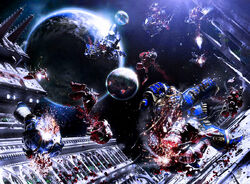
The Ultramarines face the Word Bearers in orbit at the start of the Battle of Calth

Ultramarines Assault Marines fighting a Word Bearers Cataphractii Terminator during the Battle of Calth
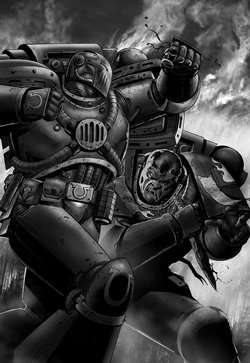
An Ultramarine Legionary fighting against a traitorous Word Bearer
When the Warmaster Horus turned his back on the Imperium, swore his allegiance to the Ruinous Powers of Chaos, and began the Horus Heresy, his first act before making his break with the Emperor of Mankind open was to lure away as many Loyalist Legions from Terra as possible. Horus ordered Guilliman to lead an expeditionary force to the world of Calth in the Veridian System in the Realm of Ultramar to prepare for a campaign in the Eastern Fringes of the galaxy, where, Horus claimed, an Ork WAAAGH! was massing. Horus expected the Ultramarines to await the arrival of the Word Bearers who would join with the XIIIth Legion in prosecuting a campaign against the Ork menace. Unknown to Guilliman, XVIIth Legion had long before turned Traitor in service to the Chaos Gods, and its Primarch, Lorgar, gleefully accepted Horus' orders to close the trap on his Legion's long-hated rivals. The Word Bearers' sudden attack decimated Guilliman's Legion fleet, and the Ultramarines' ground troops quickly found themselves impossibly outnumbered by their former allies as the infamous Battle of Calth erupted. The Word Bearers slew their Loyalist foes in droves in the early stages of their surprise attack and pushed them back over huge stretches of territory. The Traitors rejoiced at the terrible blows they were inflicting upon the Legion that had once aided the Emperor in humiliating them upon the world of Khur decades before the start of the Heresy when they had been taken to task for repeated violations of the atheistic philosophy known as the Imperial Truth. Unknown to them, Guilliman's flagship, which had survived the initial Word Bearers' attack on the Ultramarines fleet, effected emergency repairs and regrouped with the other surviving Ultramarine starships in space. Having taken stock of his remaining forces, Guilliman sent an immediate astropathic distress call to Macragge.
The Loyalist Marines on Calth, Ultramarines all, had been forced into a fighting retreat, but soon occupied fortified positions. Many Ultramarines had been born on Calth, and proved more resolute than the Word Bearers anticipated. In space, Guilliman's vessels began hit-and-run attacks on their over-confident enemy. Guilliman assessed his ground troops' positions and broadcast clear, concise orders to each pocket of defence, coordinating them into a cohesive force. One Ultramarine force led by Captain Ventanus led a breakout and retook Calth's Defence Laser silos, aiding the sorely-pressed Ultramarines fleet from the surface of Calth. Guilliman's depleted forces slowed the Word Bearers down long enough for the remainder of the Ultramarines Legion to arrive and rout the Traitor Marines from the system, though at a heavy cost. The Word Bearers turned Calth's own orbital defence platforms on the Veridian star, stripping away the outer layers of its photosphere and destabilising it, ultimately rendering the surface of Calth uninhabitable. At the same time, the Word Bearers had used the battle taking place on Calth to summon a massive Warp Storm called the Ruinstorm, that was intended to cut off Ultramar from the rest of the galaxy and prevent the Ultramarines from providing any reinforcements to Terra as Horus made his assault upon humanity's homeworld. The eruption of the Ruinstorm cut off Calth from the main body of the Ultramarines Legion and left the Astartes of the XIIIth Legion trapped on Calth locked in a brutal subterranean war with those Word Bearers units that had also been left behind when their Legion retreated from the Viridian System. Yet Roboute Guilliman and a large portion of his Legion had remained off-world as a result of the Word Bearers' devious assault upon the Ultramarines fleet. Bloodied but unbowed, the Ultramarines received the orders of Malcador the Sigillite, the Emperor's Regent, while he was in disposed pursuing the secret Imperial Webway Project, and prepared to meet the needs of the Imperium's defence against the Traitor Legions as best they could.
The Martyrs of Calth
In the aftermath of the fighting on Calth, it was all but impossible to form an accurate picture of the losses incurred on the combatants. With the surface of the planet rendered all but uninhabitable by the actions of Kor Phaeron, it has since proved impractical to recover many of the fallen or verify the deaths of those who came to Calth with treachery in their hearts.
The Ultramarines recorded their casualties at the moment when Guilliman and the remains of the XIIIth Legion fleet departed Calth at 119,422 Legiones Astartes fallen in combat, with a further 28,392 rendered combat-incapable by battle injuries and trauma. Few of the chapters committed to Calth could muster even a quarter of their nominal strength, and some were so decimated that they faced being reorganised into other chapters and their old designations removed from the XIIIth Legion's order of battle. Most of the injured were evacuated to the surviving craft of the fleet and swiftly returned to combat duties in the crisis that was unfolding across Ultramar, a crisis that forced Guilliman to order the prioritisation of military assets over the stranded civilians in the brief evacuation effort. Almost 40,000 Ultramarines, both wounded and combat-ready, were forced to remain on Calth, some as volunteers, set to the protection of those civilians who could not be evacuated, and others due to the brutal dictates of circumstance. Of the forces of the Excertus Imperialis, details are more vague, but it seems likely that at least half a million men-under-arms perished during the fighting, alongside the entire fighting complement of the Legio Praesagius.
Of the Word Bearers who landed on the surface of Calth, almost none would ever leave. It is estimated that 50,000 or more of Lorgar's sons and an uncounted mass of Auxilia troops were sacrificed in the battle, although only 20,000 are thought to have died in the initial fighting, with the remainder prosecuting the Underworld War on Calth for over a decade after the initial battle.
Just as bitter to the Ultramarines Legion was the damage inflicted on its fleet assets. Never renowned for the numbers of heavy combat void craft in its service, the losses suffered at Calth were crippling and hamstrung any effort to prosecute a war beyond the bounds of Ultramar. Such was the Ultramarines' desperation, missions to salvage the hulks drifting in orbit above Calth were quickly authorised despite the death toll such missions exacted in the deadly radiation of the Veridian star.
The Unmarked
Of the entire Legion, only five whole chapters of the Ultramarines and a handful of separate detachments from other chapters were spared the Mark of Calth. As with those Legiones Astartes of other Legions who had lived through the Istvaan massacres, an unspoken rift formed between the veterans of Calth and those who had not passed through the fires of betrayal. No official designation to mark the veterans of Calth was ever promulgated amongst the XIIIth Legion, nor did Guilliman ever sanction any division between the warriors of his Legion, yet on those occasions where the Ultramarines gathered afterwards in numbers, the survivors of Calth ever formed a separate body. The bitter wound of base betrayal was one they carried through all their days, the lasting legacy of the Word Bearers' assault on the worlds of Ultramar; trust came to them only with difficulty and always there was a hint of paranoia in their preparations for war and the execution of their campaigns.
Of the so-called "Unmarked" chapters, two had been assigned to distant Great Crusade forces at the time of the Calth atrocity; the 7th Chapter was divided amongst the vast reaches of the Dominion of Storms and the 10th Chapter was battling through the xenos-infested Eastern Fringe. The remaining chapters, the 19th as well as those which bore the title "Evocatii", the 24th and 25th had been assigned garrison and training duties amongst the myriad worlds of Ultramar. Though none escaped the fires of Horus' rebellion, none were tested as were those few who had stood against the unthinkable at Calth, none ever stood at the brink of annihilation and the edge of madness as did their brothers. In the later years of the Scouring, the Unmarked would continuously see assignment to operations removed from the main body of their brethren; even Guilliman seemed averse to their company on campaign, perhaps seeing in them a reminder of days now lost. Eventually, the Unmarked would be among the first of the Legion to be renamed and separated during the Second Founding, and remain perhaps the truest reflection of the Ultramarines of old.
Shadow Crusade
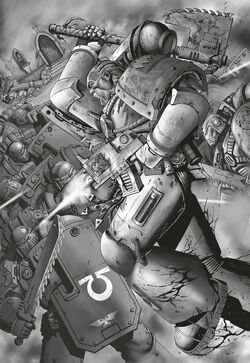
Ultramarines Evocatii bravely face the berserk fury of the World Eaters on Armatura
In his wrath at the outcome on Calth, the Lord of Ultramar had gathered what vessels he could spare after Kor Phaeron's ambush, drawn additional numbers from the first Ultramarines relief fleet bound for Calth after the massacre above that world, and tracked Lorgar directly through the use of the XIIIth Legion's own astropathic choirs. In the wake of the Battle of Calth, the Word Bearers Legion, led by Lorgar, linked up with Angron and his World Eaters Legion to launch a Shadow Crusade against the Realm of Ultramar's Five Hundred Worlds in an attempt to spread the massive Warp Storm known as the Ruinstorm that had been conjured by the Word Bearers' First Chaplain Erebus at Calth across the Eastern Fringe. This prodigious Warp Storm would effectively split the galaxy in half and deny needed reinforcements to the Loyalists as Horus drove on Terra in an attempt to overthrow the Emperor of Mankind.
The Shadow Crusade laid waste to 26 worlds until Guilliman's retribution fleet finally caught up to the Traitors upon Angron's homeworld of Nuceria, which the World Eaters Legion were preoccupied with wiping clean of all life in vengeance for the treatment the Nucerians had meted out a century before to Angron. The XIIIth Legion's warship Courage Above All, Guilliman's temporary flagship, broke Warp at the system’s edge, at the head of a large void armada consisting of 41 vessels. The Ultramarines armada looked wounded, cobbled together from separate fleets. It was not a dedicated interdiction war-fleet, but clearly a ragtag strike force, a lance thrust to the enemy’s heart. Guilliman himself had done the best he could with limited resources. The XIIIth Legion's Cruisers and Battleships ran abeam of the enemy fleet for repeated exchange of broadsides, offering targets too big and powerful to ignore, while the rest of the Ultramarines fleet used calculated Lance strikes from safer range. The armada then divided its assault potential, doing its utmost to destroy Lorgar's flagship Fidelitas Lex, and attempted to take the World Eaters' flagship Conqueror in a boarding action.
But the Ultramarines not only fought a void war, they also attempted to take the fight to the surface of Nuceria, for this attack was personal. The Ultramarines had come for revenge against Lorgar and the Word Bearers, just as they had pursued Kor Phaeron all the way to the Maelstrom on the other side of Ultramar. Several Ultramarines warships attempted to make a run on Nuceria, haemorrhaging Drop Pods, landers and gunships, forcing planetfall by any means necessary. The Ultramarines fleet swept over and against the Traitors like an insect horde. But the tenacious commander of the Conqueror, Lotara Sarrin, put up a difficult fight and destroyed a number of Ultramarines vessels that attempted to make a run for the surface. Though the World Eaters' flagship transformed a number of the smaller vessels into flaming wreckage, the Ultramarines eventually punched through her tenacious defence and managed to land troops on the surface of Nuceria.
Meanwhile, the Fidelitas Lex was already a ruin, its armour pitted and cracked, its shields a memory. The cathedrals and spinal fortresses barnacling along its back were gone, laid waste by the Ultramarines' incendiary rage. The XIIIth Legion's armada attacked in strafing runs and protracted exchanges of broadsides, trading fire with the superior warship and accepting their own casualties as the cost of bleeding the bigger vessel dry. Each assault left the Lex weaker, firing fewer turrets and cannons, taking punishment on its increasingly fragile armour. But she fought on. Crawling with smaller ships, the Lex lashed back with its remaining Macro-cannons, rolling in the light of its own burning hull. Guilliman guided the battle from the command deck of Courage Above All, and had decided that the Lex would die first, killed in the death of a thousand cuts and swept from the game board, while the Conqueror would be boarded and killed from within. In the course of the battle in Nucerian orbit, the Conqueror could not rise to its sister-ship's defence. Both Traitor Legion's flagships fought alone, starved of support and suffering the endless attacks of the XIIIth Legion's ragged armada. Salvation Pods streamed from the Lex's sides and underbelly, along with heavier Mechanicum craft and bulk landers. With the Legionaries of the Word Bearers already on the surface, the ship’s human population fled in the vessel’s final minutes. And still the great vessel fought -- rolling, turning, raging. The Ultramarines Cruisers that drifted past burned as badly as the warship they were killing. This void battle was a form of dirty fighting between warships, too close for the neat calculations of ranged battery fire. Instead, it was an up close and personal slugfest.
The Ultramarines Battle Barge Armsman intercepted the Conqueror and came abeam, launching Assault Carriers and Boarding Torpedoes. While the World Eaters flagship was busy repelling boarders, a number of smaller XIIIth Legion vessels slipped past her defences and launched Drop Pods, gunships and troop carriers. The first Drop Pods hammered home on the planet's surface. Sealed doors unlocked and the first Ultramarines poured forth, Bolters raised, moving in perfect and well-trained unity. But the World Eaters were waiting for them. Those not lost to the Butcher's Nails at once had the presence of mind to note that these Ultramarines weren not the pristine cobalt-blue warriors they had previously faced on the War World of Armatura. These Legionaries of the XIIIth wore cracked Power Armour, still scarred and burnwashed from some horrendous battle weeks or months before. These were hardened veterans of the Calth Atrocity. They burned with a cold intensity to carry out the vengeance in their hearts, and were intent on getting to grips with the Word Bearers.
As was their way, the Ultramarines established footholds at defensible positions, clearing room for their reinforcements to land. For every position they held, another was overrun by the World Eaters in a storm of roaring axes, or lost to the Word Bearers' chanting, implacable advance. The XIIth Legion crashed against the XIIIth in rabid packs, showing why Imperial forces had feared to fight alongside them for decades. Uncontrolled, unbound, unrestrained, they butchered their way through Ultramarines strongpoints, enslaved to the joy of battle because of the Butcher's Nails cortical implants sandwiched within the meat of their minds. The XVIIth Legion also met their Loyalist cousins, replacing ferocity with spite and hate. The Ultramarines returned it in kind, hungry for vengeance against the vile Traitors who had defiled Calth and damaged its star. Word Bearers units marched, droning black hymns and chanting sermons from the Book of Lorgar, bearing corpse-strewn icons of befouled metal and bleached bones above their regiments.
As the fighting raged, the burning shell of the Fidelitas Lex cut through the clouds into the planet's atmosphere, shuddering on its way east, rolling ever downwards, achingly slow for something of such scale. The weight of the Lex's massive plasma engines dragged the stern down first, colliding with the Nucerian ocean's surface far from shore. In the meantime, the demigod in gold and blue had finally found the object of his obsession amidst the clamour of war. Guilliman confronted Lorgar, possessing the advantage of two weapons, but Lorgar's Crozius gave him a reach his brother lacked. When they first met, there was no furious trading of frantic blows, nor were there any melodramatic speeches of vengeance avowed. The two Primarchs came together once, Power Fist against War Maul, and backed away from the resulting flare of repelling energy fields. Their warriors killed each other around them both, and neither Primarch spared their sons a glance. Lorgar flicked the clinging lightning from the head of his Crozius, shaking his head in slow denial.
Both Primarchs fought without heeding their warriors, their godlike movements an inconceivable blur to the Space Marines fighting around them. None had ever imagined the heroes of this new age would take the field against each other, nor could they have predicted the wellsprings of spite between them. Guilliman confronted Lorgar for what his Legion had done across the Five Hundred Worlds of Ultramar. In his righteous anger the Ultramarines Primarch struck Lorgar with one of his fists, battering the Word Bearers Primarch's sternum. Lorgar repulsed him with a projected burst of telekinesis, weak and wavering, but enough to send his brother staggering. The Crozius followed, its power field trailing lightning as Lorgar hammered it into the side of Guilliman’s head with the force of a cannonball. Both Primarchs faced each other beneath the grey sky, one bleeding internally, the other with half of his face lost to blood sheeting from a fractured skull.
As the two Primarchs were locked in their furious life-and-death struggle, they were oblivious to the destruction being wrought around them. Suddenly, Angron burst forth from the Ultramarines ranks, his armour a shattered wreck, and both of his Chainswords spat gobbets of ceramite armour plating and scarlet gore. Angron was plastered with the blood of the slain after hours in the crush of the front lines of intense combat. On his chest hung a bandolier of skulls taken from the mass grave at Desh’elika Ridge. Blood painted them as surely as it marked Angron. Even through the constant pain generated by the Butcher's Nails, that pleased him. He wanted his deceased brothers and sisters to taste blood once more. He had carried them with him across Nuceria, letting their empty eyes witness the razing of his former, hated homeworld. The World Eater launched himself at Guilliman with murderous hatred. The two Primarchs fell into a seamless, roaring duel where Lorgar and Guilliman had abandoned theirs. Guilliman was forced back by the storm of Angron's blows.
As the two Primarchs fought, Guilliman landed a glancing blow, his fist pounding across Angron's breastplate. One of the skulls of Angron's fallen kinsman that hung from the chain worn across his breastplate was partially shattered and scattered across the ground. Guilliman stepped back, his boot crushing a skull's remnants to powder. Angron saw it, and threw himself at his brother, his howl of wrath defying mortal origins, impossibly ripe in its anguish. Lorgar saw it, too. The moment Guilliman's boot broke the skull, he felt the Warp boil behind the veil.
The Bearer of the Word started chanting in a language never before spoken by any living being, his words in faultless harmony with Angron's cry of torment. Lorgar enacted his dark plan to save his brother's life, summoning the Ruinstorm to the world of Nuceria, tearing the sky open and unleashing a crimson torrent, formed from the ghosts of a hundred murdered worlds, raining blood. Guilliman had been holding his own against both Traitor Primarchs, until Lorgar ceased his attack and started his achingly resonant chant. Angron and Roboute still fought, with the Lord of the Ultramarines giving ground each time Angron landed a blow. Angron plunged his Chainsword up under Guilliman’s breastplate -- a shallow stab, but a telling one. The Ultramarines Primarch crushed the impaling sword in one fist and staggered back, truly bleeding now.
Despite the maelstrom of combat and sorcery raging around them, Angron still fought Guilliman, standing above the kneeling Ultramarine Primarch. He had not even noticed the storm of blood streaming from the sky in a red torrent. Sparks sprayed from Roboute's raised gauntlets as he struggled to ward off blow after blow. He was beaten and down. His wounds bled profusely, a palette of proud defeat. His warriors fought desperately to retrieve him. Fortunately they were granted a brief reprieve, as Lorgar's incantation locked up Angron's muscles, and began to transform the Red Angel into a new form as a Daemon Prince of Khorne. Guilliman took the opportunity to escape into his sons' defiant phalanxes, retreating in enviable unity. Lorgar saw the expression of disgusted awe on his brother's face as the wounded Ultramarine stared at Angron's metamorphosis atop the mound of dead sons from all three bloodlines of Space Marines. The XIIIth Legion continued to fire even in retreat, leaving the world of Nuceria battered and bloody. Their campaign against the two Traitor Legions was over...for now.
Roboute Guilliman escaped from Nuceria, unable to face or even fully comprehend what both of his brothers had become through their corruption by the Ruinous Powers. The World Eaters completed their purge of Nuceria until not one human life remained on the benighted world. Angron, now the very embodiment of the Blood God's Eight-Fold Path, shook the dust of the world from his feet and did not think of it again.
Battle of Terra
As the long and bloody years of the Horus Heresy passed, the Traitor Legions under the command of the Warmaster Horus finally closed on the homeworld of Mankind and launched their great assault against the Imperial Palace while they believed a good portion of the Loyalist Space Marine Legions remained occupied in other regions of the galaxy. While the Forces of Chaos came close to battering down the gates of the Palace, the Loyalists' stout defence managed to hold the line long enough for Loyalist reinforcements to drop from the Warp on the edges of the Sol System. Salvation was coming.
In orbit of Terra, Horus' allies delivered the fateful news. The Ultramarines, Dark Angels and Space Wolves Legions were only hours away from reinforcing the Emperor and His Loyalist defenders in the Imperial Palace. Horus then knew that his great gamble to seize Terra had failed. What happened next is disputed, some believe Horus disabled his flagship's Void Shields as he experienced one last moment of regret, and some believe it was simply a personal challenge to the Emperor. Nevertheless, Horus lowered the shields of his flagship the Battle Barge Vengeful Spirit, allowing the Emperor, the Blood Angels' Primarch Sanguinius and a company of Imperial Fists to teleport aboard and ultimately slay him, ending the Horus Heresy. The Emperor was mortally wounded in the exchange and interred in the Golden Throne immediately afterwards by the Primarch Rogal Dorn, leaving a dangerous void of power and authority within the shattered Imperium.
Unfortunately, the Ultramarines fleet did not arrive at Terra until after Horus' defeat, and they found Terra and the Imperium itself in ruins. Guilliman steadfastly refused to allow the Imperium to fall, and began despatching elements of his Legion to all corners of the galaxy to stem the tide of invasion and unrest as the other Loyalist forces recovered and rearmed to force the Traitor Legions to surrender the territory they had seized during Horus' seven-year-long advance towards Terra. After a decade of intense fighting, some measure of stability was finally restored to the Imperium. To prevent a single commander from ever again threatening the Imperium with as many superhuman Astartes at his command as Horus had, Guilliman reformulated the sizes of all of the Loyalist Space Marine Legions into thousand-man Chapters, breaking apart the 9 original Loyalist First Founding Legions into the much smaller Second Founding Chapters. Never again would one man, no matter how noble his motives, wield the power of an entire Space Marine Legion. The proper organisation and tactics to be used by a Space Marine Chapter are the primary topic of Guilliman's masterwork of war strategy, the sacred Codex Astartes.
Post-Heresy and the Imperial Reformation
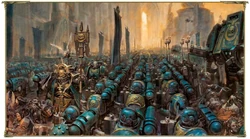
The proud scions of Guilliman stand ready to march to war in the Emperor's name
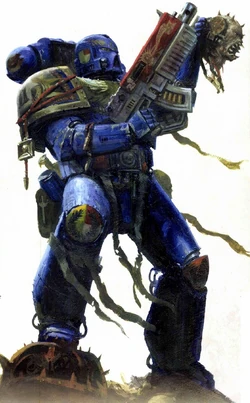
A hero of the Ultramarines stands ready to protect Mankind -- even from itself
Throughout most of the time that the Heresy was under way, the Ultramarines had been engaged in bringing new worlds into Imperial Compliance on the southern edge of the galaxy. Their very success had carried them far from Terra and isolated them from the conquering Traitor Legions which had been concentrated in the galactic northeast. News of Horus' treachery had not even reached the Ultramarines until the attack on Terra was underway seven years after Horus first betrayed the Emperor at Istvaan III. Consequently, the Ultramarines were poorly placed to contribute during the early stages of the Horus Heresy. Luckily, the Ultramarines were therefore largely untouched by the fighting of the Warmaster's rebellion. Other Loyalist Space Marine Legions had lost thousands of Legionaries during the fighting, and half of the original 18 Legions had sided with Horus and been corrupted by Chaos. As a result, the number of Astartes left to the Imperium was very few, yet never had they been more needed by its people.
The disorder following the Horus Heresy had left the Imperium weak and extremely vulnerable. Everywhere the enemies of Mankind prepared to attack. Many worlds remained in the grip of the Forces of Chaos. Into this breach stepped Roboute Guilliman and the Ultramarines. Always the largest of the Legiones Astartes, the Ultramarines found themselves divided into smaller units that were despatched all over the Imperium in a desperate effort to stem the tide of invasion and unrest. The Ultramarines successfully held the Imperium together during this time of intense danger when many centrifugal forces were seeking to rip the edifice of the Imperium asunder. Macragge was able to supply new Neophytes for the Legion at such a rate that before long the Ultramarines alone accounted for more than half the total number of Space Marines operating in the post-Heresy Imperium, and there were few human-settled star systems where their heroism went unnoticed at this time. Within a standard decade, order had been restored to the Imperium and the Forces of Chaos had been largely driven into the Eye of Terror. Even as the Ultramarines reconquered the worlds lost to the Warmaster, a new theory of warfare was emerging. Under the guidance of Guilliman's military genius, the Codex Astartes took shape. Its doctrines would reshape the future of all Space Marines and forevermore dictate the foundation of the Imperium's military strength and therefore the path to survival for Mankind.
The Second Founding of the Space Marines was decreed seven years after the death of Horus and the end of his Heresy. The majority of the remaining Loyalist Legions were divided into fewer than 5 Successor Chapters so depleted had their numbers been by the civil war, but the Ultramarines were divided many times. The exact number of Successor Chapters created from the Ultramarines at this time is uncertain: the number listed in the oldest copy of the Codex Astartes gives the total as 23, but does not name them. With the Second Founding, the size of the Ultramarines force was much reduced. Most of the Space Marines of the Legion left Macragge to establish new Chapters elsewhere. The Ultramarines' fortress-monastery had been built to accommodate more than ten times as many Space Marines as now remained on their homeworld. As a result its arsenals and weapon shops were partially dismantled and taken by the new Chapters to found their own fortresses. The genetic storehouses of the Ultramarines, and the Legion's powerful recruitment mechanism, were similarly divided amongst its Successors. As a result of the Second Founding, the Ultramarines' gene-seed became pre-eminent across the Imperium. These new Chapters created from the Ultramarines Legion during the Second Founding are often referred to as the Primogenitors, or "first-born."
Yet the heritage of Guilliman to his Astartes was not only genetic, but spiritual. Even to this day, 10,000 standard years later, all the Primogenitor Chapters venerate Roboute Guilliman as their own founding father and patron, and hold the ruler of the Realm of Ultramar and Master of the Ultramarines, whoever he may be from era to era, as the exemplar of all that it means to be a Space Marine. This is how the Ultramarines rose to be preeminent even amongst all the Chapters that were derived from their genetic material.
Roboute Guilliman continued to serve with the Ultramarines Chapter after the Heresy, leading them for another century after the Second Founding. It was said that during those years, Guilliman led several incursions alongside his brother Primarchs against the remaining Traitor Legions of the Chaos Space Marines. During one such incursion, Guilliman faced Alpharius of the Alpha Legion and defeated him in single combat, though this may simply be legend, as even the Ultramarines themselves cannot confirm this story. The Ultramarines could not liberate the planet, as the Alpha Legion remained unusually capable of resisting despite the apparent death of Alpharius and so eventually the Ultramarines moved on. Guilliman was only finally defeated by one of the Traitor Primarchs, Fulgrim of the Emperor's Children, who had become a Daemon Prince of Slaanesh (and whose own body had been secretly possessed by a Greater Daemon of Slaanesh).

The Temple of Correction within the Fortress of Hera on Macragge; the Shrine of the Primarch, which houses the body of Roboute Guilliman in stasis, is housed within
Fatally poisoned in combat by his one-time brother, Roboute was transported back to Macragge in a stasis field, and has remained entombed in that same field for over 10,000 Terran years. Although physically impossible in a stasis field, it is believed by many pilgrims to his shrine that his wounds are actually healing, and that one day he will awaken again when the Imperium needs him most.
The Shrine of Guilliman built to contain his body frozen in time is one of the most holy places in the entire Imperium, and one which welcomes millions of pilgrims to the shores of Macragge every year. It lies within the Temple of Correction, a vaulted sepulchre forming a small part of the Ultramarines' vast northern polar fortress on Macragge. The temple is a miracle of construction and typical of the attention to detail which defines the Ultramarines every endeavour. Its proportions defy the human mind by the scope and grandeur of its design. The multi-coloured glass dome that forms its roof is the largest of its kind. Even the Techno-magi of the Adeptus Mechanicus come to marvel at the structure said to have been designed by Roboute Guilliman himself. According to the Ultramarines there is enough marble within the temple to build a mountain, and sufficient amounts of adamantium and plasteel were used in its construction to build an Imperial warfleet capable of defending an entire sector.
Within this edifice is the great marble throne of Roboute Guilliman, and upon that throne sits his still-regal corpse. Though 10,000 years have passed since his death, the Primarch's body is perfectly preserved by the stasis field. Even his death wounds from Fulgrim's blade are visible upon his throat. His mortal remains are preserved from the ravages of time by means of a stasis field that isolates the Primarch from the time-stream of normal four-dimensional space-time. Everything encompassed by the field is trapped in time and can neither change nor decay. There are some among the more extreme devotees of the Imperial Cult, however, who claim the Primarch's wounds do change. They say that Guilliman's body is slowly recovering and that his wounds show mysterious signs of healing. Others completely deny this, and point out the sheer scientific impossibility of any from of change within a stasis field. Yet enough choose to believe the stories to come and witness for themselves the miracle of the Primarch, generation after generation. Hope, as Roboute Guilliman knew, is truly the most powerful force in the universe.
Tyrannic Wars and the Battle of Macragge
"We commend our souls to the Emperor. Let the story of our sacrifice burn across history like a shooting star. For death and for glory -- for the Ultramarines!"
- — Lucian Ventris, Ultramarines' Terminator Sergeant
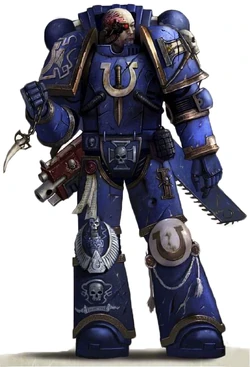
An Ultramarines Tyrannic War Veteran
Over the 10 millennia after the death of Roboute Guilliman Ultramar held against all manner of invaders -- some so strange as to defy the comprehension of the common man. The Ultramarines have tested their might against Ork WAAAGH!s and Renegade uprisings, Tau incursions and Necron raids, but the measure of their heroism is shown truest in battles where they have defended all life in the galaxy itself in the face of threats from beyond known space. So did the Sons of Ultramar prove in the 35th Millennium in battle against the Star-Striders of Crioth, and in retaliation for the Heavenfall Massacres. But of all these terrible wars and heroic struggles, there is one conflict that stands above all others -- the onslaught of the Tyranid Hive Fleet Behemoth, and the Battle of Macragge in 745.M41.
Upon learning the threat posed to Ultramar by Hive Fleet Behemoth, Marneus Calgar at once drew up his plans. Deeming Macragge to be the star system most immediately threatened, Calgar ordered its already formidable defences to be further improved. A dozen warships already hung in orbit, and each day more arrived from the Warp. Massive Strike Cruisers cast shadows over civilian vessels and Imperial Navy Destroyers, and were themselves dwarfed by the brooding presence of the Ultramarines' Battle Barges. Between this mighty fleet of warships and the planet's no less formidable orbital defence stations, Macragge was anything but defenceless. Scant weeks later, the outrider vessels of the Tyranid fleet attacked Macragge. The alien bio-vessels swept aside attacks by Ultramarines Strike Cruisers and swarmed over the planet below. Soon many thousands of Mycetic Spore-birthed beasts scurried and rampaged across Macragge. Deeming that the Tyranid threat was too massive to be opposed piecemeal, Calgar combined his ground forces into three mighty armies. The primary and secondary taskforces, composed largely of 1st Company Veterans and Ultramaran Planetary Defence Forces, bolstered Macragge's polar fortresses against the Tyranid onslaught. Meanwhile, Calgar's taskforce, the largest of the three, performed a series of rearguard actions, attempting to slow the Tyranid advance and eliminate Hive Mind synapse-control organisms. Calgar achieved great success in the early days of the campaign, buying time with blood for his Battle-Brothers to the north and south. However, the Tyranids kept coming.
In a final climactic battle on Cold Steel Ridge, the Ultramarines rearguard were brutalised by the Tyranid horde and Calgar himself was gravely wounded. Knowing that to remain planetside was to doom his followers to wasteful death, Calgar withdrew to the orbiting Battle Barge Octavius. Refusing all but the most vital medical attention, the Master of Macragge took command of the fleet, and sought a way to save his world from certain destruction. Hours later, the main Tyranid fleet arrived at Macragge. With no sign of reinforcements, Calgar led his fleet in a series of daring attacks, striking at isolated vessels as they spread out to invade Macragge in force. Caught between the blistering firepower of Macragge's polar fortresses and the vengeful hammer blows of Calgar's fleet, Tyranid vessels were destroyed by the score, but many more yet remained. As battle raged, the Tyranids unleashed thousands of Mycetic Spores above the vital polar fortresses -- if the fortresses were taken, Macragge's guns would be silenced, and the world left defenceless. So it was that the Tyranids landed in even greater numbers than before, and the fortresses soon found themselves sorely beset. Their gruesome cargo delivered, the battered Hive Ships retreated from orbit. Trusting to his Ultramarines to keep the fortresses secure, Calgar relentlessly pursued the Tyranid fleet, determined that it would not bring ruin to other worlds. Never before or since has the valour of the Ultramarines been tested as it was in the defence of the polar fortresses. The Veteran Space Marines of the 1st Company led the lightly-armed Auxilia in a tenacious defence of the fortresses, holding every wall and trench until the last possible moment before it was overrun by the Tyranid swarm. Slowly the troops withdrew ever deeper into the fortress, while making the Tyranids pay for every single yard of ground they advanced. The Titans of Legio Praetor stalked the ice fields and drove smoking furrows through the onrushing Tyranid hordes with shells and plasma. The ferocity of the swarms was unbelievable. At the northern fortress they overran the walls by using the steaming piles of their own dead for cover. Imperial Battle Titans were dragged down and ripped apart by sheer weight of numbers. The defenders' gun barrels glowed red hot and jammed in spite of the arctic cold, ammunition began to run low even though the fortress had contained stockpiles intended to last for months of siege.
Yet still the defenders fought on. Lumbering scythe-armed Carnifexes tore into the defenders' bastions like living battering rams, smashing their way through metal and rockcrete walls with equal fury. The Ultramarines had to rely on heavy short-range firepower to bring down the foe, but for each Tyranid that fell, another three sprang forward to continue the fight. Lesser men were paralysed with terror as the Tyranids broke through the perimeter again and again, but the Ultramarines never despaired and never gave thought to defeat.
Calgar pursued the Tyranid fleet toward the ringed world of Circe at the edge of the Macragge System. The timely arrival of the Imperial Navy's entire Battlefleet Tempestus from Bakka finally sealed the Tyranids' fate by catching them in a vice between the two fleets. Even now, the Imperial fleet was overmatched, for the Tyranids were too many. The battle would have been lost save for the heroic sacrifice of the great Battleship Dominus Astra. Charging into the heart of the Hive Fleet, the huge Emperor-class Battleship detonated its Warp-Drives, creating a Warp vortex that dragged both it and the entire Tyranid fleet to oblivion.
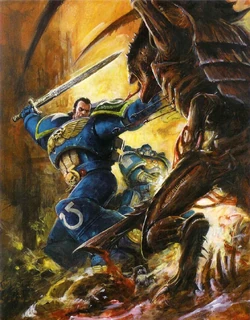
Captain Uriel Ventris leads the 4th Company against the Tyranids
With the bulk of the Hive Fleet destroyed, Calgar's surviving starships came about and returned to Macragge to try to save the polar garrisons. The survivors of the Ultramarines 1st Company were still believed to be fighting amongst the defence laser silos of the northern citadel, but all contact with them had been lost after the Tyranids overran the surface outposts. Of the southern garrison, nothing was known. Calgar, feeling that the situation was becoming critical, sent the 3rd and 7th Ultramarines Companies ahead in their fast Strike Cruisers while his remaining damaged ships limped back to Macragge. The Space Marines of the 3rd and 7th Companies deployed onto the poles by Drop Pod, their supporting units following up in Thunderhawk gunships. Scenes of unbelievable carnage awaited them below. Piles of mangled Tyranid corpses and shattered wargear lay strewn across the ice. Vast, steaming craters pocked the snows where Titan plasma reactors had gone critical. The stench of death lay everywhere. The 7th Company landed unopposed at the southern fortress and quickly linked up with the survivors of the garrison above ground. Together they pushed on to clear the subterranean passages that the Tyranids had overrun. Devastator Squads kept the alien swarm at bay until Thunderhawk gunships arrived to blast the Tyranids back into the darkness. Captain Fabian of the 3rd Company prudently awaited the arrival of the company's three Dreadnoughts before proceeding into the fortress itself to search for survivors.
The dark, dank corridors beneath the northern fortress were already altered by the alien presence. Mucous dripped from the walls and ceilings and a pervasive musky stench filled the air. Alien screams and roars echoed and reverberated along the tunnels. The Space Marines pushed onward into corridors littered with Tyranid and Ultramarines dead, the darkness reluctantly receding before their suit lights. Chameleoid Lictors lay in ambush amongst the corpses, slashing into the advancing squads in an orgy of destruction. Eventually the forward squads used flamers to burn their way along the passages and flush out their enemy. Even as fire consumed them, the creatures still leapt forward with claws outstretched to rend and slay.
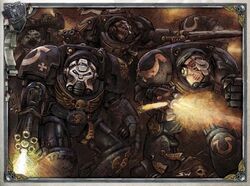
Ultramarines 1st Company Veterans in Terminator Armour sell their lives dearly against the Tyranid menace
Through darkness and terrors unimaginable, the 3rd Company finally reached the lower Penitorium where the defenders had made their last stand. Tyranid bodies were piled deep around the doors, and within the room a circle of Terminators lay where they had fought back to back. Each had given his life for his brothers. The Ultramarines' 1st Company had been wiped out to the last man. The Battle of Macragge remains a great source of both sorrow and pride for the Ultramarines. The names of its fallen are commemorated each year at the Feast of Days, their sacrifice remembered throughout Ultramar with honour and gratitude. But the cost had been great. The Ultramarines 1st Company was gone and the 3rd and 7th sorely diminished. It would be many long years before the Chapter could properly replace its losses, but replace them it would. The Ultramarines would endure.
Since the Battle of Macragge, the Ultramarines have become instrumental in the Imperium's wars against other Tyranid Hive Fleets. In response to the threat, and counter to the dictates of the Codex Astartes for the first time, the survivors of the Battle of Macragge were formed into elite, specially-trained anti-Tyranid squads. These Tyrannic War Veterans make up the first and most powerful of the Chapter's reformed 1st Company, and are second to no other warriors of the Imperium because of their experience, training and upgraded Power Armour.
Defenders of Ultramar

Captain Titus of the Ultramarines 2rd Company faces the Orks who invaded the Forge World of Graia
The Ultramarines have always held the Eastern Fringes of the galaxy in the vast Ultima Segmentum against the forces of darkness that threaten the Imperium from beyond the Halo Stars, and the Chapter's 4th Company has a special hatred for the savage xenos invaders known as the Tyranids. Rapacious, extra-galactic predators, these relentless alien killers consume all before them in their quest for bio-matter to feed the ever-hungry biological factories of their Norn-Queens. The first Tyranid Hive Fleet, code-named Behemoth, smashed into Imperial space in 745.M41 and descended upon Macragge in a fury of talon and claw. Forewarned of the coming xenos danger by the Inquisitor Kryptman, the Chapter Master of the Ultramarines, Marneus Calgar, stood ready to face the deadly aliens, but nothing could prepare his warriors for the sheer horror of what was to come. Commanded at this time by Captain Idaeus, the 4th Company fought at the forefront of the invasion and were instrumental in the destruction of several of the larger Tyranid vessels. At last the invasion of Hive Fleet Behemoth was repulsed, but at terrible cost; the entirety of the Ultramarines' Veteran 1st Company was wiped out defending the northern polar defences of Macragge and many great heroes of the Astartes met their end. The Ultramarines had won the First Tyrannic War, but Kryptman assured Calgar that the Tyranids would be back.
With the destruction of Hive Fleet Behemoth, the Ultramarines set about consolidating their hold on the interstellar Realm of Ultramar. Many of their best and bravest warriors had fallen to the Tyranids, and with their strength thus depleted, many other alien and piratical raiders took advantage of this lapse in security and launched their own raids throughout Ultramar to sack worlds previously unassailable. Thus it was that the 4th Company -- which had been at full strength when the Tyranid fleet attacked -- had come through the war with the fewest casualties, and were thus the first called upon to help liberate Vorhn’s World, a Shrine World of the Ecclesiarchy in a neighbouring sub-sector.
The Ork Warlord known as the Arch-Maniac of Cabela had seized the world, enslaving its population and defiling the holy temples of the Emperor. Such barbarity could not be countenanced on such a holy world and thus the 4th Company was tasked with its liberation. Idaeus once more led his warriors into battle, using a combination of rigid adherence to the words of the Codex Astartes and an uncanny ability to adapt to rapidly changing battlefield conditions to circumvent many of the Ork strongpoints and destroy the most vital elements of their defences. With much of their energies spent hunting down the Space Marine raiders in their midst, the Orks were unable to repulse the massed tank companies and regiments of the Imperial Guard's Jovian Hussars who overran the Greenskins with an unusually low casualty rate. It was during the cleansing of Vorhn’s World that a young Space Marine named Uriel Ventris first came to Idaeus’s attention. Descended from the legendary Lucian Ventris, who had died fighting the Tyranids of Hive Fleet Behemoth beneath the polar defence fortress 180 years before, Uriel displayed an exemplary courage, even amongst warriors for whom heroic feats of bravery were the norm. Taking command of his squad when his sergeant was killed by an Ork warlord, Uriel displayed the qualities that would one day lead him to command the 4th Company itself.
With the liberation of Vorhn’s World, the task was now to secure the borders of Ultramar, and upon their return from the victorious campaign against the Orks, Idaeus’s company joined their Battle-Brothers in securing the borders of Ultramar against further attack. For the next 5 standard years, the company patrolled the northern borders of their realm, running interdiction attacks and boarding actions against any and all raiders they encountered. Aboard the Vae Victus, an honourable Strike Cruiser commanded by Captain Lazlo Tiberius, himself a scarred veteran of the Tyrannic Wars, the 4th Company destroyed over 300 enemy vessels and achieved the highest number of kills to add to the banner in their company chapel.
Over the next few years, between occasional returns to Macragge for obeisances at the Temple of Correction, where the stasis-sealed, mortally wounded form of the Primarch Roboute Guilliman watches over his Chapter, the 4th Company regained its strength and inducted many new members. Returned to full combat readiness, the company was once again fit for duties beyond the borders of Ultramar and in the Mereneas Core, the company was to earn the gratitude of the Adeptus Mechanicus when they boarded and destroyed the Space Hulk Flame of Iniquity, an agglomerated structure of scores of derelict starships that threatened a number of their Forge Worlds, the giant factory planets where much of the armed might of the Imperium is produced.
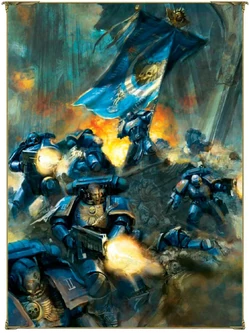
The Ultramarines charge the enemy
Following this success, the determination and courage of the 4th Company came to the attention of Inquisitor Markhov, who was in need of warriors of such great skill. He petitioned Marneus Calgar for the Ultramarines' assistance in a matter of grave urgency. Calgar consented to allow the 4th Company to be seconded to the Inquisition's service and Idaeus’ company was despatched to the world of Epsilon Regalis -- a world later to be made infamous by the Witch Hunter Tyrus. Precisely what occurred on this world has never been made known, the events subsequent to the Ultramarines deployment on Epsilon Regalis having been sealed by the order of the Ordo Hereticus. Immediately following this mysterious mission, the 4th Company were involved in the eradication of several indigenous life-forms on the world of Horranveth to allow colonisation by an Adeptus Mechanicus Explorator team to proceed. Many among the Ultramarines felt that this type of combat was beneath them, but none dared defy their Chapter Master’s decree.
Following the purgation of Horranveth, the company was recalled to take part in the Balur Crusade, a mixed- Chapter-force led by Marneus Calgar himself. A strong coalition of xeno creatures (identified as the Tau, Kroot and Tarellians) had launched an attack into Imperial-held space and demanded that the inhabitants of the captured worlds swear allegiance to their blasphemous empire. Naturally, such naked aggression could not go unanswered and together with warriors of his own Ultramarines and from the Blood Angels, Marines Malevolent and the taciturn remnants of the Scythes of the Emperor Chapter, Calgar led the combined Space Marines army to swift victory, destroying the nascent xenos colonies and re-establishing Imperial rule.
The 4th Company was to fight the Tyranids again on the world of Ichar IV when the Tyranids returned with yet another Hive Fleet, this time known as the Kraken. Far from the battering ram of Hive Fleet Behemoth, it appeared that the Tyranids had somehow learned from their defeat centuries before and attacked in a series of smaller, yet no less lethal splinter fleets -- advancing across a much wider front. Many of these fleets were destroyed, driving the aliens to consolidate their attack on the industrial world of Ichar IV. Again, the Tyranid threat was met with courage and steel, the men of the Ultramarines fighting alongside hundreds of Imperial Guard Regiments and elements from 7 other Space Marine Chapters. The 4th Company was again in the forefront of the fighting, with Idaeus and Uriel both awarded the Imperial Laurel for their heroism. Once more the aliens were repulsed, though the threat of Hive Fleet Kraken remained strong. The Tyranid fleet broke into a number of smaller fleets as it retreated from Ichar IV and it is known that many of these splinter fleets penetrated deep into the galactic core. Some even reached as far as the Segmentum Solar though the massed guns of the Imperial fleet destroyed these without mercy. However, whether every one of these Kraken splinter fleets has been destroyed remains unclear.
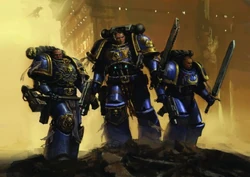
Following the defeat of the Tyranids at Ichar IV, the 4th Company was despatched to the world of Thracia, where the rumoured deployment of the Night Lords Chaos Space Marines necessitated a force capable of meeting them blade-to-blade. Regiments of Imperial Guard pushed towards the planetary capital city, meeting stiff resistance, but crushing all before it. As the campaign progressed, the Imperial lines became lengthy and strung out -- all too easy to attack and destroy from the flank. Realizing this, the 4th Company attacked the bridges that would allow such an attack, but in the process Captain Idaeus was lost, heroically sacrificing his own life to destroy the last bridge. Mourning his loss, the 4th Company returned to Macragge, whereupon Veteran Sergeant Uriel Ventris was elevated to the rank of Captain and commander of the company.
Together with the newly appointed Captain Ventris, the 4th Company set off on their latest mission; to escort Adept Barzano of the Administratum to the troubled world of Pavonis. On the Eastern Fringes, Pavonis had been plagued by piratical raiders and civil insurrection and upon the Ultramarines’ arrival, the planet was very nearly plunged into a bloody civil war between its competing industrial cartels. Captain Ventris and Adept Barzano (now revealed to actually be an Inquisitor of the Ordo Xenos) went on to discover that the planet’s troubles were at the instigation of a madman named Kasimir de Valtos who desired the release of an ancient and powerful C'tan Star God who had been imprisoned beneath the surface of Pavonis for tens of millions of years. De Valtos was ultimately thwarted, though the ancient being known as the Nightbringer was freed from its aeons-long slumber and set loose amongst the stars. Only time will tell whether its escape will cost the Ultramarines and the galaxy dearly.
With peace and Imperial rule restored to Pavonis, the 4th Company journeyed to the northern reaches of Segmentum Tempestus to the world of Tarsis Ultra -- a world brought into the Imperium by Roboute Guilliman himself during the early days of the Great Crusade -- and a world with a proud history of upholding the traditions of the Ultramarines. Ancient oaths of brotherhood bound the fate of Tarsis Ultra to the Ultramarines and when a gargantuan Space Hulk drifted in-system, Captain Ventris led his men deep into its haunted depths to destroy it from within. Buried deep within its structure, the Ultramarines discovered nests of frenzied Orks and something much worse: Genestealers. The fighting within the Hulk was amongst the fiercest encountered by the 4th Company, but its warriors were able to fight their way clear of the hulk and watch its destruction from the bridge of the Vae Victus. But the victory was tinged with dread, for the Astartes vessel's Astropaths detected the forward edge of a bow wave of Warp interference -- a phenomenon known as the "Shadow in the Warp" -- which could mean only one thing. The Tyranids were approaching the borders of the Imperium once more.
With warning of the approaching Tyranid Hive Fleet Leviathan given, the Imperial response was unusually swift. The Ultramarines contacted a brother Chapter of Space Marines, the Mortifactors, though they had diverged considerably from the ideals of Roboute Guilliman -- embracing a culture of death worship. A fleet led by the Imperial Navy Admiral Bregant de Corte aboard the battleship Argus was assembled, including many ancient and noble ships of war; the Sword of Retribution, and the Kharloss Vincennes to name but two. Imperial Guard soldiers from the Death Korps of Krieg and the Logres Regiments were shipped in and the local Planetary Defence Forces trained by Sergeant Learchus using the methods of the Ultramarine training barracks. Inquisitor Lord Kryptman once again lent his expertise to the commanders of the defence of Tarsis Ultra as well as bringing an elite Deathwatch Space Marines Kill-team led by the justly famed Watch Captain Bannon. As far as any world could be defended, Tarsis Ultra was as secure as it could be made given the time available to its defenders.
Battle was joined in the system’s outer reaches and though the world of Barbarus Prime was lost to the Tyranids, the first elements of their fleet were defeated. The advance of the Hive Fleet could not be stopped and Kryptman was forced to sacrifice the world of Chordelis -- ordering the Mortifactors to virus-bomb it from orbit before the Tyranids could assimilate its biomass. Despite fractures appearing among the Imperial commanders, the Tyranid threat was met with courage and honour on the surface of Tarsis Ultra, though the defenders were hard-pressed to stave off the relentless attacks of the aliens.
Though many thousands of lives were lost, and a huge proportion of the 4th Company was slain, the Tyranids were once more defeated when Captain Ventris cast off the teachings of the Codex Astartes and took command of the Deathwatch Kill-team. He led them on a last, desperate mission to deliver a lethal gene-poison to the heart of the last remaining Hive Ship. Having once served with the Deathwatch, Captain Ventris knew that this was where he could do the most good, and despite the grim warning from Veteran Sergeant Learchus that Marneus Calgar would hear of his flouting of the Codex, he set off on his mission. Through alien terrors and biological horror, the Deathwatch Space Marines and Captain Ventris were successful and the gene-poison was administered to the Tyranid Norn-Queen. Driven into spasms of uncontrolled mutation, the Norn-Queen died and her death throes drove the slave Tyranid organisms connected to her via the gestalt psychic consciousness of the Tyranid Hive Mind into paroxysms of feral self-destruction. The Tyranids were defeated, but like Ichar IV before it, the taint of the alien invasion would forever be impossible to remove from the surface of Tarsis Ultra -- and the souls of its surviving population.
With Tarsis Ultra secured, the 4th Company gathered its dead and returned to Macragge, the hearts of its warriors heavy as they contemplated the cost of honouring their ancient debt. But something worse was awaiting the 4th Company upon their return to their homeworld. Allegations of heresy awaited Uriel Ventris for his actions on Tarsis Ultra and with them, the potential to strip the company of its honour.
Captain Ventris was spared the expected execution for his breach of Ultramarine doctrine and instead given a Death Oath by Marneus Calgar: he and his faithful companion, Sergeant Pasanius Lysane, were to seek out "a place of dark iron" where twisted reflections of the Space Marines were being wrought. Shortly after departing Macragge, Ventris' starship was attacked by Warp entities directed by a daemon imprisoned inside a daemon engine called the Omphalos Daemonium. This daemon engine resembled a huge, grotesque steam locomotive, which could travel between the Warp and realspace. The two Space Marines were seized and taken deep within the Eye of Terror to Medrengard, the Daemon World that was the home of the Iron Warriors Traitor Marines. The pair soon linked up with a band of Renegade Space Marines and two surviving former Imperial Guardsmen, who were escaped slaves of the Iron Warriors. The group became a self-styled guerrilla band, engaging in hit-and-run attacks against the Iron Warriors. Ventris, Pasanius and the band of guerrillas were eventually captured by Warsmith Honsou of the Iron Warriors, and after defying him, Ventris was "implanted" in the womb of a Daemonculaba, a genetically-modified woman whose womb had been amplified with Imperial Fists gene-seed the Iron Warriors had stolen during the 13th Black Crusade from the world of Hydra Cordatus and which was intended to turn normal adolescents into new Chaos Space Marines. This twisted technology was a mechanism intended to accelerate the development of new Traitor Marines in the laboratories under Honsou's fortress. These new Chaos Space Marines were intended to refill the ranks of the Iron Warriors Legion, which had been unable to replace its losses over the 10 millennia since the Horus Heresy. The Daemonculaba were also the mutated creatures that Uriel and Pasanius had been tasked with destroying in the first place. At the same time, Honsou was under siege by rival Iron Hands Warsmiths for refusing to hand over their share of the untainted Imperial Fists gene-stock taken after the invasion of an Imperial facility on Hydra Cordatus. As the fighting raged, Ventris and Pasanius managed to get free and succeeded in destroying Honsou's labs and his fortress, although in order for this to happen they had to release a captive Khornate Daemon Prince. The Daemon Prince then annihilated the rival daemon it had previously imprisoned in the Omphalos Daemonium, destroyed Honsou's fortress and minions, and attacked Honsou's rivals, driving them away. Later, Uriel, Pasanius, and a group of the so-called Unfleshed, who were the mutant rejects of the Iron Warriors' experiments to make new Space Marines using the Daemonculaba, escaped from the Eye of Terror on the Omphalos Daemonium, which had reverted to a normal starship.
However, the former daemon engine brought them through the Warp to a troubled world called Salinas, and more specifically to a forbidden zone on that world's surface that reeked of death. Ventris and Pasanius were then confronted by the veteran Imperial Guard Regiment that ruled the planet as a gift of conquest, and the suspicious and ruthless Planetary Governor, the regiment's ex-commander. They requested help in reaching Macragge, but their astropathic transmission was intercepted by the Grey Knights, who were monitoring Salinas for other reasons. A squad of them arrived on the planet, arrested Ventris and Pasanius, and after grueling physical, mental and spiritual trials declared them untainted by their exposure to Chaos during the events on Medrengard. In the meantime, it was revealed that a powerful psyker had likely brought the Omphalos Daemonium to Salinas in order to use the freed Unfleshed as an instrument of revenge against the governor and his former regiment. This was vengeance for the regiment's murder of tens of thousands of civilians, including the entire population of a town that was the birthplace of many of the leaders of a small-scale guerrilla campaign that now operated on Salinas. The campaign itself had been caused by the brutality and heavy-handedness of the Imperial Governor. This ravished town was the forbidden zone the Ultramarines had first found themselves in when they arrived on Salinas. After being possessed by the psyker, the Unfleshed went on a killing rampage, but they were eventually killed by Uriel, Pasanius, and the Grey Knights, who subsequently returned the Ultramarines to Macragge.
Having successfully completed their Death Oath, Uriel and Pasanius were welcomed back to the homeworld of their Chapter but were subjected to interrogation and tests by the Chief Librarian to insure they had not been tainted by their time on the Daemon World of Medrengard. After both Uriel and Pasanius were deemed free of Chaotic taint, Uriel was reinstated as Captain of the Ultramarines' 4th Company and given the opportunity to prove himself in the eyes of those who still doubted him by returning to the world of Pavonis and defending it from Tau invaders. Pasanius was not so fortunate, as he was demoted in rank and forced into one hundred days of isolation from the Chapter. This harsh treatment was a punishment for hiding the unusual regenerative abilities of his bionic arm, which he had gotten after the C'tan called the Nightbringer had scythed off his biological arm during the earlier Ultramarines mission to Pavonis. Apparently because of this contact with the C'tan, the bionic arm had become infused with the Necron's living metal, the substance called necrodermis. After one hundred days he was reinstated as a Battle-Brother of the 4th Company and rejoined his captain.
In the meantime, the Warsmith Honsou was consumed by hate for Ventris and the Ultramarines following the events on Medrengard and the destruction of his Chaos Space Marine incubation experiments. He hatched a plan to annihilate the Ultramarines, and especially Uriel Ventris. As bait, he used a stolen Mechanicus virus to turn Tarsis Ultra, the world the Ultramarines had vowed to protect, into a Dead World. He had assembled a large invasion force, which apart from his Iron Warrior warband, included Chaos Cultists, Traitor Marines and Traitor Guardsmen, Dark Eldar pirates, Kroot and other alien and human mercenaries, a Dark Mechanicus force led by the Traitor Magos Cycerin, and a multitude of criminals, psychopaths and killers. Honsou managed to find and board a star fort hidden for the previous 60 years in the depths of uncharted space in the Ultramar Sub-sector, guarded by an Ultramarines contingent. He slaughtered the star fort's Ultramarines garrison and then freed the powerful Daemon Prince M'kar, secretly held captive within the fort. The daemon, who had once been the Word Bearers Dark Apostle named Maloq Kartho who had originally attacked Ultramar during the Horus Heresy, was imprisoned by Marneus Calgar, the Chapter Master of the Ultramarines, with the help of the Inquisition. M'kar hated the Ultramarines Chapter and the Imperium of Man with a passion. Aligning with the Warsmith Honsou, the Daemon Prince possessed a desecrated Ultramarine Dreadnought shell so that he could interact with the material universe, turned the star fort into a Chaos abomination linked directly to the Warp, and called forth a huge daemon army to join in attacking the worlds of the Realm of Ultramar.
Honsou had managed to acquire a clone of Uriel Ventris, known as the "Newborn", who had been created from the genetic material left behind while Uriel was in the womb of the Daemonculaba on Medrengard. The Newborn was a psychic as well as physical clone of Uriel. As such, he had fragments of Uriel's knowledge and memories, including the defence protocols of Ultramar, which Honsou first used to attack the star fort, and then the entire Realm of Ultramar. The whole Chapter rose in defense of the realm, aided by an Adeptus Mechanicus contingent under Magos Locard, the warband of the system-based Ordo Malleus Inquisitor Suzaku, a squad of Raven Guard Space Marines, the mobilized Ultramar Planetary Defense Force regiments, and many civilians. The war expanded to encompass several Ultramar worlds, at least one of which was destroyed. Finally, Uriel confronted the Newborn (and Honsou), on Calth, his planet of birth. Honsou had gone there at the request of M'kar, to the Tomb of Ventanus (an ancient Ultramarine hero of the 4th Company known as "the Savior of Calth") to destroy Ventanus' sarcophagus and his wargear. Uriel killed the Newborn using a blade that was part of Ventanus' wargear, and in the battle that followed Honsou's more numerous force was defeated thanks to the sudden appearance of spectral guardian-warriors. Honsou, faced with capture or death, detonated the explosives the Iron Warriors had previously placed around the Tomb, collapsing the grand edifice of the Tomb on top of himself and his opponents. Uriel and some of his fellow warriors survived and headed to Talassar, an Ultramaran world where M'kar and his daemon army were close to overrunning Chapter Master Calgar and his dwindling forces. Uriel and other friendly reinforcements arrived in the midst of the final, climactic battle for the world. Ventris tossed the powerful anti-daemonic Blade of Ventanus to Calgar as the Chapter Master was duelling with M'kar, and Calgar used it to completely annihilate the Daemon Prince.
With the daemon army and Honsou's forces defeated in all the theatres of the war, the Imperial forces proceeded to engage in mopping-up operations, and within six months, the Realm of Ultramar was declared free of the touch of Chaos. Ominously, while the ruins of the Tomb of Ventanus were searched thoroughly, the body of Warsmith Honsou was never recovered.
Notable Campaigns
- First Pacification of Luna (ca. 800.M30) - This early Imperial campaign was the first operation mounted by elements of the early Space Marine Legions beyond the skies of Terra. The Unification Wars were still raging across the surface of Mankind's birth world. Luna was the bastion of a conglomeration of resurrectionist gene-cults whose members believed that human nature was both fractal, fractured and transcendent. Each of these Selenar gene-cults clung to a different set of archetypes. Every cult member was a product of creation by the Selenar gene-wrights according to formulae crafted in the Dark Age of Technology. Resurrected in body time and time again they sought to distill the true personification of a single human archetype. In their subterranean complexes the cults were powerful, insular and resistant to the Imperial Truth. The Imperials would have normally dealt with these insular cults in the usual matter they handled all of the other Terran factions and techno-barbarian states that refused to accept the rule of the Emperor of Mankind -- by obliteration. The fact that the Selenar gene-cults had something that the growing Imperium needed complicated that position. The Selenar returned the Imperial entreaties for alliance with silence. As the threats of the Imperium soon began to outnumber its offers, the Selenar cults began to gird themselves for war. So it was that the Emperor finally ordered Luna to be pacified by the sword, their superstitious beliefs cast down before the Imperial Truth and their gene-craft yoked to the needs of the Imperium. To this task the Emperor set the three of his newborn Space Marine Legions most suited to this purpose on what some Imperial chroniclers name as the first true battle of the Great Crusade. The combined force of the VIIth, XIIIth and XVIth Legions (later named the Imperial Fists, Ultramarines and Luna Wolves) lifted from the surface of Terra in a scattering of rocket flame. The as yet unnamed XVIth Legion had been chosen to serve as the Space Marine force's vanguard, and had brought its full strength to bear. Cutting power to their assault craft, the Astartes of the XVIth Legion drifted silently towards Luna through the void like arrows fired into the night. As the smaller wave of assault craft belonging to the VIIth and XIIIth Legions approached the airless world, the Selenar defensive weapon systems embedded in Luna's surface lashed the oncoming Imperial force. The XVIth Legion's assault craft, unlooked for and unseen, struck their targets like a dagger in the night. Within six hours of the first shot being fired, Luna had been pacified and brought into Imperial Compliance, the first off-world conquest of the Imperium of Man. Faced with annihilation, the surviving Selenar cultists bent the knee instead, their surrender communique transmitted to Terra calling for the Emperor to "call off his wolves." Broken and humbled, the enslaved gene-wrights of Luna would help forge the next generation of Space Marine who would carry out Mankind's conquest of the stars. As for the XVIth Legion, they had earned their name -- the Luna Wolves.
- Compliance of Tarsis (Unknown Date.M30) - This was an Imperial Compliance carried out by the Ultramarines Legion upon the world of Tarsis against unknown assailants. During the assault, the Primarch Roboute Guilliman was attacked by a mysterious assailant, but was saved by a native soldier of this world. In a supreme display of humility, Guilliman bent his knee before the soldier and vowed a warrior's oath that should this world ever need aid then the Ultramarines would answer the call. A temple within the capital city of Erebus displayed the Tarsis Frescoe, a mosaic of enormous proportions painted by an unknown artist that covered the walls, ceiling and even the floor, covering the entire chamber like a canvas. This frescoe displayed the events that had occurred during the Great Crusade. In gratitude to Guilliman and the Ultramarines, the planet renamed itself Tarsis Ultra in honour of its saviours.
- Castigation of Khur (964.M30) - Nearly six decades after being brought into Imperial Compliance and some forty-three standard years before the start of the Horus Heresy, the XIIIth Legion, the Ultramarines, utterly destroyed the city of Monarchia on the world of Khur on the order of the Emperor as an example to both Primarch Lorgar and his Word Bearers Legion that violations of the Imperial Truth through the encouragement of the continued error of religious faith and the spread of idolatrous doctrine would not be tolerated. This action, against a monument to the worship of the God-Emperor they had called "the Perfect City", crushed the morale of Lorgar and his Space Marines and led them to seek out new gods more worthy of their worship -- the Ruinous Powers of Chaos.
- The Tesstra Compliance(Unknown Date.M31) - Tesstra was at that time part of a close alliance of totalitarian colonies resistant to the Imperium's authority. This alliance, known as the "Conservation", had survived the Age of Strife through a mixture of relative good fortune and rigidly imposed eugenic control. This divided its population into highly stratified castes enslaved to their civilisation's greater needs. For the Imperium, the Conservation's worlds represented an addition to the Great Crusade's conquests; a prize that would liberate a human population of nearly eleven billion, but in order for this to be the case, the abhorrent civilisation created by the Conservation would have to be systematically dismantled. Once the Imperium's emissaries made their desires known they were fired upon and driven away, while the Conservation geared its worlds to violent defence against the Great Crusade. The Warmaster Horus, whose own forces were at the time engaged in battle elsewhere, diverted the forces of two Expeditionary Fleets, commanded by Roboute Guilliman and Alpharius respectively, to bring the Conservation to heel. The Ultramarines began to immediately conduct a campaign to engage and conquer the outer worlds of the Conservation, whilst pinning down its mobile military assets in an ever constricting noose. Alpharius and his Alpha Legion did not immediately attack, but instead circled, launching probes and raids without seeming rhyme or reason. Increasingly infuriated by the Alpha Legion's lack of progress and co-operation, Roboute Guilliman is known to have openly berated Alpharius in council, demanding that the Alpha Legion learn from his own Ultramarines' method of warfare and emulate it to achieve the victory that the Great Crusade demanded of them both. Further, that if Alpharius were to place his Legion under Guilliman's full command, the Conservation could be made to fall in a matter of months. This demand Alpharius ignored. Through the tactical brilliance and strategic genius of Alpharius Omegon, the Legion employed their well-known deceptive tactics of infiltration and the gathering of intelligence by their human non-Astartes agents on the ground. To the Tesstrans they appeared to be delaying their invasion, appearing only as threatening spectres as more and more Tesstran forces were deployed to Tesstra Prime's defences in preparation for the inevitable attack. When the assault finally came, it sent the Tesstrans reeling, striking from a hundred vectors at once yet leaving whole swathes of the defensive lines untouched. Soon sabotage ran amok, causing sever supply shortages and Alpha Legion strike forces began to appear inside the capital city, making red slaughter of government facilities and security stations with impunity. Sheer anarchy reigned as the Tesstran commanders were unable to redeploy their forces from the defences not under attack back to the city. Supply lines collapsed or were cut, orders were redirected or simply failed to arrive, and entire divisions were stranded trying to cross bridge networks that had been blown apart before they could reach them. It was then that the Harrowing of Tesstra Prime truly began. Beset on all sides by Alpha Legion forces, the Tesstran forces were subsequently torn apart by the Legion's super-heavy armour columns, and their own forces were advanced directly into the teeth of a vicious trap already laid for them. The battle was short lived and effectively over, but the killing continued. As the Alpha Legion withdrew from Prime, their task done, they left an anarchy of riot, fire and ruin in their wake. The regime and infrastructure had collapsed, and the dead and dying were everywhere in the streets, with pestilence and famine soon to follow. It is estimated that 90% of Tesstra Prime's population, both military and civilian, would not survive the battle and its aftermath. The rest of the plane capitulated in a matter of days. Alpharius Omegon's conduct invited censure from many quarters, especially from Primarch Guilliman, who declared the Alpha Legion's tactics dishonourable and unworthy of Astartes in a formal protest to the Warmaster. Horus was the only Primarch who openly praised his brother-Primarch and the way in which his Legion had conducted a truly masterful campaign, but the Ultramarines would not serve directly alongside the Alpha Legion for the rest of the Great Crusade.
- Pacification of Arkenath (ca. 004-005.M31) - Captain Hektor, commanding 500 of his Battle-Brothers, helped prosecute the Emperor’s Great Crusade to bring enlightenment to the galaxy and repatriate the lost colonies of man by fighting the Vektates of Arkenath. The Vektate were a deviant culture, an alien overmind that had enslaved the human populous of Arkenath. Hektor and his warrior brothers had shattered the yoke that bound their unfortunate human kin and in so doing had destroyed the Vektates. The human populace owed fealty to the Imperium, and demonstrated it gladly when they were free of tyranny. It had been a grim war. Captain Hektor's ship the Fist of Macragge had been involved in a brutal ship-to-ship action against the enemy, but had prevailed. Repairs had been conducted on Arkenath, as well as the requisitioning of a small tithe of men, eager to venture beyond the stars, to help replenish elements of the ship’s crew. Once the war was over, Hektor and his Battle-Brothers had been summoned to the Veridian System and the region of space known as Ultramar in preparation of the massive joint campaign of extermination with the Word Bearers XVIIth Legion against the Ghaslakh xenohold, a common mission for the Astartes during the final days of the Great Crusade. It would be on the Veridian System's primary world, Calth, that Lorgar would launch a surprise attack on the Ultramarines, later known as the Calth Atrocity whilst they were gathered for the campaign against the Orks of Ghaslakh. The XIIIth Legion would be caught completely unaware while the Word Bearers attempted to use the advantage of surprise to completely annihilate their hated rivals. The Fist of Macragge would never arrive, as they would be completely obliterated by the Word Bearers secretly-constructed warship, the Furious Abyss, while enroute to Calth.
- Cleansing of Ariggata (ca. 004.M31) - This was an Imperial Compliance that was carried out jointly by the Ultramarines, Luna Wolves and the World Eaters Legions against the world of Ariggata. A technologically advanced world, the world of Ariggata had been isolated from the rest of humanity for many centuries, and when Imperial envoys arrived bearing word of the Emperor and the Imperial Truth, they were executed in a bloody gesture of independence. The military might of Ariggata was formidable, and thus the honour of its pacification fell to the Warmaster Horus and two other Space Marine Legions under his command. Most of the planet was quickly conquered, except for the massive fortress within which most of the leaders of the planet cowered. Eager to be on his way, Horus commanded Angron, Primarch of the World Eaters, to take back the citadel and kill only the leaders. Eagerly, Angron led the assault. However, the fortress was heavily defended and the casualties were horrendous, a dozen World Eaters falling for every metre of land. Eventually, a ramp of corpses led up to a single breach in the wall, and the Astartes of the World Eaters Legion plunged in. Filled with rage over their fallen brothers, they were merciless. By the time the Ultramarines arrived, the battle was all but over. The inside of the fortress was filled with the dismembered and mangled corpses of the defenders, for not one soul had been spared the vengeful fury of the World Eaters. It was an absolute slaughter, the fortress having been transformed into an abattoir of human blood. The Ultramarines were disgusted by this savage behaviour and by the time the appalled Sons of Guilliman left the citadel, the Luna Wolves and the World Eaters had already departed, leaving the Ultramarines to garrison Ariggata until the Imperial Army arrived. Before Guilliman was able to confront his brother Primarchs regarding the massacre on Ariggata, the Horus Heresy erupted, both Horus and Angron spitting on their oaths of loyalty to the Emperor, and Guilliman's worst fears were confirmed.
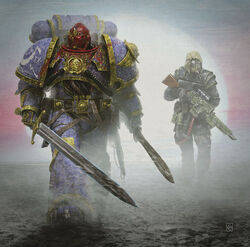
Sergeant Aeonid Thiel during the Calth campaign
- Battle of Calth (ca. 005.M31) - The Battle of Calth, also referred to as the Calth Atrocity, was the name given by later Imperial scholars to the treacherous campaign conducted during the early stages of the Horus Heresy in the 31st Millennium by the traitorous XVIIth Space Marine Legion, the Word Bearers, on behalf of the Warmaster Horus against their hated rivals, the XIIIth Space Marine Legion, better known as the Ultramarines. The campaign was launched by the Word Bearers' Primarch Lorgar Aurelian with the goal of exterminating the XIIIth Space Marine Legion outright. The purpose of the Word Bearers' invasion of the Ultramarines' Realm of Ultramar in the Eastern Fringe of the galaxy was to tie down the XIIIth Legion and prevent them from reinforcing their fellow Loyalists as the Traitor Legions marched relentlessly on Terra itself. The crux of the campaign came on the Agri-world of Calth in the Ultramar Sector, where the Ultamarines successfully broke the Word Bearers' surprise assault after a viciously-fought siege action, though at the cost of terrible casualties and the complete destruction of Calth's atmosphere and once-verdant biosphere. As a result of the devastation wrought by the Word Bearers during the Calth Atrocity, future generations of Calth's people were required to live deep underground in massive subterranean hive cities to escape their world's radiation-scorched, airless surface. While both the Ultramarines and their Primarch Roboute Guilliman survived the Word Bearers' assault, the campaign successfully prevented the Ultramarines from participating in the Battle of Terra as Horus had planned.
- Shadow Crusade (ca. 006.M31) - Enraged beyond the capacity for speech by the Word Bearers' betrayal of the Imperium and assault upon Ultramar, Roboute Guilliman gathered what vessels he could spare after Kor Phaeron’s ambush of the Legion fleet at Calth, drew additional numbers from the first Ultramarines relief fleet bound for Calth after the massacre above that world, and tracked Lorgar directly through the use of the XIIIth Legion’s own astropathic choirs. In the wake of the Battle of Calth, the Word Bearers Legion, led by the Primarch Lorgar, linked up with Angron and his World Eaters Legion to launch a Shadow Crusade against the Realm of Ultramar's Five Hundred Worlds in an attempt to spread the massive Warp Storm known as the Ruinstorm that had been conjured by the Word Bearers' First Chaplain Erebus at Calth across the Eastern Fringe. This prodigious Warp Storm would effectively split the galaxy in half and deny needed reinforcements to the Loyalists as Horus drove on Terra in an attempt to overthrow the Emperor of Mankind. The Shadow Crusade lay waste to 26 worlds until Guilliman's retribution fleet finally caught up to the Traitors above Angron's homeworld of Nuceria, which the World Eaters Legion were preoccupied with wiping clean of all life in vengeance for the treatment the Nucerians had merited out a century before to Angron. The XIIIth Legion's warship Courage Above All, Guilliman's temporary flagship, broke Warp at the system’s edge, at the head of a large void armada consisting of 41 vessels. In their wrath, the Ultramarines destroyed the Word Bearers' flagship Fidelitas Lex during the furious void combat. Eventually, the Ultramarines managed to take the fight to the surface. The first Ultramarines poured forth from their Drop Pods but the World Eaters were waiting for them. The XIIth Legion crashed against the XIIIth in rabid packs, showing why Imperial forces had feared to fight alongside them for decades. Uncontrolled, unbound, unrestrained, they butchered their way through Ultramarines strongpoints, enslaved to the joy of battle because of the Butcher's Nails cortical implants sandwiched within the meat of their minds. The XVIIth Legion also met their enemy cousins, replacing ferocity with spite and hate. The Ultramarines returned it in kind, hungry for vengeance against the vile Traitors who had defiled Calth and damaged its star. Eventually Guilliman confronted Lorgar, and the two Primarchs came together in furious combat as their warriors killed each other around them, and neither Primarch spared their sons a glance. But in the midst of their life-and-death struggle, the Word Bearers' Primarch, Angron, intervened and confronted Guilliman. Guilliman held his own against the pair of Traitor Primarchs, but took multiple wounds for his efforts. Eventually Angron managed to plunge his Chainsword up under Guilliman’s breastplate, leaving him with a serious wound. Despite the strife raging around them, Angron still fought Guilliman, standing above the kneeling Ultramarine. Guilliman was beaten and down. His wounds bled profusely, a palette of proud defeat. Guilliman's warriors fought desperately to retrieve him. Fortunately they were granted a brief reprieve, as Lorgar's incantation locked up Angron's muscles, and began to transform the Red Angel into a new form as a Daemon Prince of Khorne. Guilliman took the opportunity to escape into his sons' defiant phalanxes, retreating in enviable unity. Lorgar saw the expression of disgusted awe on his brother's face as the wounded Ultramarine stared at the transformed Angron atop the mound of dead sons from all three bloodlines of Space Marines. The XIIIth Legion continued to fire even in retreat, leaving the world of Nuceria battered and bloody. Their campaign against the two Traitor Legions had ended at Nuceria...for a time.
- Great Scouring (Unknown.M31) - As one of the largest remaining Loyalist Legions that emerged relatively unscathed from the Horus Heresy, the Ultramarines Legion played an instrumental part in the Great Scouring. This was the Imperium of Man's great counter-offensive against the Traitor Legions of the slain Warmaster Horus, following the end of this lamentable civil war after the Battle of Terra. Before actually being confined within the life support mechanisms of the Golden Throne, the Emperor had pronounced judgment on the Traitors: declared Excommunicate Traitoris, they were to be driven into the hellish region of the Warp rift called the Eye of Terror, which would hold them for all eternity. All records and memory of the Traitor Legions were to be expunged from the Imperial archives. Worlds such as Istvaan V and Davin were scoured clean of all life because of their corruption by Chaos. The Traitor Legions' associated troops from the Dark Mechanicus or the regiments and starships of the Imperial Army that had turned to Chaos were to be destroyed or driven into the Eye. It would be as if the Traitor Legions had never existed to sully the Imperium with their betrayal. The fighting would continue for another seven years. The Loyalist Space Marine Legions destroyed at the Drop Site Massacre on Istvaan V were slowly reestablished using what little gene-seed the survivors had managed to escape with, though the Legions were refashioned as 1,000-Space Marine Chapters rather than full Legions as Primarch Roboute Guilliman's Codex Astartes now required after the Second Founding at the dawning of the 32nd Millennium.
- Reunited (646.M32) - A one-hundred-standard-year period of anarchy is ended by the intervention of the Space Marines. Agnathio, Chapter Master of the Ultramarines, unites over fifty Chapters of Space Marines and arrives upon Terra. Agnathio holds a locked council with the squabbling noble "rulers" of Terra. What is said has never come to light, but when the Space Marine fleets return to their homeworlds, there once again sit twelve High Lords of Terra, and unity is restored to the Imperium.

The Ultramarines make a tactical advance
- 9th Black Crusade (537.M38) - The 9th Black Crusade was a Black Crusade led by the infamous Chaos Champion Abaddon the Despoiler and his Black Legion, launched out of the Eye of Terror in 537.M38. During this time, the Lamenters Space Marine Chapter was recalled along with a number of other Crusading Chapters by the High Lords of Terra to help deal with the rising threat of incursions from the Eye of Terror. But the Lamenters' fell reputation for suffering bitter reversals and dark turns of fate worked against them during the Chaos attack on the Hive World of Corillia during this campaign. The superstition-bound Mortifactors Chapter refused to fight alongside the Lamenters, abandoning the planet rather than serve beside them. Unwilling to desert the Hive World's population, the Lamenters held out alone against the Black Legion's onslaught for six standard weeks, suffering horrendous losses until the Ultramarines and White Scars led a battle group that broke though the Chaos warfleet to relieve Corillia. Reduced to barely 200 surviving Battle-Brothers by their sacrifice, the Lamenters were deemed lost when their fleet disappeared in a Warp Storm soon afterwards, only to reappear more than a standard century later on the edge of the Segmentum Solar, having slowly battled their way back from the outer void.
- The Jorun Retaliation (143.M41) - En route to service in the Gothic War, an Imperial Guard battlegroup, the 15th Heraklion Ironclads, turned on their Commissariat detachment and went Renegade. Investigations into this turn of events uncovered the foul xenos taint of the Dark Eldar, who had managed to ensnare and corrupt General Jorun and his command structure. The Traitor General Jorun and his attached former Imperial Navy battlefleet raided planet after planet, enslaving whole populations for their foul xenos masters. The full Howling Griffons Chapter was given command of a strike force to deal with the Traitors, with support from the Ultramarines and Sons of Orar Chapters of Astartes for a campaign that became known as the Jorun Retaliation. The Traitor Guard force was intercepted as they made planetfall on the Feral World of Asturia. Caught unprepared for such a fierce counter-assault, over 5,000 Renegade Guardsmen died in the first hour of the ferocious Space Marine attack, torn apart on their landing zones with much of their heavy armour yet to be unlimbered. General Jorun eventually met the Emperor's judgement at the hands of the Howling Griffons Chaplain Armand Titus. The Traitors' morale collapsed with the death of their leader and the swift desertion of their foul xenos allies. The disordered and panicked Heraklons were ruthlessly hunted down and slain in the aftermath; the Renegade forces had been completely wiped out within only six hours of the battle's opening salvos.
- Charadon Campaign (698.M41) - In 698.M41 the Ultramarines took part in a combined Space Marine force led by their Chapter Master Marneus Calgar, which consisted of elements of the Angels of Absolution, the Lamenters, the Marines Errant, and the Silver Skulls. During a seven-year-long Imperial Crusade the force inflicted a series of major defeats on the Ork empire of Charadon which delayed the invasion of the Imperium by the WAAAGH! Argluk for thirty standard years.

The Ultramarines valiantly defend their homeworld during the Battle of Macragge
- The Battle of Macragge (745.M41) - Hive Fleet Behemoth was spearheading a large Tyranids invasion force into Imperial space and were making unprecedented progress towards the Realm of Ultramar. Upon learning of the threat posed to Ultramar by the vicious Tyranids, Chapter Master Marneus Calgar at once drew up his plans. Calgar declared that the Hive Fleet would be halted at Macragge before it consumed more of Ultramar or drove deeper into the heart of the Imperium. Deeming Macragge to be the star system most immediately threatened, Calgar ordered its formidable defences to be further improved. Scant weeks later, the outrider vessels of the Tyranid fleet attacked Macragge. With the Hive Fleet destroyed after the sacrifice of an Imperial Battleship which created a Warp vortex that destroyed the majority of the Hive Fleet, Calgar's surviving starships came about and roared back to Macragge to try to save the beleaguered polar garrisons. Calgar, feeling that the situation was becoming critical, sent the 3rd and 7th Ultramarines Companies ahead in their fast Strike Cruisers while his remaining damaged ships limped back to Macragge. Despite horrendous losses inflicted upon the Tyranid fleet from the orbital and polar defence grids, many Tyranid organisms were able to reach the surface of the planet. The Tyranid swarm swept across the planet with the most intense fighting in the region of the northern polar defence installations. Despite the Ultramarines fleet's ability to destroy the Tyranid bio-ships, horrific casualties were suffered by the planet's population as well as the Chapter. Calgar went down to the planet's surface, leading the 3rd Company against the ravenous hordes of the Great Devourer. The entirety of the elite 1st Company was wiped out to a man whilst defending the northern pole's defence grid. The Ultramarines 1st Company was gone and the 3rd and 7th sorely diminished. It would be many long years before the Chapter could properly replace its losses from the Battle of Macragge, but replace them it would.
- The Purge of Thrax (762.M41) - Chapter Master Marneus Calgar lead the remnants of his Chapter against the Daemon-corrupted Adeptus Mechanicus Forge World of Thrax in 762.M41. Under the leadership of their Chapter Master, the Ultramarines banish countless thousands of daemons and recover crucial Imperial data-records from the twisted manufactorum complexes. With the mission complete, Calgar issues the order for Exterminatus.
- Siege of Zalathras (797.M41) - Marneus Calgar, Chapter Master of the Ultramarines, holds the gate alone against an Ork horde for a night and a day.
- A New Power Rises (799.M41) - The Ultramarines begin to fortify the eastern bounds of their realm of Ultramar against the emergent forces of the upstart Tau Empire.
- The Forgoil Campaign (805.M41) - WAAAGH! Gutshredda rampages through the Forgoil System. Marneus Calgar leads 3 companies to the assistance of the Forgoil Planetary Defence Forces. In a little more than three weeks, the Ultramarines destroy the tellyporta ships and Stompa factories that provided WAAAGH! Gutshredda with much of its momentum. In the final battle of the war, Calgar and his Terminator-armoured retinue board and destroy Gutshredda's flagship, Da Supadestructa.
- The Ironblood Campaign (822.M41) - Warpsmith Grathax descends upon the world of Ironblood with an army of Daemon Engines laying waste to everything in their path. They are soon met in open battle by several Imperial Guard tank regiments and over a hundred Ultramarines main battle tanks under the command of Brother-Sergeant Chronus. The ensuing battle lasts for three solar days, and enough ordnance is expended to flatten several cities, before the last Warp-forged machine is finally destroyed. Over a thousand smoking wrecks litter the scarred landscape, creating a tank-graveyard so vast that it is visible from orbit.
- The Chapter Endures (841.M41) - The Ultramarines' 1st Company's operational strength exceeds fifty percent for the first time since the Battle of Macragge.
- The Hallowed Stars' Scouring (848.M41) - Chief Librarian Tigurius' mysterious insights lead to the Hallowed Stars' Scouring.
- A Hero Honoured (849.M41) - Captain Cato Sicarius is appointed as High Suzerain of Ultramar.
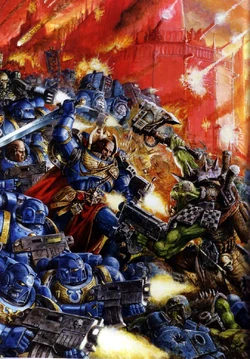
Captain Cato Sicarius leads the Ultramarines 2nd Company against the Orks during the Assault on Black Reach
- Assault on Black Reach (855.M41) - WAAAGH! Zanzag invades the Hive World of Black Reach. By the time Captain Cato Sicarius and the 2nd Company of the Ultramarines arrive in orbit, the Orks, using devastating new weapons, have already overrun much of the planet. Sicarius and his Battle-Brothers immediately deploy to reinforce Ghospara, the besieged capital hive city of Black Reach. The Ultramarines' Drop Pods land hard on the heels of an orbital bombardment and in a brief but bloody battle, cast the Orks from Ghospora's walls before setting off in search of Zanzag himself. Captain Sicarius prosecutes a deadly search-and-destroy mission, razing several Ork forts along the Blackwallow River, but Zanzag continues to evade him. When Sulphora Hive comes under attack from a massive Ork horde, Sicarius hands the hunt over to Veteran Sergeant Toria Telion and his Scouts. Telion soon discovers that the Orks are transporting warriors and weapons across the Blackwallow River by means of crude submersibles and tracks them to a vast natural cave -- Zanzag's base of operations. Sicarius immediately gathers what forces can be spared and boards a Thunderhawk gunship to assault Zanzag's Lair. The Orks are taken completely by surprise by the speed and ferocity of the attack; Heavy Bolter shells and Hellstrike Missiles tear into their formation before they realise they are under attack. Within moments, the Thunderhawk's front ramp slams open and Captain Sicarius leads his Space Marines into the heart of battle, striding forwards with Bolters blazing. Scores of Orks fall, their bodies heaped around the shattered stalagmites of the cavern floor, before they can mount a counter-attack. Zanzag directs the firepower of his Boyz' supa-weapons, but their shots prove nearly worthless against the inviolable armour of the Terminators marching at the fore of the Ultramarines' assault. It takes an hour of bloody fighting to secure the cavern, but the Orks are finally defeated when Sicarius cuts their Warlord's head from his shoulders and ends the threat of WAAAGH! Zanzag with a strike from his Power Sword.
- The Assault of M'kar (878.M41) - Chaos pirates, led by the Daemon Prince M'kar the Reborn, claim several uninhabited worlds on the borders of Ultramar. In a decisive battle in the Halamar Rift, Captain Sicarius destroys much of the pirate fleet, but M'kar the Reborn escapes into the Warp.
- Battle of Orar's Sepulchre (888.M41) - An Eldar emissary from the Biel-tan Craftworld was sent to the Imperial world of Commrath to enter negotiations with its Planetary Governor for the return of an ancient eldritch artefact from the tomb of one of the Ultramarines' most-lauded heroes, Captain Orar, known as the Sceptre of Galaxian. When the Imperial noble refused his request, the Eldar emissary grew angry and soon his pleas turned to threats of violence. The Planetary Governor refused to be cowed by the arrogant xenos and had the Eldar executed on the spot. However, the Governor had the foresight to heed the Eldar's threats and requested aid from the Ultramarines. Eldar from the Alaitoc and Iyanden Craftworlds then proceeded to assault the planet Commrath to recover the Eldar artefact within Orar's Sepulchre. Orar was a great Ultramarines hero in the aftermath of the Horus Heresy, and Chapter Master Marneus Calgar vowed not a single alien would breach the sanctity of his tomb. For the first time since the Battle of Macragge, Calgar lead his entire Chapter to war. The Eldar descended upon Orar's Sepulchre to find it held against them by the Ultramarines. Eldar Aspect Warriors and Guardians darted towards the main gates of the great edifice that was Orar's tomb as grav-tanks and artillery engines battered the Imperial defenders. On Calgar's command, the Ultramarines emerged from cover and scoured the invaders from the Sepulchre's steps with disciplined Bolter volleys. The Eldar fell back, only to find their lines of retreat cut off by Assault Marines and Land Speeders. Eldar leaders emerged from cover and rallied the trapped first wave, only to fall to sniper fire as the Ultramarines' Scouts made their presence known. The initial Eldar assault faltered but, for an entire day and night, they continued to attack. Though they mustered every arcane science at their command, they could not overcome the tactical brilliance of Marneus Calgar and his Ultramarines. The following day, a fresh assault swept onto the great stairs of the sepulchre, led by a colossal figure wreathed in flame -- an Avatar of Khaela Mensha Khaine, the Eldar god of war. Heavy weapons fire seemed only to anger the creature, and the Ultramarines' battle line buckled beneath its onslaught, so Calgar issued a challenge himself. The fiery god bellowed with fury, its first blow missing the Ultramarines' Chapter Master by a hair's breadth. The second tore plates from Calgar's armour. A third bit deep into his shoulder, driving the Chapter Master to one knee. But the fourth slammed into the armoured palm of Calgar's left hand. Rising up, Calgar struck with all his strength, bringing his other gauntlet around in a mighty arc that punched clean through the molten ichor of the Avatar's torso. With the fall of their war god, the Eldar lost all heart and retreated. Some fled without heed while others fell back in good order, but all of the xenos retreated into the darkness. Despite overwhelming odds, once again the Ultramarines had emerged victorious, but in his wisdom Calgar knew that the Eldar would return for the Sceptre of Galaxian. So it was that Calgar informed Commrath's Governor that the Galaxian Sceptre would be removed from Orar's Sepulchre to Macragge, where it could be properly defended.
- The Morix Assault (900.M41) - The heavily-defended Tau outpost on Morix Prime is eliminated in a rapid strike by the Ultramarines 4th Company.
- The Darkhold Ambush (921.M41) - Marneus Calgar is ambushed by the Night Lords whilst en route to the Darkhold battle zone. The Chapter Master's crippled vessel makes planetfall on the sparsely settled Imperial Feudal World of Barathred. Several hundred Night Lords Chaos Space Marines make landing shortly thereafter, but Calgar rallies the planet's feudal population to defeat them.
- The Great Bastion of Andraxas (922.M41) - Chief Librarian Tigurius leads an Ultramarines strike force to rescue a delegation of Tech-priests from the Ork invasion of the world of Andraxas. Within the towering mega-fortress known as the Great Bastion, the Adeptus Mechanicus Tech-priests had unearthed a Force Staff that bore the electoo recognition codes of none other than Malcador the Sigillite. The Ultramarines strike with pinpoint accuracy and great fury, only to find that the Ork forces upon Andraxas have such a high degree of aerial supremacy that they can scramble a dizzying amount of reinforcements to the Great Bastion. Given that the Bastion is the only part of the planet that has not already been subjugated by the Greenskins, the Orks flock to the fight in impossible numbers. Tigurius and his men are outnumbered fifty-to-one, and are about to commend their souls to the Emperor when the air shimmers and the Legion of the Damned burst into realspace. The slaughter that follows is nothing short of inspirational. Flaming volleys of Bolter shells blast Orks to bloody scraps on every wall and gulley. Tigurius renews his attack, only to find the morale of the xenos invaders has been devastated by the sudden and inexplicable strike. The Great Bastion is secured and used as a base for the subsequent evacuation of the world's surviving Imperials. The Force Staff is recovered and examined by the Mechanicus and then by Tigurius himself, yielding secrets about the Golden Throne's construction and a greater understanding of the sacrifice its master made in the name of the Imperium. It is still in the Chief Librarian's hands to this day.
- The Trenor Uprising (929.M41) - Three dozen Ultramarines Scout Marines, under the expert direction of the famed Sergeant Telion, put down a rebellion against the Imperium on Trenor in less than a day.
- M'kar's Revenge (935.M41) - A daemonic horde under the direction of the Word Bearers Daemon Prince M'kar the Reborn seizes control of the star fort Indomitable in Calth's outer orbit. Under the command of Marneus Calgar, Terminators from the Ultramarines 1st Company board the star fort. M'kar is slain by the hand of Lord Macragge, who tears the upstart Daemon Prince limb from limb.
- The Second War for Armageddon (941.M41) - WAAAGH! Ghazghkull descends upon the Imperial Hive World of Armageddon in the Segmentum Solar, initiating the Second War for Armageddon. The Orks are defeated only by the extreme stubbornness of the defenders and the combined might of the Blood Angels, Ultramarines and Salamanders Chapters. Thought dead by his foes, the wily Ork Warlord Ghazghkull himself escapes into space.
- The Cleansing of Malbede (963.M41) - The Ultramarines clash with a Tau expeditionary fleet for control of the cursed planet of Malbede. When the conflict awakens the Necrons hidden on Malbede, the Ultramarines and the Tau join forces to defeat the emerging Necrons. In the wake of the battle, Marneus Calgar initiates Exterminatus on Malbede, but allows the Tau to evacuate before the planet is destroyed.
- Dark Rain at Vallenin (967.M41) - Despatched to free the enslaved population of the Agri-world of Vallenin from the Dark Eldar Kabal of Lethal Guile, the Ultramarines' 3rd Company is sorely pressed by the xenos' grav-craft, until their Hunters deploy to reap a great tally amongst the swift craft.
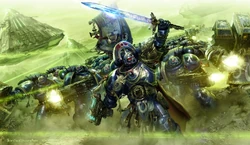
Captain Cato Sicarius leads the Ultramarines 2nd Company against the vile Necrons on the world of Damnos
- The Damnos Incident (974.M41) - The Ultramarines 2nd Company under the command of Captain Cato Sicarius rescues survivors from the doomed world of Damnos, an Imperial Civilised World and Mining World that was also a Necron Tomb World. The Necrons awakened and launched a massive assault upon all life on the planet's surface, while Damnos' Planetary Defence Force and Imperial Guard regiments proved unable to defeat the hideous cybernetic xenos. The Ultramarines made a defiant stand at the planetary capital city of Kellenport, holding the Necrons back as the evacuation of the planet's Imperial population proceeded during what became known as the Damnos Incident. Chief Librarian Tigurius is found wherever the Ultramarines are hardest pressed, shattering the advancing Necrons with the fury of his mind and summoning psychic shields to cheat the machine lifeforms of their prey. The actions of Venerable Dreadnought Agrippan are just as heroic, and for three hours he holds Kellenport's western gate alone and unaided, obliterating all who oppose him. By the time Kellenport's defenders are driven back to their last bastion of defence, only forty Space Marines and twenty Imperial Guardsmen remain planetside. Agrippan is lost in these last few minutes, his frame pinned between a dozen streams of Gauss Weapons fire. As Thunderhawks speed Tigurius and the last survivors to safety, Agrippan's fusion reactor explodes, obliterating the spaceport and every Necron within it.
- Skirmish with Hive Fleet Perseus (976.M41) - Hive Fleet Perseus is detected by the Ultramarines in 976.M41. Spearheading an assault, Chapter Master Marneus Calgar was severely mauled, losing all four limbs as well as large areas of body tissue and his left eye. He underwent extreme augmetic surgery and has had most of his missing body parts replaced with bionics.
- The Liberation of Lagan (989.M41) - The Ultramarines 3rd Company liberates the Lagan System from the Tau Empire.
- The Second Tyrannic War and the Battle of Ichar IV (993.M41) - The Ultramarines quash a rebellion on the industrial world of Ichar IV, only to find themselves at the forefront of a desperate defence against Hive Fleet Kraken. Accompanied by Chaplain Ortan Cassius and Veterans from the First Tyrannic War, Calgar launches a daring assault that severs the Tyranids' synaptic control through the Hive Mind, a battle won in no small part due to the fury with which Cassius leads his brothers into the fray. In a replay of history, Marneus Calgar, having narrowly escaped death at the hands of the Swarmlord during their confrontation on Macragge, faces the genetic reincarnation of the same beast on the blood-soaked fields. This time, however, Calgar triumphs, slaying the beast with his bare hands. However, the Space Marines' victory comes too late to save the planet itself, for the Tyranids had already reduced it to a smoking charnel house of death and destruction. Perhaps worse for the Imperium, the Hive Mind re-absorbed the Swarmlord's consciousness yet again, and having learned from its defeat, the beast's next reincarnation would prove to be more cunning and dangerous than ever before. Elsewhere, the Eldar Craftworld Iyanden is ravaged by other tendrils of the Kraken. Two Space Marine Chapters -- the Scythes of the Emperor and the Lamenters -- are all but wiped out and hundreds of Imperial worlds are lost to the Tyranids before the incursion is blunted.
- The Taking of Bridge Two-Four (997.M41) - At the Battle of Bridge Two-Four on the planet Thracia, Sergeant Uriel Ventris succeeds Captain Idaeus as the acting commander of the Ultramarines 4th Company. Idaeus passes on his Power Sword, a symbol of his office, then valiantly sacrifices himself against an overwhelming force of Chaos Space Marines in order to capture a vital objective.
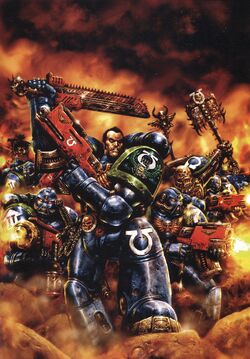
Captain Uriel Ventris leads the Ultramarines 4th Company in the defence of Tarsis Ultra
- The Third Tyrannic War and the Defence of Tarsis Ultra (997.M41) - Elements of the Ultramarines and Mortifactors Space Marine Chapters, led by Chaplain Cassius, make a stand against one spur of the Tyranids' Hive Fleet Leviathan on the world of Tarsis Ultra. The defenders defeat this tendril of the Leviathan with an engineered anti-Tyranid biological plague, but the remainder of Hive Fleet Leviathan rampages on unabated.
- The Liberation of Graia (Unknown Date.M41) - The Forge World of Graia in the Segmentum Tempestus, home to the Titan Legion known as the Legio Astraman ("The Morning Stars"), was assaulted by the Ork WAAAGH! Grimskull, over a million Greenskins strong. The Imperial Guard's 203rd Cadian Shock Troops Regiment was diverted to Graia and made a combat drop, but was unable to stem the green tide and the Adeptus Mechanicus feared that the world and its extremely valuable Battle Titan-manufacturing facilities would fall into the Orks' hands, representing a major threat to the Imperium. To deal with this threat, the Ultramarines despatched the 2nd Company, at this time under the command of Captain Titus, to assist the Imperial Guardsmen. After launching an assault on the Ork flagship in orbit of the world in the hope of slaying the Ork Warboss Grimskull outright, Titus and two members of his company's command squad were forced to land on the planet itself. They proceeded to engage the Ork forces and ultimately to unmask a plot of the Chaos Sorcerer Nemeroth and his warband of Chaos Space Marines, the Chosen of Nemeroth, to seize experimental technology on Graia that would allow Nemeroth to ascend to become a Daemon Prince with Graia as his Daemon World. In the course of the Graian campaign, Titus successfully slew Grimskull in single combat, thus ending the Ork threat as the Greenskins withdrew from the world as their various clans began fighting for control of the WAAAGH! Titus also faced Nemeroth as he began his ascension to daemonhood and slew the foul sorcerer, banishing his soul to the Warp and ending his plans for Graia. Detachments of the Blood Ravens and Black Templars Chapters then arrived to aid the Ultramarines and the remnants of the Imperial Guard in securing the Forge World. However, during the crisis on Graia, Titus had displayed both a disregard for the strictures of the Codex Astartes and had been curiously unaffected by Nemeroth's Chaotic sorcery. Fearful that his commander had become tainted by Chaos, his subordinate Leandros made his concerns known to the Inquisition. Inquisitor Thrax, who had arrived on Graia with the Black Templars, took Captain Titus into custody for interrogation and the determination of his purity. The Liberation of Graia took place in an alternate universe where Titus rather than Cato Sicarius was the Captain of the 2nd Company.
- Return to Damnos (999.M41) - Despite the Inquisition's efforts to suppress all knowledge of the Necrons' reemergence into the galaxy, the Imperium's faith in its military supremacy was shaken by the news that spread across the galaxy after 974.M41 that these xenos had overcome both the Imperial Guard and the Ultramarines at Damnos. Eventually, reports of the loss of Damnos made their way to Terra, where both the Fabricator-General of the Adeptus Mechanicus and the High Lords of Terra decreed that the Ultramarines must return to Damnos and eradicate the Necron threat once and for all. Twenty-five standard years after the Damnos Incident, in 999.M41, this Imperial order was brought to Macragge by the experienced Deathwatch strike team led by Squad Lazarius. Chapter Master Marneus Calgar was not pleased with the Imperium's decree, for he knew that his 2nd Company had faced only a fraction of the awakened Necrons on Damnos a quarter of a century before. Once they returned to Damnos, the Ultramarines would face the entire strength of a Necron Tomb World and risk the deaths of hundreds of the Chapter's Astartes. Yet, Calgar knew that the High Lords of Terra were right and that the Necrons on Damnos must be defeated if the Imperium was ever to know peace in the face of the growing Necron threat. With the record of the Ultramarines stained by the action on Damnos, it was their duty to banish the ghosts of the past. Upon hearing Calgar's announcement that the Ultramarines' 1st, 2nd, 3rd, 5th, and 6th Companies, accompanied by elements of the 10, would return to reclaim Damnos for the Emperor, Cato Sicarius smiled for the first time in decades. It is said that during the preparation for the assault, Sicarius trained so hard that he fought with the fury of a man possessed and even slept in the cage-vault. Before the solar month was out, Calgar's armies and fleets had been assembled and over 500 Space Marines stood ready for war. In addition, Sicarius was granted a Vortex Grenade by the Deathwatch Sergeant Davian Imocles, who was rumoured to be an old friend and former squad mate. The journey to Damnos was a perilous one, with Calgar relying on various ruses and distractions to get his warriors safely to the planet's surface. By the time the Necrons had spotted the true location of the Ultramarine warships, the Astartes fleet was in a position to launch their Drop Pods. The first wave consisted of unmanned variants designed to draw the fire of the Gauss Pylons. The second wave, however, represented the true assault, which brought hundreds of Space Marines as well as a number of vengeful Imperial Guard regiments to the heart of the Necrons' subterranean tomb complex. Their objective was to destroy the pyramidal complexes that controlled the Necron power grid and to do it before the Imperial forces were overwhelmed. However, one factor that they did not account for was the physical incarnation of a C'tan held within a Tesseract Vault. It was determined that this vault was the true source of the Necrons' power and must be neutralized if the Imperial forces were to have any hope of victory. Despite the power brought to bear by the Imperial assault on Damnos, Marneus Calgar felt like a duelist being taken apart by a superior foe in the battle-cage. The xenos' battle logic proved impeccable, with its master intelligence anticipating the Ultramarines' every move and neutralizing each tactic they employed. Thanks to an energy shield emitting from the vault, every plasma volley and melta blast employed against the Necron Monoliths dissipated harmlessly or detonated prematurely before it could harm the constructs. Since the xenos had managed to analyze the Ultramarines' battle doctrine, Calgar realized he must attempt a completely unexpected stratagem. Assaulting the ranks of the Necron Immortals, the Chapter Master jumped onto the metallic base of a malfunctioning Gauss Pylon and slowly pushed the war engine's crescent back until its viridian beam hit the energy shield of the floating necropolis. With a blinding flash of light, the energy shield protecting the tomb complex collapsed and the Tesseract Vault was broken wide open to reveal the enraged demigod imprisoned within. A giant cruciform of pure light rose above the Necron army, the remnants of the C'tan's energy cage still crackling around it. Roaring in exultation at its newfound freedom, the booming sound threw Ultramarines and Necrons alike to the icy ground and cracked the planet's crust. Its first victim would be the Necron Overlord, the Undying, which the star god crushed with ease by transforming the earth around his metallic form into an oversized fist. The Overlord phased out of reality, seeking to escape back to his subterranean lair. But deep underground, the surviving members of the Deathwatch's Squad Lazarius had reached their own objective. The Undying teleported back to his cabled sarcophagus right in front of the Deathwatch's eyes. Unfortunately for the Necron, the crack team of Astartes had replaced his revivification engines with melta charges and entropic destabilisers and proceeded to blast the Necron Overlord into atoms. Back on the surface, the xenos reeled from the loss of their leader and the artificially intelligent command programs that had governed their warriors' every action. Meanwhile, the unleashed C'tan lashed out in fury at both its Necron enslavers and the Ultramarines as Captain Sicarius duelled a Flayed Ones Lord. After ramming his Power Sword into the powerful Flayed One's torso, Sicarius summoned twenty-five years of anger and frustration into a final burst of strength. He unclipped the Vortex Grenade that had been given to him earlier and activated the weapon before throwing it at the enraged demigod hovering overhead. The grenade detonated and formed a spiralling orb of nothingness as its unstoppable force sucked the C'tan into the Warp before collapsing and winking out of existence. Sicarius felt a great weight lift in that moment, as he realised both he and the Ultramarines had been redeemed for their original failure on Damnos in the sight of the Emperor. Over the next few solar days, the Imperials eliminated the surviving Necrons with grim efficiency. Empty tomb complexes were collapsed or detonated under the guidance of the Deathwatch and the citizens of Damnos whom Sicarius had rescued decades before were restored to the world to reclaim it for their own.
- The Zeist Campaign (999.M41) - Captain Cato Sicarius leads an army to halt the Tau's Fourth Sphere Expansion. An Imperial Crusade later known as the Zeist Campaign drawn from 30 Space Marine Chapters drives the Tau back from dozens of Imperial worlds, but is recalled before its work can be completed to deal with the much greater threat of Abaddon the Despoiler's 13th Black Crusade.
- Defence of Ultramar (854.999.M41) - In the midst of the oncoming 13th Black Crusade, the Realm of Ultramar comes under renewed assault from the Forces of Chaos. The Daemon Prince M'kar the Reborn, clad in mortal flesh once again within the body of a former Ultramarines Dreadnought, leads the onslaught against the world of Talassar. Other Chaotic warlords under the control of the Iron Warriors Warsmith Honsou attack Calth, Espandor and Tarentus. Marneus Calgar recalls all Ultramarines forces to defend Ultramar, dispatching a reinforced Battle Company to each threatened planet. Calgar himself accompanies the 2nd Company to defend Talassar, determined to slay M'kar a hundred times over if need be.
- The Eye of Vengeance (870.999.M41) - In an exemplary display of his abilities, Scout Sergeant Telion single-handedly changes the balance of the war on Quintarn.
Realm of Ultramar

Departmento Cartographicae map of the Realm of Ultramar
One aspect of the Ultramarines Legion that survived the Second Founding was the close relationship between the Space Marines and the populations of the surrounding planets. During the Great Crusade the worlds around Macragge provided young recruits for the Ultramarines. They also supplied raw materials, armaments and spacecraft. Although the need to recruit from these worlds diminished almost to the vanishing point with the reorganisation of the Legion during the Second Founding, the tradition continued. To this day, the Ultramarines recruit not from a single world, but from the whole of local space. This area around Macragge is called Ultramar, the stellar empire of the Ultramarines. Ultramar is unique amongst the demesnes of the Space Marines. Where other Chapters rule over a single planet, asteroid or, in some cases, a mobile space fleet or orbital fortress, the Ultramarines have a larger demesne. They control no fewer than 11 local star systems, each with its own worlds and governments loyal to the Chapter.
Before the Horus Heresy the realm of Ultramar consisted of more than five hundred worlds, and was commonly referred to as "The 500 Worlds of Ultramar" or the somewhat heretical "New Empire." These 500 worlds were all themselves divided into fiefdoms. The largest was the Ultramarines' homeworld of Macragge, with the fiefdoms of the worlds of Saramanth, Konor, Occluda, and Iax all varying in size. Before the Word Bearers' surprise assault on the world of Calth during the Heresy there was talk of Calth gaining its own fiefdom due to its industrial output nearly rivalling that of Macragge before the Traitors destroyed its biosphere. The fiefdoms of Ultramar were ruled by a Tetrarch, who was an Ultramarines Captain or Chapter Master chosen for this position by Roboute Guilliman, the Primarch of the Ultramarines Legion. The Tetrarch would then choose both a military governor, an Emperor's Champion and his Honour Guard. After the Horus Heresy, when the Space Marine Legions were broken down into smaller 1000-man Chapters, the 500 Worlds of Ultramar were divided up and given over to the many Successor Chapters of the Ultramarines. The Ultramarines Chapter kept control of the original center of Ultramar, consisting of no fewer than 11 local star systems, each with its own worlds and governments loyal to the Chapter. All the worlds that once comprised the larger Realm of Ultramar share a common cultural heritage with Macragge, so it is not surprising that their styles of architecture, government, and societal traditions are similar.
After the Horus Heresy all 11 worlds benefited from the improving reforms of Roboute Guilliman and its citizens are disciplined, productive and loyal. As a result, Ultramar is a wealthy stellar empire within the larger Imperium that knows little unrest and no rebellion -- a somewhat unique distinction in the increasingly desperate days of the late 41st Millennium. The population lives in sprawling cities, but these cities are surrounded by extensive farmlands and seas that teem with fish.
Each of Ultramar's worlds is self-sufficient in raw materials and food. Trade between the planets is active, and each planet has its specialties and delicacies. Each world is balanced as a society and also as an ecosystem -- although composed of primarily industrial worlds, Ultramar has none of the nightmarish toxic wastelands that are common phenomena throughout the galaxy. It is therefore little wonder that many system governors and planetary lords across the Imperium regard Ultramar with an envious eye.
Ultramar is the feudal realm of the Ultramarines within the greater realm of humanity that is the Imperium of Man. Its worlds do not pay the Imperium's tithes. Instead they contribute directly towards the upkeep of the Ultramarines Chapter. The rulers of the individual worlds of Ultramar are feudal lords of the Chapter Master of the Ultramarines. This is why the Ultramarines leader is also the Lord of Ultramar, with all the rights and responsibilities that such a title entails. Just like other worlds in the Imperium, each world of Ultramar raises regiments for its own defence. Most worlds in the Imperium are obliged to provide regiments for the Imperial Guard when required, but Space Marine homeworlds are an exception. In the case of Ultramar, however, the Ultramarines rule so efficiently and are so prosperous that they maintain several hundred regiments ready and willing to join the Imperial Guard when the need arises. As a result, regiments from Ultramar have fought all over the galaxy, often in campaigns alongside the Ultramarines themselves. Each world of Ultramar also provides Space Marine recruits for the Ultramarines Chapter itself. Throughout Ultramar, proud citizens point to public statues of famous Ultramarines who were born to local families. Amongst the older aristocratic dynasties it is a matter of considerable esteem to send recruits to the Ultramarines. For a family to have provided a renowned hero, perhaps even an actual Master of the Chapter, is a great honour that brings considerable fame and status for many generations.
The Ultramarines are unique in that, unlike their fellow Astartes Chapters, they control nine habitable worlds, rather than a single Chapter planet, star system or fleet. Collectively, these star systems are known as the Realm of Ultramar, a sub-infeudated autonomous region of the Imperium of Man, with Macragge as the capital world. Macragge is a cold and rocky world with large, inhospitable polar regions, though certainly capable of sustaining human life. It is home to the Fortress of Hera, the Ultramarines' fortress-monastery. Ultramar is located in the galactic Southeast of the Eastern Fringes near the galactic Rim. The Eldar Craftworld Iyanden has been sighted in this sector and the expanding Tau Empire is also nearby. Twice Ultramar has stood in the path of a Tyranid Hive Fleet and the Tyranid threat in the Eastern Fringes remains strong. Macragge, the Ultramarines' homeworld and location of their fortress-monastery, is just one of the 11 worlds in the Realm of Ultramar. Macragge itself is mostly bleak and rocky, with more than three-quarters of its land mass formed from mountainous upland almost entirely devoid of life. The people of Macragge do not live in this inhospitable region, but the fortress-monastery of the Ultramarines is built here upon a craggy peak surrounded by impenetrable mountains. Within this mighty fortress, inside the vast Temple of Corrections, is the shrine of the Primarch Roboute Guilliman himself. This is where his body sits upon a huge throne of ornately-carved marble. He is preserved in death by a stasis field impervious to the decaying effects of time. This is one of the holiest places in the Imperium, and thousands come from all over the galaxy to look upon the face of the ancient Primarch. The other ten worlds are:
- Calth - Cavern World - Calth is an airless world whose inhabitants live in underground cities where the deadly light of Calth's blue sun cannot reach them. The caverns of Calth are constructed on such a huge scale, and with such grandeur, that they are as light and airy as any city of Macragge. Calth was once a verdant world whose people lived on it surface until the Word Bearers Traitor Legion launched a massive assault against the Ultramarines early in the Horus Heresy while the XIIIth Legion was gathering on the world for a joint campaign with the Word Bearers against the Orks. The aftermath of the resulting Battle of Calth led to the destabilistion of Calth's sun and forced the surviving civilians to flee underground. Of all the local worlds, Calth is the most specialised, for although its people grow vast quantities of food in nutrient vats, they prefer to import most of what they eat from the neighbouring system of Iax. Calth is famous for its orbital shipyards, which provide the spacecraft used by the Ultramarines as well as civil and military craft for wider use in the Imperium.
- Espandor - Frontier World - Most distant from Macragge is the world of Espandor, a planet of extensive forests whose major cities are confined to the westernmost of its two continents. Espandor is a secondary settlement whose people are the descendants of explorers from Macragge and hold considerable pride in their rugged existence. Tradition has it that Espandor was settled during the Age of Strife by merchants blown off-course and subsequently stranded by Warp Storms. It is the least densely populated of all the worlds of Ultramar.
- Iax - Garden World - Iax is sometimes described as the Garden of Ultramar. Its climate and fertility have made it one of the most naturally productive worlds in the Imperium. The inhabitants have harnessed the planet's inherent verdancy, covering its surface with well-ordered farms and cultivated woodlands. There are no large cities on Iax, but many small towns dotted over the landscape, connected together by an efficient system of fast hydroways. The oldest and most urbanised area of Iax is the ancient city of First Landing, whose citadel has withstood the barrages of invaders over the centuries. Legend has it that Guilliman came to Iax many times, and that he treasured the world almost as much as his beloved Macragge.
- Konor - Forge World - Konor is an Adeptus Mechanicus Forge World. Konor shares a common culture with the rest of Ultramar but technically is independent of the Lord of Ultramar's rule as it owes allegiance instead to the Fabricator General of Mars. However, Konor often relies upon the Ultramarines for its defence and the products of its manufactoriums are mostly intended for use by the Chapter.
- Parmenio - Parmenio is an Ultramarines Training World used largely for increasing the tactical and strategic skills of the Chapter's Neophytes.
- Prandium - Dead World - Prandium once teemed with life. Settlers from Macragge established a colony on the planet after the Horus Heresy. Thanks to a mild climate and fertile virgin environment, the people of Prandium prospered. The planet soon become the most beautiful jewel of Ultramar, a planet of remarkable prosperity and an incredibly rich native fauna. Prandium was destroyed by Hive Fleet Behemoth in the First Tyrannic War. The lifeless planet is now reduced to bedrock, its atmosphere blown into space by the ferocity of the Tyranid attack.
- Talasa Prime - Talasa Prime is an Inquisition Fortress World.
- Talassar - Ocean World - Talassar is a planet of storm-tossed seas and rocky islands whose single continent is known as Glaudor, which was the site of a major battle between the Ultramarines and invading Orks immediately after the Horus Heresy.
- The Triple Worlds (Quintarn, Tarentus and Masali) - Agri-worlds - These small planets form a triple world combination orbiting around a common centre of gravity much like the Earth and its moon. Gigantic horticultural cities cover hundreds of square miles, capturing precious water in wind traps and storing it in massive underground tanks. The cities of the Three Planets are enclosed by gigantic domes under which flourish forests and gardens as lush as any in Ultramar.
Legion Organisation
Pre-Heresy
From its earliest incarnations, the XIIIth Legion had remained true to the strictures of the Principia Bellicosa, as laid down by the Emperor and His advisors at the beginning of the Great Crusade. The warriors of the Legion were organised into standardised companies of approximately a thousand warriors, then into chapters, each of ten companies. Unlike many of their brother Legions, they made little attempt to re-codify the structure or vary the size of individual units. Instead, the War-born enshrined the basic strictures of this system as an honoured tradition of the Legion, one that was to see little modification even in its later years after the rediscovery of Guilliman, who expanded and elaborated on this structure, seeing in it great virtue, rather than replacing it. Roboute Guilliman also expanded on the XIIIth's practice of observing how others fared in battle and adopting modified versions of their comrade Legion's tactics where efficacious. This spoke to Guilliman's own predilection for analysis and observation, and in this case what the Primarch saw, he studied with a relentless precision, always seeking to distil and improve upon success and exceed the originator's accomplishments by the application of his intelligence and the diligence of his Legion. Such improvement was something he always believed a possibility, an attitude which at times brought the ire of some of Roboute Guilliman's peers.
The operational doctrines of the XIIIth favoured tactical diversity and the application of overwhelming force. As a reflection of this, the Legion maintained relatively few specialised companies, instead choosing to spread those units which maintained large stocks of non-standard equipment and munitions evenly throughout the various companies of the Legion. It was intended that every Ultramarines company would be individually capable of meeting the enemies of Mankind on any terrain and in any theatre of war with equal ability an emerge victorious, magnifying this power in combination with other chapters almost geometrically. To this end, each chapter featured a proportionate mix of tactical and assault units, armour and artillery as well as gunships and transports.
With the sub-division of the massed ranks of the XIIIth that occurred in the latter years of the Great Crusade, reforming it into more individual Crusade fleets than any other single Legion, the value of the doctrine was quickly re-established and built upon, the Legion attempting to standardise much of its equipment base and supplement it where needed with local patterns, which if not the most potent or advanced of their type required lesser resources to mass produce, in order to optimally meet the ever-expanding needs of its warriors. This factor itself would have great impact on the latter day development of Space Marine forces beyond the wars of the Horus Heresy.
While this doctrine of structured adaptability was to become deeply ingrained within many of the Legion's chapters, there were some notable deviations from this pattern. Some few individual chapters, through long held preferences or some quirk of supply, maintained notable strengths of non-standard equipment or personnel. The 4th and 22nd Chapters are the most noteworthy example of this, with the 4th, known within the Legion as the "Aurorans", operating roughly five times as many armoured vehicles as a standard chapter, while the 22nd, the so-called "Nemesis" chapter -- long a hold-out of its Terran-born contingents -- maintained large numbers of Space Marines equipped as destroyer units, and was one of the few Ultramarines formations to routinely be deployed especially to Exterminatus operations by the Legion. Roboute Guilliman was known to hold something of a distaste for such horrific weapons as fundamentally self-defeating; they destroyed the very ground on which they were used, which was to his doctrines a poor way to conquer or liberate a world. But this having been said, Guilliman held no outright ban upon such weapons' use in his Legion as Vulkan did, realising that in certain cases their use was all that would suffice, and strategically he would not let his Legion be without the ability to deploy phosphex, oxygen destroyers and even carbosilic cascades in extremes.
Some few chapters retained and employed variations of the older XIIIth Legion's sub-structures and heraldry, marking achievements of the Terran first generation of the "War-born" or the disparate origins of their warriors, but these had faded somewhat over the years as the body of the Legion's demographic changed to favour the sons of Ultramar. By the closing decades of the Great Crusade all, regardless of origin, followed the same detailed organisational scheme, with only minor variations allowing for personal heraldry and honours among its highest echelons. All twenty-five chapters of the Legion -- a vast notional strength of around 250,000 Legionaries by the time of the Horus Heresy -- comprised then a single cohesive force with a fully integrated command forming together for grand strategic assaults or operating flawlessly in smaller detachments to carry out individual actions under this flexible arrangement.
Legion Command Hierarchy
The XIIIth Legion operated under a strict hierarchy where each warrior's responsibilities and duties were known at all times. Roboute Guilliman had overall command of the Legion, deciding its disposition and strategic objective, as well as taking command of whichever fleet or war zone he was present in. Beneath the Primarch were the chapter masters, each of whom led approximately 10,000 warriors and a contingent of Ultramar's void fleet. Assisting them were the cadre of senior officers and commanders, the Legatii. Each chapter of the Legion contained ten companies each in turn of 1,000 Legiones Astartes commanded by a captain, who was responsible for the tactical deployment, efficiency and training of his warriors.
While the captains and chapter masters of the XIIIth Legion governed the crusading armies of the Legion, it was the parallel system of trenches and their own legatii who governed the many military institutions of the realm of Ultramar and were entrusted with its defence. Each Tetrarch was a military dictator of one of the five "king worlds" of Ultramar, and ruled over a sub-sector of that realm. The tetrarchs were appointed by the Primarch, who was himself Master of Macragge and the core worlds of Ultramar -- though his duties as governor of these worlds often fell on his Seneschal in practice, while he led the armies of the Emperor's Imperium on crusade.
The Lords of Ultramar
The Lord Martial of the domain of Ultramar in 007.M31:
The Tetrach Council
- Roboute Guilliman - Master of Macragge, Primarch of the XIIIth Legion and Lord of the Five Hundred Worlds
- Eikos Lamiad - Tetrarch of Konor
- Tauro Nicodemus - Tetrarch of Saramanth
- Eben Frain - Tetrarch of Occluda
- Stolos Amyntas - Tetrarch of Iax
Legion and Senior Commanders of Note
- Marius Gage, "First Master" - Chapter Master Primus of the XIIIth Legion
- Orfeo Cassandar - Legatus of the Evocatii and Seneschal of Armatura
- Valentus Dolor - Legatus of the Vigil Operatii, Provost-Magistratus of Ultramar
- Drakus Gorod - First Legatus of the Invictarus Assembly and Fief-commander of the Primarch's Guard
Specialised Ranks and Formations
Alongside the conventional order of battle with which the Ultramarines operated, several unique formations stood wholly apart from the traditional structure:
- Evocatii - The earliest of these non-standard formations to emerge were the Evocatii chapters, first introduced by Lord Commander Vosotho and later reorganised, expanded and renamed by Roboute Guilliman. The Evocati was the training ground of the Legion; comprising two double-strength chapters composed of both raw recruits from across Ultramar and beyond, as well as a core of war-hardened veterans. Where the late Lord Commander had once blooded these Neophyte warriors at the forefront of his campaigns, Guilliman assigned them first a tour of defensive operations within the borders of Ultramar in conclusion to a rigorous training regime which favoured both practical battle experience and more rigorous and more lengthy cerebral conditioning and memetic implantation than most other Legions undertook.
- Suzerain Invictarus - The most famed and potent of the XIIIth Legion's elite sub-formations were the Suzerain Invictarus. Known also as the Invictarii, this was a veteran cadre who served both as a Legion elite and as a pool of warriors who through their actions had singled themselves out for potential future high command, not simply by bravery or skill at arms, but also for displaying a talent in governance, organisation and administration. Their ranks formed the core outside the usual Legion structure devoted in no small part to the control and order of the Ultramarines writ of domain, and increased in number as the Legion itself expanded and the realm of Ultramar with it. The Invictarii formed the retinues of the five Tetrarchs of Ultramar, and functioned as both military force for the defence of that fiefdom, arbiters of law for the population and an Honour Guard for their commander in battle. The individual forces of these Suzerain Invictarus varied in size, with Tetrarch Amyntas maintaining a force of several thousand as feared peacekeepers in the troubled worlds around Iax, while Tetrarch Lamiad had but one hundred in his guard, partly in defence to the Mechanicum warriors who stood in Konor's defence and did not need aid in doing so. Outside of the Suzerain forces, members of the Invictarii could also be found in limited numbers spread through the Legion's veteran units and various sub-stratas of command (although by number only a fraction of all veterans, officers or sergeants ranked amongst them) gaining further battlefield experience and honing their skills by field command.
- Fulmentarus Terminator Strike Squad - Created by Roboute Guilliman after observing the Iron Warriors Tyrant Siege Terminator squads in battle, the Primarch judged the tactic worthy of refinement. He immediately ordered the creation of a number of similar units in his own Legion so that he might study and improve upon Perturabo's innovation, proving himself once again the master of all of the myriad disciplines of war. The warriors of the Fulmentarus are equipped with Cataphractii Pattern Terminator Armour, enhanced to carry an array of targeting systems that make it possible for each to combine their fire in a highly coordinated fashion. When combined with a heavy weapons system such as a Reaper Autocannon, or the Cyclone Missile Launcher first utilised by the Tyrant Siege Terminators, these sensors make the Fulmentarus a fearsome heavy assault unit and one that, were it not for the outbreak of the Horus Heresy, might one day have entered service across the Legiones Astartes.
- Locutarus Storm Squad - The Locutarus Storm Squads are elite units maintained in small number by the majority of chapters within the Ultramarines Legion, and deployed particularly in vanguard and strike formations. Each warrior of the Locutarus has been selected from the line assault squads having proven themselves the most skilled, courageous and ferocious of their brethren. Where the assault units of many other Legions are known for their savagery or even their outright bloodthirstiness, the Locutarus are universally iron disciplined and exacting of mien. They practice the arts of sword and pistol play with precision, their strikes perfectly times and placed to maximum effect. In battle, Locutarus Storm Squads are often held in reserves, their commanders waiting until the perfect moment to commit them to the battle, unleashed in one single charge to tip the outcome in favour of the Ultramarines. The Locutarus are superbly equipped to fulfil this role, each bearing an artificer wrought power sword which serves as a mark of honour and courage as much as a lethal tool of war.
- Vigil Operatii - Though rarely spoken of, there existed another agency of the XIIIth Legion at work within the borders of Ultramar. The Vigil Operatii, an organisation whose roots stretch back to the early days of Ultramar's founding, operating as a shadow arm of the military government of Ultramar, silencing those threats uncovered within the Five Hundred Worlds and holding custodianship over the various defence militias of its standing human armies. Little is recorded of their internal organisation, save that the warriors who made up their forces were at their core a body of augmented humans -- those aspirants whose minor deficiencies of mind or body barred them from joining the ranks of the XIIIth Legion, but not from service. This organisation reported to the Invictarus and went where a superhuman Legiones Astartes could not go covertly or easily, and in its manner may have been patterned at least in some part on the similar operatives of certain other Legions of more insidious mien, although with an assuredly ironclad code of conduct set for their operations.
Ultramarines Armoured Forces
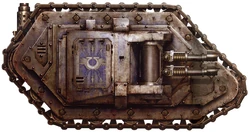
Ultramarines Land Raider Proteus, Lhatyrion Compact, 7th Chapter
The Ultramarines Legion was able to draw upon the wealth and resource of Ultramar and as such possessed extensive strategic reserves of munitions and material amassed over many years. Not least among these assets was the mighty fleet of war ships, many of which were constructed within the Five Hundred Worlds or, in the case of the very heaviest of classes, in the Forge Worlds of Thramas. Of equal importance to the Legion's ongoing operations were the large numbers of armoured vehicles which its chapters were able to call upon, and the Ultramarines were well versed in the many doctrines of armoured warfare. Each of the Ultramarines Legion chapters maintained its own stocks of armoured vehicles, allowing individual formations to deploy as befitted tactical and environmental conditions. All held large numbers of Rhino armoured carriers, used for the rapid conveyance of massed squads across open terrain, while many maintained sufficient numbers of Land Raiders to prosecute armoured spearhead assaults directly into the teeth of enemy positions. These transport vehicles were bolstered by armoured support echelons of Predator and Sicaran battle tanks, with long range bombardment being supplied by batteries of Whirlwind missile tanks and other patterns of mobile Legion artillery. One body within the Legiones Astartes Ultramarines maintained especially extensive numbers of armoured vehicles -- the 4th Chapter, known with increasing formality as the "Aurorans". This formation operated a wide range of tanks, but was especially well known for its expertise in the deployment of super-heavy engines including the Fellblade, Falchion and Glaive as well as other, far less well known or prototype classes.
Specialist Armoured Vehicles
The Ultramarines Legion armoured forces included a wide range of vehicle classes, patterns and types, including the very earliest patterns of war machines which were subsequently deployed in large numbers across the entire Legiones Astartes. Some of these had been kept operational by constant field repair and had not received the attentions of the Legion Forge for many decades. Conversely, the Legion's forces included vehicles only just beginning to see use, one of which was the Damocles pattern armoured carrier modified by replacing most of its troop carrying capacity with a suite of sophisticated communications equipment. Following the Ultramarines' example, this command and control platform was beginning to enter service across the Legions by the close of the Great Crusade, the sons of Guilliman leading by example and sharing their hard-won battle doctrines with their brother Legions.
The Ultramarines Fleet
In contrast to the vast numbers of Space Marines in the Ultramarines Legion, the naval assets of Ultramar were more limited. Historically, Roboute Guilliman had made a virtue of close alliance with the Imperialis Armada fleets of the Ultima Segmentum, and relied upon them closely when a particular campaign called for a powerful capital ship contingent to be employed or extensive orbital bombardments to be undertaken. The Primarch himself was known to have been observed in spheres of combat other than the impersonal long range clash of star ships many kilometres apart in the deep void, and greatly favoured his own Legion fleet to be optimised for close assault and maintained ships designed for invasion operations for this reason.
As a result, the Legion had never operated large numbers of the heaviest capital ships, retaining less than 30-35 of such craft at various points, having lost several in battle over time, notably the Legion's flagship among them during the disaster at the Osiris Cluster. Of those heavy capital ships which remained, most had served since the Legion's inception at the beginning of the Great Crusade and had been heavily refitted over time. Only a handful of the newer models of heavy capital ships had been assigned them since the Primarch Roboute Guilliman's command tenure had begun, although of these notably two were of the extremely powerful Gloriana class.
The main body of the Legion's void craft fleet was then made up of mid-scaled cruisers and smaller Battle Barges of various classes, along with substantial numbers of lighter pattern purpose-built Strike Cruisers, frigates and fast patrol cutters, all which could be produced by the shipyards of worlds across Ultramar. Although this fleet structure did allow the Legion a great deal of flexibility and range in how it deployed its many Space Marine chapters, its combined overall tonnage and firepower ranked the Ultramarines fleet in the mid-tier of the Legions, considerably behind the Imperial Fists, for example, and behind the Death Guard in terms of number of heavy capital units.
War Disposition
Prior to the orders to assemble on Calth for the Ghaslakh Crusade, the majority of the XIIIth Legion had been distributed across the southern and eastern sectors of the galaxy in numerous crusade fleets. Of these, Guilliman recalled fully twenty chapters to Calth, with fourteen of them rendezvousing at Saturn in Sol System to take on supplies before making the onward voyage. This meant that somewhere in the region of 200,000 Legiones Astartes -- alongside uncounted auxiliaries -- were deployed to Calth. Such was the death toll at Calth during the atrocity, that while exact figures are impossible to obtain, it is estimated that no more than 40,000 Ultramarines were to escape Calth's system in the aftermath of the fighting, many of whom were casualties, with an indefinable number trapped beneath the surface of that ruined and radiation-wracked world.
The Ultramarines recorded their casualties at the moment when Guilliman and the remains of the XIIIth Legion fleet departed Calth at 119,422 Legiones Astartes fallen in combat, with a further 28,392 rendered combat-incapable by battle injuries and trauma. Few of the chapters committed to Calth could muster even a quarter of their nominal strength, and some were so decimated that they faced being reorganised into other chapters and their old designations removed from the XIIIth Legion's order of battle. Most of the injured were evacuated to the surviving craft of the fleet and swiftly returned to combat duties in the crisis that was unfolding across Ultramar, a crisis that forced Guilliman to order the prioritisation of military assets over the stranded civilians in the brief evacuation effort. Almost 40,000 Ultramarines, both wounded and combat-ready, were forced to remain on Calth, some as volunteers, set to the protection of those civilians who could not be evacuated, and others due to the brutal dictates of circumstance. Of the forces of the Excertus Imperialis, details are more vague, but it seems likely that at least half a million men-under-arms perished during the fighting, alongside the entire fighting complement of the Legio Praesagius.
Of those chapters that were not recalled for the Ghaslakh Crusade, the following details are known: The 7th Chapter was embarked on a costly campaign sweeping the Eastern Fringe of a splintered Khrave infestation that threatened to overwhelm Imperial colonies established in the area and could not be spared for the muster, while the 10th was scattered across the north-eastern limits of Imperial expansion and was simply too far away to have been considered for recall. The 24th and 25th Chapters, elements of the Evocatii, alongside the 19th Chapter, were dispersed across the most important worlds of Ultramar to remain as Guilliman led the bulk of his Legion to war, unaware of the coming storms that was to follow, but spared at least initially from its ravages.
Alongside a great many bonded ships of the Imperialis Armada, and hundreds of military and Mechanicum transport vessels, the bulk of the Ultramarines fleet was at Calth for the muster, and caught ill-prepared for the Traitors' attack and suffered savagely for it. Many of the Ultramarines capital and cruiser class craft were hammered into burning hulks, were simply missing or were sorely damaged and in need of repair. This state of affairs left the Legion, and Ultramar, dependent primarily on smaller craft for their defence and strategic transport, and military ship building became a priority for those worlds which were left able to do so. Guilliman sought to improve his position by adding to his few remaining heavy warships (a handful had not been present at the muster and so were spared the ambush), with additional warships appropriated from the Imperialis Armada if they were available and modified for Space Marine use, and where possible made capturing enemy warships by boarding action a priority. The rapidity and efficiency with which this was done was nothing short of phenomenal and would have great import on the battles to come.
Chapter Organisation
Post-Heresy
After the Horus Heresy, the Space Marine Legions were broken up into small fighting forces. Roboute Guilliman laid down the organisational dictates that would become a part of every Space Marine Chapter from then on. Though some Chapters would later stray from the precise structure laid out in Guilliman's Codex Astartes, most Astartes Chapters remain faithful to its teaching. The Ultramarines follows the teachings of their Primarch and the Codex with a religious dedication. They follow the organisational format laid out during the Second Founding with strict devotion, only deviating from their Primarch's teachings when the situation leaves them no other choice (such as with the creation of the Tyrannic War Veterans).
During the incursion of Hive Fleet Behemoth, the elite 1st Company was utterly wiped out in a heroic last stand beneath the northern polar fortress of Macragge. The 1st Company contained the Chapter's finest warriors who were equipped with Terminator Armour, a precious and ever-dwindling resource. Such losses of men and material are not easily replaced. As the Ultramarines were located in the galactic East, which saw successive assaults from Tyranid Hive Fleets, the experiences that made Veterans of their warriors inevitably came from fighting those foul xenos. Under the personal direction of Chaplain Cassius, a new elite, the Tyrannic War Veterans, emerged.
These new elite squads were a departure for the Ultramarines, a Chapter for whom such specialisation was almost unheard of. But two factors led to their formation: first, the necessity of having a full-strength Veteran company available and second, the Chapter's rabid hatred for the Tyranids.
Tyrannic War Veterans
"Remember the names of the honoured fallen, recall their deeds and know that their sacrifice honours the Chapter. No son of Guilliman could wish for a more glorious death."
- —Ortan Cassius, Ultramarines Master of Sanctity

An Ultramarines Tyrannic War Veteran
During the first incursion of the Tyranid Hive Fleets, the Ultramarines were constantly engaged with the extragalactic menace. The invasion of Hive Fleet Behemoth was halted at Macragge, in a series of battles that completely wiped out much of the Chapter. Veterans of Tyranid conflicts are often grouped into elite units of Tyrannic War Veterans, also known as Tyranid Hunters. These units are specially trained to effectively fight this particular xenos menace. Currently, 12 members of the Ultramarines 1st Company are composed of Tyrannic War Veterans. Tyrannic War Veterans usually carry a Bolter and an Astartes combat knife. Some carry close assault weapons like a Multi-melta, Flamer or a Plasma Gun. Tyrannic War Veteran Sergeants carry Chainswords and a Bolter or a Bolter and grenades.
Ultramarines Honour Guard

A member of the Ultramarines Honour Guard stands resolute
The Honour Guard of the Chapter is comprised of Ultramarines who guard the revered Chapter Banner. To become an Honour Guard, one must display courage that goes above and beyond the normal call in a given combat situation. The Ultramarines Honour Guard wear highly ornated suits of Artificer Power Armour and are each armed with an Axe of Ultramar, a powerful weapon forged by the Techmarines in the Chapter's Forge and constructed with rare ores excavated beneath the world of Prandium. Among those in the Honour Guard are two special individuals, the Chapter's Ancient, who is the bearer of the sacred Banner of Macragge and the Chapter Champion, the mightiest member of the Honour Guard who is armed with the Honour Blades, a matching set of master-crafted Power Swords, a broadsword and a poniard, which he wields with deadly skill.
Ultramarines Librarians
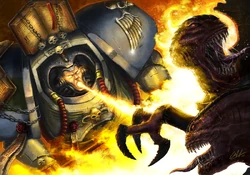
Ultramarines Librarian summoning forth psychic hellfire against vile Genestealers
Like their fellow Astartes Chapters, the Ultramarines also maintain a Librarium of potent psykers who are highly talented and trained to master the power of the Warp at the highest levels. Each Chapter selects its Librarians in its own way, either from seed worlds, as it does with the bulk of its Initiates, or from the ranks of gifted psykers brought to the Scholastica Psykana. Most Chapters train and test chosen psykers following the ancient ways laid out in the Codex Astartes. Librarians of the Ultramarines are trained in this way, and, with few minor variances, have been taught to live by the word of the Codex. Ultramarines Librarians have a number of unique psychic abilities only used by the psykers of their Chapter:
- Fury of the Ancient - Calling upon the legends of his Chapter, the Librarian summons forth a ravening beast of ghostly flame and psychic energy. The flaming apparition then charges forward from the Librarian in a straight line, moving up to the extent of the power’s range before vanishing in a burst of energy.
- Glory of the Emperor - For the briefest of instants the Librarian channels the light of the Emperor, bathing all those nearby in His glory, which can cause massive damage to creatures of the Warp.
- Inspiring Word - The Librarian calms the minds of nearby allies and completely dispels their fear and doubt.
- Paragon - The Librarian lets his authority shine forth in a blaze of psychic energy, filling nearby allies with strength and resolve to emulate his glory.
- War Cry - With a terrifying cry, the Librarian demoralises and stuns nearby foes, forcing them to cower before his might.
- Word of the Emperor - The Librarian recites a sanctified prayer to the Emperor, speaking holy words that burn the minds of the unfaithful and cast out the spirits of the Warp.
Order of Battle
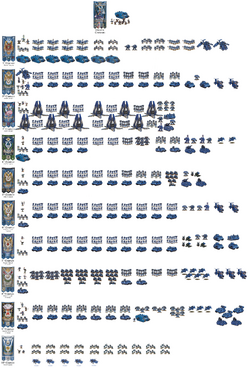
The order of battle of the Ultramarines, the archetypal Codex Astartes-compliant Space Marine Chapter, displaying the full composition of all ten companies
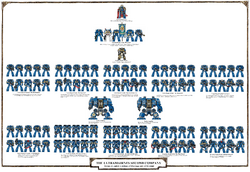
Order of Battle of the Ultramarines 2nd Company, "Guardians of the Temple"
Like most Codex Astartes-compliant Chapters, the Ultramarines are divided into 10 companies of 100 Space Marines each. Each company is led by a Captain of the Ultramarines, who -- in addition to his company command -- is in charge of a particular aspect of the Chapter's logistics. Since the end of the First Tyrannic War, the elite, xenos-hunting Ultramarines Veterans known as Tyrannic War Veterans, have been scattered throughout every company in the Chapter to pass on their experience and expertise in killing the Ultramarines' most hated alien foes to their greener Battle-Brothers. An Ultramarines Astartes' company designation is indicated by the colour of the trim of his Power Armour shoulder plates. The current company commanders and company order of battle of the Ultramarines Chapter in 999.M41 are as follows:
- Chapter Command: Marneus Calgar, Lord of Macragge, Chapter Master of the Ultramarines
- 27 Honour Guard Astartes
- 1 Land Raider (Maximus)
- 1,700 Chapter Equerries (Chapter Serfs) and Servitors
- Chapter Reclusiam: Ortan Cassius, Master of Sanctity (High Chaplain)
- 10 Company Chaplains
- Chapter Armoury: Fennias Maxim, Master of the Forge
- 27 Techmarines
- 95 Tech-Servitors
- 52 Main Battle Tanks (multiple types)
- 25 Predators
- 8 Vindicators
- 9 Whirlwinds
- 12 Land Raiders
- 14 Gunships (Stormtalons and Stormravens)
- 24 Centurion warsuits
- 19 Land Speeders
- Assault Bikes and Attack Bikes
- Apothecarion: Corpus Helix, Chief Apothecary
- 12 Apothecaries
- Librarius: Varro Tigurius, Chief Librarian
- 5 Epistolaries
- 9 Codiciers
- 10 Lexicaniums
- 3 Acolytes (Neophytes)
- Master of the Fleet: Lord Admiral Lazlo Tiberius, an Astartes of the Ultramarines Chapter and Hero of Macragge, has been made the Master of the Ultramarines Chapter Fleet by Marneus Calgar
- 10 Battle Barges
- 15 Strike Cruisers
- 20 Escorts
- 75 Thunderhawks
- 1st (Veteran) Company, "Warriors of Ultramar" (white trim): Captain Severus Agemman, the Regent of Ultramar
- 97 Veterans (including Terminators)
- 3 Dreadnoughts
- 2nd (Battle) Company, "Guardians of the Temple" (gold trim): Captain Cato Sicarius, the Master of the Watch
- 3rd (Battle) Company, "Scourge of the Xenos" (red trim): Captain Ardias, Captain Mikael Fabian (temporarily in command), the Master of the Arsenal
- 4th (Battle) Company, "Defenders of Ultramar" (green trim): Captain Uriel Ventris, chosen by the 4th Company's former commander, Captain Lucius Idaeus, the former Master of the Fleet, as his successor before his death at at the Battle of Bridge 2-4 on the world of Thracia
- 5th (Battle) Company, "Wardens of the Eastern Fringe" (black trim): Captain Caito Galenus, the Master of the Marches
- 6th (Reserve) Company (orange trim): Captain Epathus, the Master of the Rites
- 7th (Reserve) Company (purple trim): Captain Ixion, the Chief Victualler (Quartermaster)
- 8th (Reserve) Company (grey trim): Captain Numitor, the Lord Executioner
- 9th (Reserve) Company (blue trim): Captain Sinon, the Master of Relics
- 10th (Scout) Company (no trim): Captain Antilochus, the Master of Recruits
Captain Invictus had been the commander of the 1st Company until he died at the Battle of Macragge alongside most of his company. Severus Agemman had originally commanded the 2nd Company until his promotion to command the 1st after the Battle of Macragge. Until 745.M41, Captain Ardias originally led the 3rd Company, but was seriously injured in battle by overwhelming Tau forces. Mikael Fabian was confirmed as the temporary successor captain before the Battle of Macragge against the Tyranids, and, with his 3rd Company, had success in the reconquest of the North Pole Fortress. Until 999.M41, Captain Lucius Idaeus led the 4th Company, but died in battle on Thracia. Uriel Ventris was confirmed as the successor captain shortly after, but was exiled from the Ultramarines for failing to adhere to the Codex Astartes. He successfully completed his Death Oath and returned home to take up his command once more.
Chapter Recruitment
The Ultramarines recruit new Astartes from amongst the populations of all the worlds which comprise the Realm of Ultramar in the galaxy's Eastern Fringe. As the Ultramarines have long been the rulers of Ultramar, its nobility considers having a son chosen to join the Chapter to be an honour without parallel. Adolescent Aspirants who wish to join the Ultramarines are generally expected to overcome one of two different types of Trials if they hope to be chosen to become Neophytes.

Ultramarines Aspirants run barefoot through the mountains of Macragge during an Exposure Trial
First, the Ultramarines may expect their Aspirants to pass what is known as an Exposure Trial within one of the more difficult environments to be found within the boundaries of Ultramar. Few worlds of the Imperium of Man are entirely free from adversity and these rare exceptions are either the holdings of wealthy mercantile combines or pleasure retreats for retired, high-level Imperial servants or the local sector nobility, entirely inaccessible to the vast bulk of Mankind. Most of the Emperor's subjects live on worlds that are dangerous in some manner. Long-settled planets are riven by pollution, the toxic waste of thousands of standard years of industry seeping into the very bedrock and raining from the skies in a constant downpour. Other worlds are heavily irradiated, by the processes of industry or by the effects of local celestial phenomena. Younger worlds where Mankind's dominion is not yet fully established are often host to all manner of hostile lifeforms, including predatory beasts, carnivorous plants and virulent microbes.
Plenty of worlds feature environments that are inimical to life, yet due to some natural resource or the world's strategic value, humans eke out an existence there nonetheless. Such environments range from sub-zero ice wastes, impenetrable swamps and arid deserts to exotic death world jungles, methane sumps and hydrocarbon oceans. In an Exposure Trial, the Aspirant must go out into such an environment and simply survive for a set period of time. If he is a native of such a hellish place, the Aspirant will have some knowledge of how to survive, yet is shorn of all aid and divested of all but the most basic of survival equipment. Communities living in the midst of a death world jungle, for example, rely on total and constant cooperation just to go on existing another day and none are ever out of the sight of another. An Exposure Trial in such a place would force the Aspirant to go out into the jungle alone and face the terrors of the wild with only himself to rely upon for the first time in his life. Some Exposure Trials test the Aspirant's fortitude in a specific environment. Such Trials carried out in an icy waste could involve the Aspirant travelling from one point to another, with countless hundreds of kilometres of trackless snow-blasted plains separating the two.
Other Aspirants might have to cross an entire continent of irradiated ash dunes, traverse an impassable mountain range, swim a predator-infested ocean or a hundred other such challenges. One particularly inventive variation of the Exposure Trial is one in which the Aspirant is taken from his own environment and transplanted into an entirely unfamiliar one. A Feral World savage might be deposited in a hive city, for example, or a Hive Worlder in a predator-infested Death World jungle. Many Exposure Trials are impossible to complete, entailing the Aspirant simply staying alive as long as possible. Those who face the impossible without faltering and who survive long past the point they should have perished are recovered by the Chapter's Apothecaries, often having succumbed but not yet died, and revived, having been judged worthy of becoming an Astartes Neophyte. Amongst other types of Trial, the Ultramarines make extensive use of the Exposure Trial. In fact, some of the warrior elite of the Realm of Ultramar are known to cast newborn infants into the wilderness in order to test their resilience.
The second and less commonly employed Trial for Ultramarines Aspirants is the Challenge Trial. The Challenge requires the Aspirant to fight a duel or compete in some other manner against a full Astartes. In truth, none expect the Aspirant to better a full Battle-Brother and his success is more often measured in the degree of his failure. Very occasionally, an Aspirant does manage to beat an Astartes and when this happens it is not uncommon for the individual to go on to become a legendary hero of the Chapter. Many Challenge Trials involve a test of martial skill, with the Aspirant fighting an armed duel against a Battle-Brother. It is usual for the Aspirant to be armed and the Astartes to fight with his bare hands and probably without his Power Armour, yet still the Aspirant has virtually no hope of victory. Most Challenge Duels end in the death of the Aspirant, for even an unarmed, unarmoured Astartes is a giant compared to the young, adolescent challenger and well able to slay him with a single blow, intentionally or not. Other Challenge Trials involve contests of strength, stamina, speed, skill or mental strength. The Trial might range from the lifting of impossibly heavy loads to the imbibing of toxic substances. As with a duel, this type of Challenge Trial can often prove deadly. In both cases, however, an Aspirant that has failed the Trial -- yet performed to the Chapter's satisfaction -- is rescued from the jaws of death by the Chapter's Apothecaries and judged worthy of progressing to the rank of Neophyte.
Ironically, though many members of the Ultramarines have been drawn from the ranks of Ultramar's powerful nobility, and such a position adds to his family's status and regard, one of the first things that becoming a Neophyte will teach the new recruit is that in the Ultramarines, family birth and status are meaningless. Every Battle-Brother stands equal in the eyes of the Emperor and Roboute Guilliman and the only aristocracy is that forged by sacrifice and blood in service to Mankind and one's fellow Astartes.
Deathwatch Service
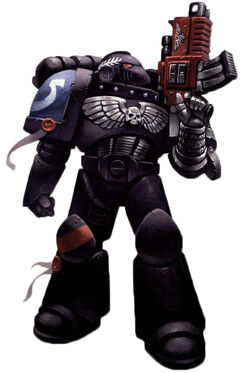
An Ultramarines Astartes seconded to the Deathwatch
The Ultramarines Chapter is well represented in the ranks of the Deathwatch, the Chamber Militant of the Inquisition's Ordo Xenos. Ultramarines have been undertaking the Long Watch since the very earliest days of the Vigil in the Jericho Reach, and it is claimed in several archives that the very first Battle-Brother to take the Apocryphon Oath at Orphite IV was of the Chapter. Given their outlook and their knowledge of tactics and every nuance of the operational art, it is perhaps unsurprising that a large proportion of the Deathwatch’s leaders in the Jericho Reach are seconded from the Ultramarines. Every single Battle-Brother of the Chapter is steeped in the dictates of the Codex Astartes, and is well-read in almost all methods of warfare ever conceived. But it is not just knowledge that makes Ultramarines such worthy leaders, but the inheritance of Roboute Guilliman himself. Just as that Primarch united the Imperium and the Adeptus Astartes after the end of the Horus Heresy, welding the military might of the greatest stellar empire the galaxy has ever seen into a single, mighty war machine, so the Ultramarines serving in the Deathwatch unite the many and varied warriors serving beneath them. Such officers must ensure that taciturn Dark Angels work alongside hot-headed Space Wolves, that noble Blood Angels stand side-by-side with morbid Raven Guard. He must address the legitimate concerns of each and ensure the team works together as a seamless whole. He must know every nuance of his warriors’ abilities, and their weaknesses too, and utilise them as the living weapons they were created to be. It is only by the wisdom of the Codex Astartes and the example of its author that such a feat is possible.
Chapter Combat Doctrine
"Superiority of force is key and the key to superiority is above all structure. With structure comes order, with order the ability to carry out purpose, and only through clear purpose can victory be perceived."
- — Principia Bellicosa, Ch. XXXIV, V⁵, I-IV
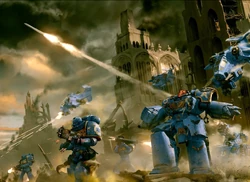
Ultramarines prosecuting the defence of a ruined Imperial city
During the Great Crusade and Horus Heresy eras, one of many practical applications of the vast storehouse of theoretical battle scenarios, plans and tactical formulae that make up the vast strategic corpus upon which the Ultramarines Legion based its art of war, the "Logos Lectora", or roughly more commonly and imprecisely rendered the "pronouncement of writ" was a battlefield formation which took advantage of an interlocking range of Legion units to their best effect. Reliant on sophisticated command and control protocols, faultless obedience and rigid discipline, if the Logos Lectora had a disadvantage as a tactic, it was that its interlocking units formed a coherent pattern somewhat inflexible in their makeup and deployment.
By the 41st Millennium, the Ultramarines Chapter has come to rely on the holy dictates of the Codex Astartes to meet any given tactical situation. This tome contains the wisdom of thousands of Imperial warriors who have contributed to the Codex, and details everything from proper unit markings to how to launch full-scale planetary assaults within its pages. The Ultramarines do not specialise in any particular form of combat, instead proving to be the ultimate generalists -- surprisingly proficient at every task required in warfare, but not the master or greatest practitioner of any of them. For instance, the Aurora Chapter is far more skilled in armoured warfare than the Ultramarines, while the Raven Guard are second to none in the use of guerrilla, infiltration and hit-and-run tactics, and the Imperial Fists are the recognised masters of siege warfare. Yet the Ultramarines' generalist skill in the arts of combat would provide a potent defence against any of these Chapters, and so they are often held up as the standard to which all other Chapters of Astartes are compared, for better or worse.
Chapter Character
The saga of the Ultramarines Legion and its Successor Chapter takes many elements from the ancient Greek (particularly Spartan) and Roman societies, namely in terms of its military organisation. They are the pre-eminent Space Marines army that serves as the example for all other Codex-compliant Chapters in the Imperium, and they do not require any tactical supplements beyond the Codex Astartes.
The Ultramarines' dominion over the star systems of Ultramar gives these Astartes unparalleled contact with Imperial citizenry. This has led to an unusual level of affinity for the common citizenry among an Astartes Chapter, comparable only to that displayed by the Salamanders. The Ultramarines regard themselves as protectors of the innocent, and not simply the Imperium's best warriors. This indicates the Ultramarines may be considered one of the noblest of Space Marine Chapters, fighting for not merely honour and martial pride or glory, but to protect the lives of their own people. In addition, unlike most Imperial organisations, they are willing to work with aliens like the Eldar from time to time, and even hold some respect for the Tau Empire. Unlike other Imperial military forces, the Ultramarines do not renege on their deals with alien allies, even after victory has been achieved.
The Ultramarines are a byword for courage and honour, and their warriors are justly held in the highest regard throughout the Imperium. Unlike many other Chapters, who control a single planet or fortress-monastery, the Ultramarines control no fewer than 8 star systems directly from their homeworld of Macragge, the stellar realm known as Ultramar. It is from these worlds that the Ultramarines recruit their newest members, administer Imperial Justice and rule Ultramar with a just and disciplined hand. The Ultramarines' fortress-monastery -- known as the Fortress of Hera -- is situated in the highest peaks of Macragge, and it is here that the best and bravest of the children selected from the many training academies throughout Ultramar are brought to begin their training as Space Marine Aspirants. Here, they will become the most feared fighting warriors of the Imperium -- the Angels of Death, the Adeptus Astartes.
Roboute Guilliman, the Primarch of the Ultramarines, set down the foundations of the Imperium’s fighting forces 10,000 years ago in a mighty tome known and revered as the Codex Astartes. This holy work embodied all the Primarch’s military genius and set out precise guidelines for virtually every single aspect of war imaginable, everything from the correct conduct while marching to the precise execution of a planetary assault. But perhaps its most significant edict was the breaking-up of the First Founding Space Marine Legions into the smaller Chapters that exist today. No longer would one man control a force as powerful as an entire Space Marine Legion. Each Chapter would be broken up into a force of 10 companies, roughly a thousand warriors strong in total. The Ultramarines have followed Guilliman's teachings since those days and are strict adherents to the words of their Primarch’s tome, and the organisation and combat doctrines of the Ultramarines of today are the same as those followed by the Ultramarines of ten thousand years ago. These tenets of belief have passed to the Imperial citizens of Ultramar and this stellar realm is as close to the ideal of an Imperial human Utopia as is imaginable in a galaxy defined by war.
Chapter Beliefs
As befits the inheritors of Roboute Guilliman's superb military genius and ferocity in battle, the Ultramarines have fought in the manner prescribed in the holy pages of the Codex Astartes for ten millennia. They do not interpret the sacred words of their Primarch loosely, for to do so is considered blasphemy in their eyes. Such deviation is unthinkable to the Ultramarines. To the Chapter, the Codex is a divine work of wisdom, sanctified by the beneficent Emperor Himself. The Ultramarines see no reason to deviate from its wisdom. The life-long lessons of discipline and self-reliance are taught to the people of Ultramar from birth, giving them the strength of character to hold true to teachings over ten thousand years old.
Notable Ultramarines
- Roboute Guilliman - Roboute Guilliman was the Primarch of the XIIIth Space Marine Legion and its myriad subsequent Second Founding Successor Chapters. Guilliman was the Primarch who single-handedly reshaped the Imperium of Man after the Horus Heresy during the Imperial Reformation, taking the lead role in reforming the administrative and military apparatus of the Imperium following the internment of the Emperor of Mankind within the Golden Throne on Terra. Guilliman is perhaps best remembered for being the author of the Codex Astartes, a key volume that laid out the proper tactics and military organisation for the majority of Loyalist Space Marine Chapters now in existence.
- Lord Commander Gren Vosotho - Gren Vosotho was a part of the first induction of Terran initiates for the newly formed XIIIth Legion when it was formed during the latter years of the Terran Unification Wars. Showing great promise as a leader, Vosotho was selected for high command, eventually rising to the esteemed position as the first Lord Commander of the XIIIth, leading them for over three decades. Vosotho met his fate when the XIIIth Legion were sent to put down the secessionist movement within the Osiris Cluster. Deemed an affront to the Legion's honour, Lord Commander Vosotho vowed to bring the matter to a swift resolution. Leading a deep strike onto the surface of the halo world of Septus XII, Vosotho hoped to end the rebellion in a single, bloody stroke. Drawn deep into the centre of the primary hive city, the unwary Legionaries were beset by a cunning xenos trap. A xenos fleet of unknown type waylaid the outmatched, orbiting 12th Expeditionary Fleet, destroying the Legion's flagship as well as several other vessels. When the fearful figures of the xenos "Psybrids" began to materialise on the surface among the attackers, Vosotho's final command was for the fleet to withdraw with as many of the XIIIth Legion that could be recovered. Vosotho committed his life to the command of the rearguard on the surface, taking penance for his error, and his last act was to transfer Legion command to the most senior surviving commander present in orbit, Marius Gage.
- Chapter Master Marneus Calgar - Marneus Calgar has been the Ultramarines' Chapter Master throughout most of the 41st Millennium as well as the Planetary Governor and Lord of Macragge. He wields the Gauntlets of Ultramar, the weapons that the Ultramarines' Primarch Roboute Guilliman had taken from a Chaos Champion he slew during the Horus Heresy.
- Chaptain Master Ollonius - Ollonius led the Ultramarines Chapter in the early 36th Millennium. During that time, he received a fragmented Imperial distress call form Sylphis II. Faced with sparse intel on the nature of the threat, Ollonius had to maximise the flexibility of the Ultramarines' response. He therefore assembled a Gladius Strike Force. Command was given to 3rd Company Captain Calistes, supported by Chaplain Gaius. Drawing on available forces, the strike force incorporated a Battle Demi-company of the 3rd, three squads of 1st Company Terminators, three squads of 10th Company Scouts, and several tank squadrons under Techmarine Agmannus. Upon making planetfall on Sylphis II, Calistes and his men found the world beset by greenskins, but with each component of the strike force working in perfect concert, the Ultramarines were able to purge the world of its xenos invaders.
- First Chapter Master Marius Gage - Marius Gage, known as the "First Master", was the Terran-born First Chapter Master of the Ultramarines Legion's elite 1st Chapter, Master Primus of the XIIIth Legion and Equerry to Primarch Roboute Guilliman during the Great Crusade and Horus Heresy eras during the 30th and 31st Millennia. Gage would go on to become the first Chapter Master of the reorganised Ultramarines Chapter, following the poisoning of Primarch Guilliman at the hands of the Daemon Primarch Fulgrim of the Emperor's Children Traitor Legion, and the subsequent internment of Primarch Guilliman's body within a stasis chamber shrine back on Macragge.
- Captain Severus Agemman - Severus Agemman has served his Chapter with honour for many years, earning his place as the current Captain of the elite 1st Company through the weight of his deeds and respect of his Chapter Master. As part of his rank, he also bears the title Regent of Ultramar, and is considered the lord of that realm should Marneus Calgar be called away to war. Previously Severus served as the Captain of the Second Company, but was promoted to First Captain after his predecessor, Captain Saul Invictus, was killed during the Battle of Macragge. As can be expected, Agemman is a proud warrior who lives for his duty; he is utterly devoted to the Chapter, its master and the Emperor. However, Agemman lives under the shadow that many great men must endure; the knowledge that, as masterful a leader and warrior as he is, perhaps this is all he will ever be. It is no secret that Cato Sicarius, Captain of the 2nd Company, is favoured to become Chapter Master after Calgar, and that many within the Chapter consider Agemman too valuable in his current role to advance to higher command. If this bothers Agemman, he has never shown it; the First Captain immerses himself in his duty so that none might ever say he has placed his own glory before that of the Ultramarines.
- Captain Saul Invictus - Former Captain of the 1st Company. He valiantly led the combined Ultramarines, Imperial Guard and Titan Legion forces at the Battle of Macragge. Following the grievous losses sustained by the Ultramarines Chapter during the Corinth Crusade (698-705.M41), Captain Invictus rebuilt and carefully honed the elite 1st Company with stolid and formidable veterans drawn from the rest of the Chapter, in accordance to the dictates of the Codex Astartes. By reforming the 1st Company this way, Invictus avoided the failures of many reformed Companies by maintaining squad cooperation and cohesion, which was flawless, and superb fire discipline. Invictus was fanatically committed to ensuring that his battle-brothers deserved the respect they gained from the rest of the Chapter and drove them with relentless energy. During the Battle of Macragge, Invictus requested that the 1st Company be assigned to protecting Macragge's two vital polar defence fortresses. These were the lynchpins in Macragge's orbital defence network. Invictus judged (correctly as it transpired) that the Tyranids would attempt to make landings at these two location in order to neutralise the defences, which would open the door for untold numbers of these vile xenos creatures to swarm down from the orbiting Hive Fleet and infest the planet. The presence of the elite veterans of the 1st Company ensured that the Tyranids suffered unsustainable casualties overrunning the fortresses, delaying the inevitable long enough for Marneus Calgar and the rest of the Chapter to achieve victory in space. Captain Invictus' body was discovered amongst the many bodies of the battle-brothers of the 1st Company, who had made their last stand in Silo 8 of the northern fortress. Tyranid corpses were piled for twenty yards in every direction, circling the fallen defenders.
- Captain Cato Sicarius - Captain of the 2nd Company, Grand Duke of Talassar, Suzerain of Ultramar and Master of the Watch who was the hero of the Assault on Black Reach and the Zeist Campaign. Sicarius also led the Imperial forces on Medusa V and moved to combat the invasion of Ultramar by the Forces of Chaos under the command of the Daemon Prince M'kar the Reborn. Sicarius is believed by many Astartes within his Chapter to be a fitting successor to Marneus Calgar as the next Chapter Master of the Ultramarines and Lord of Macragge.
- Captain Titus - Titus was the Captain of the 2nd Company and the hero of the Liberation of Graia. Titus faced his greatest test when he and his company of Ultramarines were sent to the Adeptus Mechanicus Forge World of Graia in the Segmentum Tempestus to stop an invasion by an Ork WAAAGH! 1 million Greenskins strong, led by the Warboss Grimskull, intent on stealing advanced Imperial weapons, including a Warlord-class Battle Titan. The assault was part of an intricate plan unleashed by the Chaos Sorcerer Nemeroth, the Chaos Lord of a warband of Chaos Space Marines known as the Chosen of Nemeroth, to get his hands on an experimental power source on the world that would allow him to ascend to become a Daemon Prince. Accompanied by 2 members of his command squad, Sergeant Sidonus and Battle-Brother Leandros, Titus joined with the Imperial Guard's 203rd Cadian Shock Troops Regiment and its only surviving officer, 2nd Lieutenant Mira, to eventually kill Grimskull and halt the WAAAGH! Unfortunately, the Ordo Xenos Inquisitor Drogan, who Titus and his Astartes relied upon for assistance in retaking the world, was actually an undead pawn of Nemeroth who used a specially designed weapon powered by the experimental power source Nemeroth wanted, to open a portal into the Warp that allowed the Chaos Sorcerer, a horde of Chaos daemons and his Chaos Space Marines to come to Graia. Curiously, however, Titus displayed an unknown immunity to the sorcerer's psychic powers which immediately raised the suspicions of the highly orthodox Leandros to his commander's possible corruption. Following the death of his old friend Sidonus at Nemeroth's hand, Titus hunted down the foul Chaos Sorcerer and slew him just as he was in the throes of the ascension to daemonhood, banishing his dark soul back to the Warp for punishment by his Dark Gods. Unfortunately, after saving Graia, Captain Titus was taken into custody by Inquisitor Thrax and his retinue of Black Templars Space Marines, who were part of the Liberation Fleet sent to Graia. He was taken on suspicion of heresy after Leandros reported his captain for both his resistance to Nemeroth's sorcery and his multiple deviations from the Codex Astartes held sacrosanct by all Ultramarines. His current fate is unknown. Titus was the main character of the video game Warhammer 40,000: Space Marine, which took place in an alternate universe where Titus rather than Cato Sicarius was the Captain of the 2nd Company.
- Captain Fabian - Fabian was the Captain of the 3rd Company, and the Ultramarines' Master of the Arsenal.
- Captain Uriel Ventris - Current Captain of the Ultramarines 4th Company. He is armed with the Sword of Ideaus, Lucius Ideaus being his predecessor as commander of the 4th Company and his mentor. He was exiled from the Chapter for not adhering to the Codex Astartes after leading a Deathwatch Kill-team into a Tyranid splinter Hive Fleet to kill its Norn-Queen. After fullfilling his Death Oath and destroying the Daemonculaba on the Daemon World of Medrengard, home of the Iron Warriors, he and his Veteran Sergeant Pasanius Lysane have now returned to Ultramar. After returning to Ultramar, Pasanius and Ventris had to undergo tests for their purity, and since then Ventris has regained command of the 4th Company. His first mission upon his return was to head back to the Tomb World of Pavonis and ensure that it was recovering from a Necron awakening, when the 4th Company engaged the Tau unexpectedly. The Ultramarines ultimately won, with Ventris adhering to the Codex Astartes for every engagement.
- Captain Remus Ventanus - Captain of the 4th Company, 1st Chapter during the Horus Heresy, Remus Ventanus was central to the Legion's fight-back on the surface of Calth during the Ultramarines' darkest moment. At the moment of the destruction of Calth's Veridian Anchor, Ventanus was inspecting loading operations at Numinus Port, and in the anarchic hours that followed, he rallied the 4th and warriors from other shattered formations into a force able to mount a fierce resistance against the Traitors. It was during this early phase that Ventanus linked up with the Magos of Analyticae Tawren, the most senior surviving Mechanicum adept and the only Tech-Priest able to perceive a means of regaining control of the Calth defence grid. Thanks to Ventanus's leadership and courage, the Magos completed her crucial task. The Captain's duties did not end with his victories at Leptius Numinus and the Lanshear Guildhall, for he fought on even as the bulk of the Ultramarines forces on the surface were evacuated at the order of his Primarch. He led the counter-attack against the disordered Word Bearers, and as the extent of the wounds to the Veridian star became evident, Ventanus led his forces and as many civilians as he could contact into the subterranean arcologies. His deeds throughout the subsequent Calth Underworld War led to him becoming known as the Saviour of Calth.
- Captain Cato Galenus - Galenus is the Captain of the 5th Company and the Ultramarines' Master of the Marches.
- Captain Epathus - Epathus is the Captain of the 6th Company, and the Ultramarines' Master of the Rites.
- Captain Ixion - Ixion is the Captain of the 7th Company and the Ultramarines' Chief Victualler.
- Captain Antilochus - Antilochus is the Captain of the 10th Company and the Ultramarines' Master of Recruits.
- Captain Steloc Aethon - Steloc Aethon was the Captain of the 19th Company during the Great Crusade and Horus Heresy eras. A native son of Calth, he was born to a proud family of underworld castellans and brought up in the principal arcology of Gallica Subdelta. With his eidetic memory, he became a master of the underground arcologies, earning the nickname "White Spider," for it was said he knew the labyrinths better than the arachnids that crawled their ceilings. He eventually went on to become a formidable warrior of the Ultramarines Legion, and quickly earned the rank of Captain during the campaigns of the Great Crusade. By the time the Ultramarines and Word Bearers mustered upon Calth, Aethon had proved a gifted ambassador, and was awarded the title of Praetor by unanimous accord. Following the Word Bearers betrayal and unprovoked attack, Captain Aethon's cool and methodical approach to war turned to fiery rage at the treachery unleashed upon his home world. When Calth's sun went supernova, irradiating the planet's surface, the Ultramarine survivors were forced to seek shelter in the subterranean arcologies that thread the planet's underworld. The surviving Word Bearers likewise headed underground, determined to complete their heretical work by hunting down every Ultramarine survivor. Under Captain Aethon's command, the Ultramarines rallied and counter-attacked, waging a desperate war in the darkness against their foes they once called brothers.
- Captain Erikon Gaius - Gaius was the Captain of the 21st Company during the Great Crusade and Horus Heresy eras, and he was known as the Hero of the Hadir Uprising, as well as Gaius the Strong and Gaius the Unflinching. During the infamous Battle of Calth, Gaius rallied his devastated company and counter-attacked the traitorous Word Bearers Legion, inflicting several casualties, but unable to halt their advance. He eventually gave his life heroically during the latter course of the campaign.
- Captain Lucretius Corvo - Lucretius Corvo was a highly honoured Captain of the 90th Company, 9th Chapter. He led his company in countless successful engagements during the Great Crusade and served as one of the Ultramarines' Champions during the vicious fighting against the apostate Word Bearers Legion on the planet Astagar during the Horus Heresy. During this particularly brutal six-day-long battle, Corvo led a desperate counterattack against an enemy force many times his own unit's number. His chosen band managed to destroy a Traitor Warlord-class Titan and break the siege. As recognition for his tenacity and heroic actions, a Laurel of Defiance was awarded to Corvo by Primarch Roboute Guilliman himself. During the Second Founding, he would go on to become the first Chapter Master of the newly created Novamarines Chapter. The Novamarines use of a quartered livery is based upon Lucretius Corvo' owns personal heraldry.
- Captain Lysimachus Cestus - Captain and Fleet Commander of the XIIIth Legion's 7th Chapter during the latter stages of the Great Crusade and the early stages of the Horus Heresy. He is notable for leading the valiant interception mission against the Furious Abyss, the massive Battleship of the traitorous Word Bearers Legion, and ensuring its destruction before it could play a role in the Battle of Calth.
- Captain Teutona - Captain Teutona served as the commander of the 15th Chapter at the time of the Battle of Calth. During the opening phase of the battle, the Captain was slain by frenzied Traitor auxilia.
- Captain Tullian Aquila - Aquila was a Veteran battle-brother of the Ultramarines Legion during the Great Crusade and Horus Heresy eras. He served as a Sergeant during the Battle of Calth, stationed alongside his company at the city of Ithraca. When the traitorous Word Bearers struck after taking control of Calth's orbital defences, only Sergeant Aquila and two other battle-brother survived the orbital barrage. During the subsequent fighting, Aquila was moved by the sacrifice of one of his battle-brothers and came to the realisation -- even though he himself was already dead -- that he had a duty to protect the innocent and to suffer, so that they did not have to. Later on, then-Captain Aquila would become the founder and first Chapter Master of the newly created Doom Eagles Chapter during the Second Founding. The Doom Eagles quickly embraced their Chapter Master's sense of fatalism, and came to accept that death was inevitable, and that every mission performed on behalf of the Emperor must be pursued with both fervour and zeal in defence of the Imperium and its people before one's life was spent.
- Captain Kruger - Sometime during the 41st Millennium, Captain Kruger served as a Force Commander for an Ultramarines strike force against a warband of their hated rivals, the Word Bearers and a pack of Daemons, led by the Chaos Lord Zymran, for the control of a Pre-Heresy relic called the Concordat Chaosium. Captain Kruger led his Ultramarines to the Daemon World of Daizamm, the homeworld of Zymran, located at the edge of the Eye of Terror. Encountering a large force of daemons led by the Bloodthirster Mailokh -- a Greater Daemon of Khorne -- the Ultramarines weathered the storm and defeated the servants of Chaos after banishing Mailokh back into the Warp. Opening a Chaos Gate to Zymran's realm, within this hellish dimension the Ultramarines located a fortress, the last refuge of Zymran and the remnants of his forces. Captain Kruger personally led his Company in a long hard fought battle against the Chaos Lord, which ended with the Word Bearers' death, ending the Ultramarines' crusade. These events took place in the PC game, Warhammer 40,000: Chaos Gate.
- Watch Captain Marius Avincus - Marius Avincus Caeso was recruited into the Ultramarines with his twin brother Gnaeus, and both served together for centuries. After more than 300 hundred standard years in service to the Ultramarines, the brothers faced a horror the likes of which none could imagine -- the Tyranids attacked Prandium. Gnaeus was slain, crushed by a Carnifex while trying to defend refugees being evacuated from their homeworld. During the Battle of Macragge Avincus had the opportunity to strike back against the vile xenos. In the years that followed he was chosen to join the 1st Company as one of Chaplain Cassius' Tyrannic War Veterans. After 12 years of service, he was nominated for service with the Chamber Militant of the Ordo Xenos -- the Deathwatch. He currently serves as a Watch Captain of the Deathwatch within the Orpheus Salient of the Jericho Reach.
- Watch Captain Prascus - Captain Prascus was an Ultramarine seconded to the Deathwatch who is best remembered for building the first hunting grounds at Watch Fortress Erioch 400 standard years ago. He became renowned for his skills in the selection and deployment of Kill-teams, as he was always able to balance their members to create a dynamism that proved nigh unstoppable in combat. Prascus served 11 Vigils with the Deathwatch, acting as Watch Captain for 6 of them and as Master of the Vigil twice. He was killed in the Battle of Macragge during the intense fighting at the Northern Polar Fortress complex during the First Tyrannic War.
- Chief Librarian Tigurius - Tigurius is believed to have survived contact with the Tyranid Hive Mind and to be the strongest psyker in the Imperium, with the possible exception of Mephiston, the Lord of Death of the Blood Angels, Njal Stormcaller of the Space Wolves, and of course the Emperor of Mankind.
- Chief Librarian Aaroth Ptolemy - Ptolemy was the first and greatest Librarian of the Ultramarines and the founder of the Library of Ptolemy. Ironically, by the 41st Millennium little details remain about his life, though it is known that he might have been present for the trial of the Thousand Sons' Primarch Magnus the Red during the Council of Nikaea, but it is unknown whether he was one of the Red Sorcerer's accusers or defenders.
- Tylos Rubio - Tylos Rubio was an extremely powerful Space Marine psyker during the Great Crusade era of the early 31st Millennium, who had once been a Codicier of the Ultramarines Legion before the Emperor of Mankind’s formal decree at the Council of Nikaea had banned the Astartes Legions' use of psykers, including their own corps of Librarians. Honouring his oath to the Emperor, Tylos surrendered his Librarian panoply and wargear, and returned to the lines as an ordinary Battle-Brother of the 21st Company. He would later be recruited by Nathaniel Garro, the former Death Guard Battle-Captain, during the infamous Battle of Calth at the outset of the Horus Heresy, and become one of the seven Astartes who would form the core of what would become the Inquisition's Grey Knights Space Marine Chapter.
- Reclusiarch Ortan Cassius - Ortan Cassius is the Ultramarines' Master of Sanctity. He is one of the oldest Ultramarines not contained within the armoured chassis of a Dreadnought. Though Cassius is close to 400 standard years old, his sturdy presence within the Ultramarines line of battle still fills the hearts of his younger brethren with pride and valour. He is the founder and mentor of the Tyrannic War Veterans.
- Chaplain Varnus - In the PC game Dawn of War - Winter Assault, Varnus was the Chaplain who lead the Ultramarines force to escort the Collegia Titanica Titan Recovery Team intended to reawaken the Imperator-class Battle Titan Dominatus that had been lost on the Ice World of Lorn V during the Horus Heresy. After the Imperial Guard came to his aid when his Thunderhawk transport crashed, he witnessed the summoning of a Bloodthirster Greater Daemon of Khorne, which mutilated one of his Space Marines. Enraged, Varnus charges out of his defences and confronted the Greater Daemon in close combat, single-handedly defeating it. He later helped hold the line against an awakening force of Necrons as the Imperator-class Titan lying dormant on Lorn V was brought online.
- Apothecary Theon - Apothecary Theon served as a part of the Support Echelon, 3rd Chapter during the Great Crusade and Horus Heresy eras. He was deployed to his chapter's command post at the landing fields on the Bay of Lisko. At the moment of the destruction of Calth's Veridian Anchor, Theon and his brethren from the Chapter Apothecarion were embarking an orbital transport, but as the burning debris began to fall, they rapidly disembarked in anticipation of the casualties to come. Within the hour, the coastal landing zone was aflame and thousands of Legionaries, Auxilia and civilians were dead and many more were wounded. There was little Theon could do for the majority, but operational records state he served with courage and resolution that day, and recovered the progenoid glands of dozens of battle-brothers fallen in glory.
- Lord Admiral Lazlo Tiberius - Tiberius served as the commander of the Ultramarines Strike Cruiser Vae Victus and is the Ultramarines current Master of the Fleet. Nearly 400 standard years old as of the late 41st Millennium, he has spent nearly all of his career fighting in the void of space, and is one of the Chapter's finest void-tacticians. The Vae Victus is usually assigned to the Ultramarines' vaunted 4th Company, under the command of Captain Uriel Ventris. As the 4th Company's commander, Captain Ventris is traditionally entitled to the position of Master of the Fleet, but he transferred this esteemed title to Tiberius in recognition of his superlative skill and experience.
- Ancient Galatan - Ancient Galatan was the Bearer of the Banner of Macragge in times past, taking part in the Corinth Crusade from 698-705.M41. During a fierce battle against the Orks of WAAAGH! Skargor, he briefly dropped the sacred standard when his arm was chopped off by the Ork Warboss Skargor. While distracted with trying to break the banner with his Power Claw, Ancient Galatan impaled his Power Sword through the back of Skargor's head, killing him instantly and breaking the spirit of the Greenskins. Though he later died from the wounds incurred in the encounter, the Banner of Macragge remained upright for the remainder of the battle, rallying the Ultramarines to finally defeat the Orks.
- Ancient Helveticus - Ancient Helveticus was the Bearer of the Banner of Macragge. He bore the Chapter's Banner during the Battle of Macragge, and was present aboard Marneus Calgar's Battle Barge when it was boarded by Tyranids. He led the fierce counter-attack against the encroaching xenos, and was subsequently killed in battle, both fatally poisoned and burned by the assault of the horrific xenos. His grip upon the shaft of the banner was said to be so tight, that initially it could not be pried from his hands even after his death.
- Ancient Tortalus - After the Battle of Macragge, the young Chapter Master Marneus Calgar declared that the Banner of Macragge would not be carried forth again until the Ultramarines had rebuilt their strength, until they were once again a whole Chapter. It has taken them two centuries to bring the 1st Company back to full strength after their sacrifice at Macragge. Only then did the Chapter Master believe that the Ultramarines were fit to carry the Banner of Macragge into battle once more. Ancient Helveticus was succeeded in this duty by Ancient Tortalus.
- Ancient Agrippa - A Venerable Dreadnought, Agrippa was a former Captain who led the Ultramarines in the cleansing of the planet Volistad form the forces of the Ork Warboss Korga Skroll. When he was mortally wounded in battle, he was interred within an adamantium sarcophagus and placed within the shell of a Venerable Dreadnought. He would later go on to defend Macragge from the invasion of Hive Fleet Behemoth. In the aftermath of the invasion he fought alongside Captain Mikael Fabian's 3rd Company in reclaiming the northern polar defence fortress on Macragge.
- Ancient Marcellus - A Deredeo Pattern Dreadnought, Ancient Marcellus was a former Consul-Centurion with three decades of service and numerous citations for valour during the Great Crusade. Captain Marcellus fell at the First Portresh Compliance when recidivist forces unleashed a bio-psionic weapon of forbidden provenance. He was deployed to Ithraca City, where he mustered at Landing Zone Macro-Gamma during the Calth Cunjunction. Marcellus stood against the traitorous Calaq War Host at Macro-Gamma, his heavy-weaponry cutting down scores of Traitors. He was last recorded battling against waves of summoned warp entities that slaughtered almost the entirety of the Loyalist forces mustered in that region, and while his remains were never located, his name was added to the roll of honour of the many thousands who fell during the Battle of Calth.
- Honoured Telemechrus - Known as the "Fury of Calth", "The Hero of Bloody Keep" and "The Last of the Old 92nd", this revered ancient was once Legionary Gabriel Telemach of the 92nd Company. He had only served his Legion for ten years when he was so grievously wounded in battle that he was granted the honour of internment within a mighty Contemptor Pattern Dreadnought. At the moment of the Word Bearers' betrayal at Calth, Telemechrus was quiescent, his armour deactivated and what remained of his body in suspended animation onboard a transit vessel in orbit. The violence of the death of Calth's Veridian Anchor awoke him but he remained blinded as his container plummeted through orbit and smashed into the surface. The Battle of Calth was Telemechrus' first war as an Ancient, a title he rejected. He soon mastered fighting as a Dreadnought, hard-won experience, which, combined with an unusually deep bond between the machine sarcophagus and its occupant, empowered Telemechrus in ways not fully understood even by the savants of the Machine God who attended him. Surviving the plummet from on high after his transport was destroyed, Telemechrus fought at the side of the Tetrarch Lamiad through the slaughter-fields of Komesh. He then went on to lead the assault into Lanshear, reinforcing the 4th Company's attack on the Guildhall.
- Ancient Tyrennius - A Contemptor-Mortis Pattern Dreadnought, Ancient Tyrennius was born a Terran and was inducted from the Midafrik Hive levies towards the end of the Emperor's campaign to bring Unification to Terra in preparation for the Great Crusade. He served in the earliest decades of the Great Crusade before being appointed to command his Legion's commitment to the First Magellan Expedition. Tyrennius was among the few to return from that doomed endeavour, though he had sustained such terrible wounds that only interment within the armoured sarcophagus of a Dreadnought saved him from death. The Calth Configuration was to be Tyrennius' first campaign for over a decade, having been held in stasis for many years. Having been restored to full potency a mere ten hours before the Word Bearers' betrayal, he fought with bitter resolve throughout the Battle of Calth and was instrumental in the defeat of a large Word Bearers force assaulting the gates of Arcology XVk.
- Sergeant Pasanius Lysane - Lysane was a Veteran Sergeant of the Ultramarines 4th Company and the best friend of Captain Uriel Ventris. Lysane accompanied Ventris during his Death Oath and bears an augmetic arm. This arm was once covered in necrodermis, the Necrons' living metal substance, after Lysane's encounter with the C'tan known as the Nightbringer on the Tomb World of Pavonis, but the arm was removed by Dark Mechanicus Tech-priests during his time on the Daemon World of Medrengard and eventually replaced by a normal bionic limb after his return to Macragge. For not telling the Chapter about his prior bionic arm's xenos abilities, Lysane was reduced in rank to a line Battle-Brother and forced to spend 100 days away from the Chapter in penance.
- Sergeant Learchus Abantes - Abantes is a Sergeant of the Ultramarines 4th Company. Known as a taciturn and cool-headed veteran, Abantes obeys his orders without question and is known for upholding the strict tenets of the Codex Astartes. A trusted veteran, Learchus is often consulted by his commander, Captain Uriel Ventris. On occasion he has taken temporary command of the 4th Company in Captain Ventris' abscence.
- Sergeant Antaro Chronus - Antaro Chronus is the most gifted of all the Ultramarines' tank commanders. His abilities extend to almost any armoured vehicle kept within the Chapter's Armoury. Few other commanders within the Adeptus Astartes can match his strategic genius and tactical acumen on the battlefield when it comes to armoured warfare. In recognition of his superlative skills as the Chapter's preeminent tank commander, he was awarded the ancient title of the "Spear of Macragge".
- Sergeant Sidonus - Sidonus was an aged Veteran Sergeant of the Ultramarines 2nd Company and served as second-in-command to Captain Titus. He accompanied the Captain on the mission to secure Titans during the Liberation of Graia along with Brother Leandros, who both made up Titus' retinue in the Command Squad of the 2nd Company. Despite his experience in countless campaigns, he proved no match for the Chaos Sorceror Nemeroth, who killed him during the conflict on Graia as he attempted to get an experimental power source technology that drew on the energies of the Warp to safety.
- Sergeant Aeonid Thiel - Sergeant Aeonid Thiel served as a squad leader in the 135th Company of the XIIIth Legion during the Great Crusade and Horus Heresy eras. He was marked for censure prior to the Battle of Calth for running theoretical scenarios on fighting other Space Marines. Throughout this campaign, he used unorthodox tactics and strategy to wage war with all ferocity against the Ultramarines' former brethren, the Chaos Space Marines of the Word Bearers, who had woefully betrayed both the Ultramarines and the Imperium. When Roboute Guilliman led a boarding party of 50 Ultramarines aboard an orbital platform commandeered by the Word Bearers, he ordered that the squad leaders accompanying him paint their helmets red because the Word Bearers' traitorous attack had demolished the Ultramarines' normal command hierarchy and because of unreliable Vox communications. Roboute Guilliman wanted firm and simple visual cues for the chain of command in that situation. Following the events of Calth, Guilliman declared that from that time forward, in recognition of the heroism and original thinking displayed by this lone Ultramarines Sergeant, the red-colouration of the helm would be considered a badge of honour instead of censure amongst the Ultramarines. In the ten millennia since the Battle of Calth, the Sergeants of the Ultramarines and several other Codex-compliant Chapters continue to paint their helmets red to signify the honour accorded to the Astartes who achieve this rank.
- Scout Sergeant Torias Telion - Torias Telion is a Sergeant assigned to the Chapter's 10th Scout Company. Telion is an incomparable instructor of new Ultramarines recruits. Telion has served under the command of three successive Chapter Masters and has trod more battlefields across the width and breadth of the galaxy than most senior Captains within the Chapter. No less than four currently serving Ultramarines Captains attribute their skills and success within the Chapter's hierarchy to the peerless tutelage of this esteemed warrior when they were Neophytes. Despite having earned the honour of serving within the Chapter's Honour Guard several times over, as well as having earned the Iron Skull, the Imperial Laurel and a dozen Marksman's Honour badges, Telion has elected to remain with the Novice Scout Marines of the 10th Company. Telion is most famous for his unparalleled skill as a marksman and sniper amongst the ranks of the Astartes. Indeed, the Ultramarines have seconded Telion to other Space Marines Chapters allied with his own, where his expert guidance and teachings enable other Astartes to achieve a unique level of knowledge and skills that will help them spread the light of the Emperor to the darkest corners of the galaxy.
- Invictarus Lucian Cassian - At the time of the Calth Conjunctio, Cassian was serving with XIIIth High Command and had recently completed service in the ranks of the Invictarus Suzerains having been identified as a candidate for company command by First Chapter Master Marius Gage himself. Cassian had served in the honour guard of the Primarch on three occasions and fought in the ranks of the Suzerains in a dozen battles. Although he would never know the honour that was to be bestowed upon him, Lucian Cassian had been marked by Lord Guilliman for command of the 213th Company. During the Traitors' betrayal at the Calth Conjunction, Cassian was on board the Ultramarines flagship the Macragge's Honour. He and his squad were last seen rallying an ad hoc force of several dozen Legionaries and armsmen in defence of the starboard primary enginarium against a horde of warp entities. While the vital location was saved, Cassian and his warriors gave their lives for victory.
- Invictarus Sarervan - Legionary Sarervan was a member of the 15th Chapter Command Cadre at the time of the Calth Conjunction, a fully inducted member of the Invictarii, having served his Legion for three decades and earned the approbation of the Primarch himself. Marked for high rank, Sarervan was serving in the command squad of his battalion's commanding officer, Captain Teutona, at the time of the Battle of Calth. When his immediate superior was slain by frenzied Traitor auxilia, Sarervan assumed command of the remaining Legionaries and led the dwindling force for a further six hours before the Dainhold Manufactoria fell.
- Legionary Krato Peleos - Legionary Peleos was a part of the Command Company, 7th Chapter of the Ultramarines Legion during the Great Crusade and Horus Heresy eras. He took part in his Legion's campaign of vengeance against the baleful xenos "Psybrids". The bulk of the 7th Chapter was deployed on the Eurydice Retribution Taskforce aboard the warship Thunder of Hera and took part in the boarding assault against the alien nomad-ships. Legionary Peleos and his company fought as part of the second wave against the xenos vessel, moving through the interiors in the bloody wake of the 1st Chapter's Terminators, planting charges and performing a key role in the ultimate destruction of that vessel.
- Legionary Varinius - Legionary Varianius was a long-serving warrior of the 97th Company, 9th Chapter and marked for ascension to one of his Chapter Veteran Tactical squads. At the time of the Calth Conjunction, Varinius was serving in a Legion Breacher Squad assigned to shipboard security detail onboard the Battle Barge the Phaunos, having displayed formidable skill in this role during the scouring of the nine orbital plates of Hydras Reach in 001.M31. Varinius and his battle-brothers were especially noted for their expertise in counter-boarding actions, and it was in this role that they fought during the Battle of Calth, successfully repelling three separate breaching assaults against the Phaunos by Word Bearers boarding parties.
- Legionary Naevius - Legionary Naevius was a part of the 112th Company, 11th Chapter during the Great Crusade and Horus Heresy eras. He was recruited from Orpheus Prime having not only survived, but excelled in the ritual games associated with the annual tribal levy, and at the time of the Calth Conjunction was in his fourth year of Legion service, fighting in the ranks of the 112th Company. Having sustained calamitous losses at the outset of the Battle of Calth, the remnants of the 112th Company were rallied by Naevius' squad commander, Sergeant Anchise, at whose side he fought throughout the advance on Lanshear.
- Legionary Solon - Legionary Solon was a part of the 3rd Battalion, 12th Chapter Command Cadre, serving as the standard bearer, an honour earned in recognition of a decade of line service. Solon's Cataphractii pattern Terminator armour bore numerous honour marks, most notably the laurel and skull icon indicating that his rank was conferred by the hand of a Chapter Master. Legionary Solon served with distinction at the Battle of Calth, bearing his battalion's standard so that his battle-brothers could rally against the Traitors at Sylator. Solon's battalion faced the entire Traitor 199th Thorion Yeomanry, an Imperialis Militia unit serving under the Word Bearers and deployed to Sylator for the Calth Conjunction. Accounts of the clash between the desperately outnumbered force of Legionaries of the 12th Chapter and the thousands-strong host of inducted militia state that Solon never once faltered in his duty. Even when the enemy revealed formerly concealed munitions and unleashed the power of the Warp upon the Space Marines, Solon fought on and by his example Sylator was saved.
- Legionary Klion - Legionary Klion was a part of the 13th Chapter Elite during the Great Crusade and Horus Heresy eras. He had served his Legion for four and half decades at the time of the Calth Conjunction, and having been stationed on the outskirts of the Prohibited Zone had not set foot on any of the Five Hundred Worlds in almost ten years. Klion was a veteran of the xenocidal wars fought along Ultramar's frontiers and had sustained such heavy injuries fighting ravening xenos that he had been considered for internment within a Dreadnought. On each occasion, the 13th Chapter's isolation had necessitated arduous surgery and an extended recovery period, Klion returned to the fray more determined in his duty than ever. Legionary Klion was clad in a Cataphractii Pattern Terminator Armour he had worn for the best part of ten years, which for the muster at Calth was restored to nigh pristine condition by the hand of his chapter's weapons-artificiers. At Calth, Klion was to sustain yet another, near-mortal wound in his long service, not by the hand of the xenos but, for the first time, at the hand of his brother Astartes.
- Legionary Kletos - Legionary Kletos was a part of the 2nd Destroyer Company, 22nd Chapter during the Great Crusade and Horus Heresy eras. He was deployed to one of the many muster camps scattered across the highlands of Thracius and served in one of the "Nemesis" Chapter's Destroyer squads. The 22nd numbered many specialised units, most of which utilised unconventional weapons and tactics, and so they were deliberately mustered far from Calth's centres of population.
Chapter Relics
- Banner of Macragge - The Banner of Macragge is the ancient Battle Standard of the Ultramarines Chapter and it is considered to be one of their most revered Chapter relics. It was touched by the Emperor's own hand at the beginning of the Great Crusade, and nearly four decades later, when He presented it to the newly reunited Primarch, Roboute Guilliman, after he was given command of the XIIIth Legion in 834.M30. The Ultramarines have preserved it for ten millennia through fire and war and decimation, each generation passing it on to the next as a burning torch of their love for the immortal Emperor who made them. It has languished in dull stasis chambers and flown beneath the suns of a thousand alien worlds. It has flown on Macragge itself, whenever the whole Chapter is gathered together, and it has been carried forth whenever the Ultramarines have fought as one against the direst of foes. It is said to be made of a strange material known only to the ancients; light as silk but strong as steel; flame cannot burn it and where it is rent asunder it re-spins itself as perfect as the day it was first made. It is marked with the names of all seventy Chapter Masters, beginning with Roboute Guilliman and ending with young Marneus Calgar. The Banner carries an honorific for each Victorix Maxima (High Gothic for "great victory") of the Chapter which has been declared at the Imperial Palace on sacred Terra.
- Cingulum - The Cingulum is a belt formed from several studded straps of leather or a similar strong and flexible material, which serves as a place for the hanging of victorex and other accolades of valour. Such belts are common decorations amongst the Ultramarines and their Successor Chapters. The appearance of a cingulum also varies with the type of small, detailed plates that have been used to stud it and the choices of what terminal decorations hang upon it.
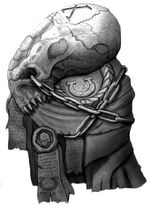
1st Company Relic
- 1st Company Relic - When the Ultramarines lost their 1st Company during the defence of Macragge against Hive Fleet Behemoth, it was a terrible blow to the Chapter and it took them many years to fully recover. Deathwatch Watch Captain Prascus of the Jericho Reach is known for carrying around a small, rent piece of armour from their last stand. He claims that the memory of those Battle-Brothers' sacrifice emboldens him in combat. Inspired by Prascus’ devotion, many Ultramarines serving in the Jericho Reach have begun carrying such tokens. Such relics steel the Battle-Brother's will against the influence of the Tyranids, as they remember the price paid by their brothers and struggle harder to resist.
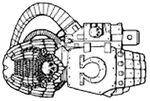
The Gauntlets of Ultramar
- Gauntlets of Ultramar - Amongst the oldest and most revered of all Ultramarines' artefacts, the Gauntlets of Ultramar are a pair of unique Power Fists with integrated Bolters. Legends say that the Gauntlets were taken by Primarch Roboute Guilliman himself, after defeating a mighty Chaos Champion in hand-to-hand combat during the Gamalia Reclusium Massacre of the Great Crusade. These weapons come from a source unknown and no Techno-magos has ever succeeded in penetrating their armoured shell to examine the mechanism within. The Gauntlets are only worn by the Master of the Ultramarines himself, the Lord Macragge, and at other times reside within a crystal case in the Fortress of Hera, inside the Temple of Correction's Shrine of the Great Primarch.
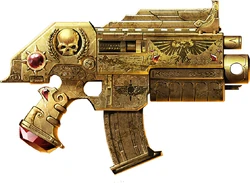
The master-crafted Guilded Bolter
- Gilded Boltgun - Among the oldest and most stable of all the Chapters, the vaults of the Ultramarines are well stocked with some of the finest examples of Imperial weaponry known to exist. One example is the Gilded Boltgun, a master-crafted Artificer weapon of unsurpassed beauty and artistry; a weapon fit for a Sector Lord, or a Space Marine Captain. No record remains of how this weapon made its way to the Jericho Reach, but it has been used by some of the most heralded Ultramarines to serve in the Reach with the Deathwatch.
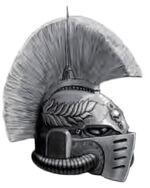
Helm of Varthion
- Helm of Varthion - Sergeant Varthion is a legend at the Deathwatch's Watch Fortress Erioch in the Jericho Reach. Long before Warmaster Achilus ever dreamed of conquest through the Jericho Reach's Warp Gate, the Deathwatch kept vigil over this ancient artifact. In the fourth century of the 41st Millennium, Varthion and his squad destroyed a xenos warhost hundreds of times their number in defence of the Gate. Records conflict as to which side of the Warp Gate originated the enemy assault, but accounts of the aftermath in the control structure are identical. They describe alien corpses of an aspect uncatalogued before or since, “in such volumes that Varthion’s squad stood atop them like Titans astride a demolished hive.” The Ultramarine Sergeant’s ancient helm contains the pinnacle of augury sensors and prophesier readouts. A dedicated Cogitator bank also provides tactical recommendations based on thousands of standard years of compiled Ultramarines combat theory.
- Heraldry Scrolls - Scrolls worked into a Battle-Brother’s armour, either as metalwork or a placard are popular in many Chapters, and the Ultramarines are no exception. This crest may display a motto or title, but most commonly it bears the Ultramarine’s name so that his enemies know who brings their deaths, and tales of his deeds may travel.
- Honour Blades - Presented to champions of the Chapter, Honour Blades are a matching Broadsword and Poniard Power Sword set. Wielded together, the blades are perfectly matched and provide the champion with an expert defence and attack.
- Hood of Hellfire - The Hood of Hellfire is a specially modified Psychic Hood that not only provides protection against the psychic assault of other psykers, but allows Chief Librarian Tigurius to conserve his body's energy, enabling him to make use of his powerful offensive psychic abilities more often than is normal for even the most powerful of human psykers.
- Infernus - Chaplain Ortan Cassius bears the master-crafted Combi-Flamer/Bolter called Infernus. This weapon was crafted and modified by Cassius himself. The Bolter portion of Infernus is loaded with Hellfire rounds instead of standard Bolter ammunition.

Jaw of Bloodcharn
- Jaw of Bloodcharn - The Jaw of Bloodcharn was theChainsword wielded by Tactical Squad Sergeant Kuriel during the war for a vital Agri-world in the Ango Sub-sector. Sudden attacks by dark-armoured Chaos Space Marines brought death to Kuriel’s captain and the sergeant stepped into his place to take command of the Ultramarines strike force. As the conflict escalated, Kuriel coordinated his efforts with allies from the Red Wolves and Sons of Orar Chapters, showing outstanding leadership ability. He was subsequently elevated to the 1st Company and his promotion to the rank of Captain was only prevented when he volunteered to join the Deathwatch. His weapon is the mark of a great commander and is often given to an up-and-coming Ultramarine slated for eventual officer status.
- Legatine Axes - Created to the specifications of Guilliman himself after a comprehensive study of thousands of individual power weapon designs from across the many worlds of humanity, the Legatine Axes' design is that of a precise and perfectly balanced instrument of war. Requiring great skill to master, the weapons are swifter to wield than most power axes, but lack the brute destructive force of many of their kind, relying instead on the skilful placement of blows to inflict maximum harm. These finely-wrought master-crafted weapons were often presented to the elite warriors of the Suzerain Invictarus.
- Mantle of Suzerain - This special suit of Artificer Armour worn by Captain Cato Sicarius provides a level of protection that rivals that of a suit of Terminator Armour. The left pauldron of this armour belongs to the original suit of Mark II Crusader Pattern Power Armour worn by Captain Orar of the 2nd Company, a great hero of the Ultramarines Legion during the Great Scouring of the Traitor Legions from Imperial space after the end of the Horus Heresy. It bears the 2nd Company's heraldic colours which Sicarius has also adopted as his own personal heraldry and also incorporates an Iron Halo and a golden Aquila that designates his position as the Grand Duke of Talassar, his homeworld in the Realm of Ultramar.
- Mantles of Ultramar - These suits of artificer armour, believed to number only seven, are said to owe their origins to a pre-Age of Strife derelict human warship found floating on the borders of the Seyrn Reach area at the very edge of the eastern galactic fringe. The ship and all it contained were claimed as prizes by Chapter Master Theokista Weir at the outset of his disastrous counter-invasion of the Khrave-haunted Reach, a campaign which would ultimately cost his own life and the lives of close to 4,000 of his fellow Ultramarines. These ancient suits of void battle plate, hybridised for use by the Legiones Astartes, have since shielded the lives of many of the Legion's greatest warriors. Ten millennia ago, they were awarded only by the hand of the Primarch, now they are awarded by the current Chapter Master. They have come to symbolize sacrifice, unfailing service and the adherence of duty unto death to the Ultramarines Legion.
- Rod of Tigurius - Chief Librarian Tigurius wields the Rod of Tigurius, an extremely potent master-crafted Force Weapon that draws on Tigurius' own psychic energy and focuses it into a tight beam of unstoppable power.
- Talassarian Tempest Blade - Wielded by Captain Cato Sicarius in close combat, this Power Sword's energy field is so strong that in certain instances it can slay a foe with a single strike.
- Urion's Doom - Urion was an honoured member of the Ultramarines 1st Company at the time of the invasion of Ultramar by Hive Fleet Behemoth. He was stationed at the Northern Polar Fortress during the Battle of Macragge. He fought on the outer wall until it was overrun, his Storm Bolter reaping a heavy toll amongst the Tyranid horde. He defended the silo doors of the fortress until they were breached, mowing down countless more bioforms. He battled in the catacombs as the surviving defenders fell back deeper and deeper. He fired burst after burst, each one finding its mark, until at last his ammunition was spent, when he charged into hand-to-hand combat and was finally overcome. His recovered Storm Bolter, Urion's Doom, is now a relic of the Chapter given to a member of the 1st Company who has particularly distinguished himself in combat with the Tyranids. As such, it is usually granted to one of the Chapter's Tyrannic War Veterans.
- Vengeance Launcher - Wielded by Captain Titus, this unique weapon fires explosive mines that generate a gravitic field, able to stick to foes before exploding. The Vengeance Launcher is a prototype weapon constructed on Forge World Graia, not yet sanctioned for use off-world.

The Hammer of Macragge
- Hammer of Macragge - A potent and revered relic of the Ultramarines Chapter, the Hammer of Macragge is a millennia-old Thunder Hammer that has long remained aboard the Reclusium of the Battle Barge of the Ultramarines 2nd Company in a shrine of honour. The Hammer of Macragge has been wielded against foes of the Imperium of Man for many millennia, and it contains powerful ancient technology that is little understood in the late 41st Millennium. The 2nd Company's Ultima Squad swore their battle pledges on the Hammer shortly before their deployment to the Shrine World of Mithron which had come under assault from the Forces of Chaos, including the Chaos Space Marines of the Black Legion. Later, Battle-Brother Proteus confronted a daemon inside the Reclusium of the 2nd Company's Battle Barge and tore the Hammer from its reliquary, using it to banish the daemon back to the Warp, before it could use the Imperial Fists artefact recovered from Mithron, the Liber Mithrus, to open a Warp portal on Macragge itself.
Chapter Fleet

A pair of Battle Barges of the Ultramarines' Chapter Fleet
Space Marine Chapters usually possess 4 or 5 Battle Barges in their Chapter fleets, but the Ultramarines can field up to 10 currently if it draws on moth-balled naval stores as the Realm of Ultramar depends on the Chapter for sector naval protection rather than on a sector battlefleet of the Imperial Navy. The Master of the Fleet for the Ultramarines is Captain Lazlo Tiberius, an Astartes and one of the heroes of Macragge.
- 10 Battle Barges (including those lost or destroyed):
- Adsidus
- Aeternus
- Caesar
- Emperor Incarnatus
- Faith's Pyre
- Honour's Fist
- Icon of Faith
- Imperator Rexelius
- Infernus Iconus
- Lord Laomedon
- Pro Merito (Lost to the Warp)
- Octavius
- Seditio Opprimere
- Severian
- 15 Strike Cruisers, including:
- Accipiter
- Fidelis
- Garra de Macragge (Macragge's Claw)
- Internecio
- Iter Splendere
- Vae Victus
- Valin's Revenge
- 20 Escorts
- 75 Thunderhawk gunships
- The following vessels were a part of the XIIIth Legion's fleet during the Great Crusade and Horus Heresy eras (many were destroyed, others became part of the Ultramarines Successor Chapters' fleets):
- Macragge's Honour (Gloriana-class Battleship) - Flagship of Primarch Roboute Guilliman and the XIIIth Legion
- Aegis of Occluda (Unknown Class) - Severely damaged during the Battle of Calth.
- Antipathy (Cruiser) - Destroyed during the Battle of Calth.
- Antrodamicus (Grand Cruiser) - Destroyed during the Battle of Calth.
- Antropheles (Troop Transport) - Destroyed during the Battle of Calth.
- Burnabus (Escort) - Suffered catastrophic damage during the Battle of Calth.
- Campanile (Fleet Tender) - Destroyed during the Battle of Calth.
- Cavascor (Unknown Class)
- Constellation of Tarmus (Unknown Class) - Destroyed during the Battle of Calth.
- Cornucopia (Unknown Class)
- Courage of Konor (Carrier) - Destroyed during the Battle of Calth.
- Deliverance of Terra (Unknown Class) - Destroyed during the Battle of Calth.
- Gauntlet of Glory (Battle-Barge)
- Gauntlet of Power (Battle Barge)
- Gauntlet of Victory (Battle-Barge)
- Gladius (Escort) - Destroyed during the Battle of Calth.
- High Assent (Unknown Class)
- Hope of Narmenia (Battle-Barge) - Destroyed during the Battle of Calth.
- Janiverse (Frigate) - Destroyed during the Battle of Calth.
- Jeriko Rex (Fast Escort) - Suffered catastrophic damage during the Battle of Calth.
- Johanipus Artemisia (Carrier) - Destroyed during the Battle of Calth.
- Lutine (Unknown Class)
- Menace of Fortis (Unknown Class) - Destroyed during the Battle of Calth.
- Mlatus (Unknown Class)
- Mlekrus (Strike Craft)
- Remonstrance of Narthan Dume (Battleship) - Destroyed during the Battle of Calth.
- Samothrace (Unknown Class)
- Sanctity of Saramanth (Heavy Destroyer) - Destroyed during the Battle of Calth.
- Solonim Woe (Unknown Class)
- Sons of Ultramar (Battle-Barge) - Destroyed during the Battle of Calth.
- Spirit of Konor (Battleship) - Destroyed during the Battle of Calth.
- Stations of Ultramar (Picket Cruiser) - Destroyed during the Battle of Calth.
- Steinhart (Carrier) - Suffered catastrophic damage during the Battle of Calth.
- Suspiria Majestrix (Grand Cruiser)
- Tarmus Usurper (Unknown Class) - Suffered catastrophic damage during the Battle of Calth.
- Testament of Andromeda (Carrier) - Suffered moderate damage during the Battle of Calth.
- Triumph of Iax (Unknown Class) - Crippled during the Battle of Calth.
- Ultimus Mundi (Battleship)
- Valediction (Carrier) - Destroyed during the Battle of Calth.
- Vernax Absolom (Unknown Class)
- Vospherus (Carrier) - Destroyed during the Battle of Calth.
- Chronicle (Unknown Class)
- Glory of Fire (Unknown Class)
- Legendary Son (Unknown Class)
- Nova Warrior (Unknown Class)
- Praetorian Trust (Unknown Class)
- Triumph of Espandor (Unknown Class)
- Unbroken Vigil (Unknown Class)
Chapter Appearance
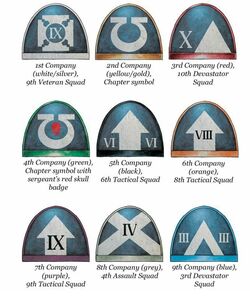
Examples of the Ultramarines' Company Heraldry
Chapter Colours
The Ultramarines typically paint their Power Armour and vehicles a medium (Ultramarine) blue, and their symbol is an inverted white Greek letter Omega. The Ultramarines also utilise black-and-yellow chevrons, usually on weapons such as Power Fists. They also incorporate the double-headed Aquila (the Imperial Eagle - especially seen in command and elite squads) in their armoury. They also have a gold (shining gold) trim on their Aquila. Their shoulder armour trim colour varies depending on the company the Space Marine belongs to, with the 1st Company being trimmed in white, the 2nd Company trimmed in gold, etc. (see above). Apothecaries of the Ultramarines keep the blue armour but have their hands, shoulder guards and backpacks painted white. They have a white vertical stripe painted down the centre of the helmet. Some Apothecaries have their armour white throughout with a blue shoulder plate (white trim).
Chapter Badge
The Chapter badge of the Ultramarines is a large, white Omega letter drawn from the Greek alphabet, representing the concept of ultimate perfection, centred on a field of blue.
External links
- Wargame Tactics for Space Marines - A site for Ultramarine Tactics.
Sources
- Apocalypse: War Zone Damnos (6th Edition), pp. 7-24
- Chapter Approved 2001
- Codex: Black Templars (4th Edition), pg. 6
- Codex: Space Marines (7th Edition), pp. 4, 6, 8, 12, 14-15, 20, 25, 27-32, 77, 81, 83, 88, 96, 98, 100, 104, 106, 114, 116, 118, 121-141, 205-208, 212-214, 220-222, 224-225, 227, 233-235, 251-264, 290, 293, 297, 299, 302, 305, 311, 314, 316, 320, 323, 326, 328, 330, 335, 337, 339, 342, 345, 348, 350, 352, 354, 356, 358, 360, 362, 364, 367, 369, 371, 373, 375, 377, 380, 382, 384, 386-389, 391, 393, 395, 397, 399, 401, 403, 405, 407, 409, 411, 413-414, 419
- Codex: Space Marines (6th Edition), pp. 8, 16, 20-33, 47, 59, 77, 89, 105-110, 128-141
- Codex: Space Marines (5th Edition)
- Codex: Space Marines (4th Edition)
- Codex: Tau (3rd Edition), pp. 58-60
- Codex: Tyranids (5th Edition), pg.14
- Codex: Ultramarines (2nd Edition)
- Deathwatch: Core Rulebook (RPG), pp. 53-54, 200
- Deathwatch: First Founding (RPG), pp. 67-73
- Deathwatch: The Jericho Reach (RPG), pg. 138
- Deathwatch: Rites of Battle (RPG), pg. 237
- Final Liberation: Warhammer Epic 40,000 (RPG)
- Horus Heresy - Volume II: Visions of Darkness
- Horus Heresy: Collected Visions
- How To Paint Space Marines
- Index Astartes III, "Warriors of Ultramar - The Ultramarines Space Marine Chapter"
- Imperial Armour Volume Two - Second Edition - War Machines of the Adeptus Astartes, pg. 80
- Imperial Armour Volume Nine - The Badab War, Part One, pg. 127
- Imperial Armour - The Horus Heresy - Book One: Betrayal, pp. 80-81
- Insignium Astartes: The Uniforms and Regalia of the Space Marines
- Warhammer 40,000 Rulebook (6th Edition)
- Warhammer 40,000 Rulebook (5th Edition)
- White Dwarf 309 (US), "Painting Showcase: Ultramarines", pg. 82
- White Dwarf 264 (AU), "Index Astartes - Ultramarines"
- White Dwarf 263 (US), "Index Astartes - First Founding: Warriors of Ultramar - The Ultramarines Space Marine Chapter", pp. 18-25
- White Dwarf 208 (US), "Faith and Vengeance: Space Marine Chaplain Background and Tactics", pp. 78-86
- White Dwarf 185 (US), "Lord Macragge, Master of the Ultramarines", pp. 7-12
- White Dwarf 119 (US), "Space Marine Painting Guide", pp. 32-39
- White Dwarf 103 (US), "Rampaging Rhinos", pg. 65
- White Dwarf 97 (US), "Index Astartes - Ultramarines" by David Wise & Rick Priestley, pp. 39-49
- Battle for the Abyss (Novel) by Ben Counter
- Garro: Oath of Moment (Audio Book) by James Swallow
- The First Heretic (Novel) by Aaron Dembski-Bowden
- Betrayer (Novel) by Aaron Dembski-Bowden
- Dark Heart (Novella) by Anthony Reynolds
- Mark of Calth (Novel) by Nick Kyme
- Rogue Trader series of novels:
- Rogue Star (Novel) by Andy Hoare
- Star of Damocles (Novel) by Andy Hoare
- Savage Scars (Novel) by Andy Hoare
- The Ultramarines series of novels:
- Nightbringer (Novel) by Graham McNeill
- Warriors of Ultramar by Graham McNeill
- Dead Sky, Black Sun by Graham McNeill
- The Killing Ground by Graham McNeill
- Courage and Honour by Graham McNeill
- The Chapter's Due by Graham McNeill
- Iron Warrior (Novella) by Graham McNeill
- Catechism of Hate (Novel) by Gav Thorpe
- Leviathan (Novella) by Graham McNeill
- The Enemy of My Enemy (Novella) by Graham McNeill
- Chains of Command (Novella) by Graham McNeill
- The Fall of Damnos (Novel) by Nick Kyme
- Fate's Masters, Destiny's Servants (Ebook) by Matt Keefe
- The Heraclitus Effect (Ebook) by Graham McNeill
- Legends of the Space Marines (Anthology), "Consequences," by Graham McNeill
- Rules of Engagement (Audio Short) by Graham McNeill
- Eye of Vengeance (Audio) by Graham McNeill
- Warhammer 40,000: Space Marine (Video Game)















